










PLUS: Arable| Grain | British Lifestyle | Energy| Mental Health|Show Reviews|Farm Safety|Livestock INSIDE: Show news from YAMS, Dairy Tech and LAMMA! - Pages 58-71
New Amarok is finally here
134-135 Also inside this month..
The
Pages:
Farm machine of the year 2024
Steiger Quadtrac 715
February 2024 316 02 £4.95 Farming Farming MONTHLY National February 2024
WomeninFarming




OurpartnersatHydroxSystemshavedevelopeda in-enginehydrogenproductionsystemthatcanbe usedindaytodaylifetodecreaseyourfuel consumptionbyupto35%andcarbonemissionsby 80%.Whetherinyourpetrolordieselcarortractors andtrucksonthefarm.Ifinstalledin4tractors,1 machinewillbeworkingwithoutanyfuelcostsallyear round.Thatisalargesavingthatcouldhelpyourfarm seepositivecashflowwheretherewaspreviouslycost.
AbeeffarmerinWinkleigh,DevonuseshisJCBFastrac4220anaverageof1,000 hoursperyear.Hespends50%ofthetimeintransportandtheother50%inheavy loadwork.Heaverages25.8litresperhourwhilstintransportand31.3duringheavy loadwork.At500hoursayearthatis12,900lontransportand15,650lonheavyload work,totalling£22,840inyearlyfuelcostsat80ppl(AHDB,Jan2024).Acrossthe 12,000unitscurrentlyinstalledinEuropetheaveragefuelsavingsare22%withthe highestbeing30-35%.Belowisabreakdownofthepaybackfrom10-30%usingthe fuelcostsfromourcontractorinDevon.



Forordersandinfo:info@pfc-eu.com victor:07523270710 Office:01805603363






TheUK’sNo.1LimingProduct Save£££’sonfertiliser thisyearwithLimeX P2O5 -9kg/t MgO-8kg/t SO3 -7kg/t www.limex.co.uk Customerservice 08000902376 LimeXisabusinessofBritishSugar Scanforquote


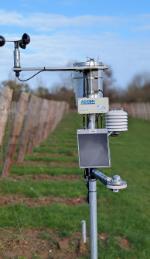













Farming FEATURES CONTENTS February 2024 ATV 130 Motors 134 Machinery 112 News 6 Muck & Slurry 106 Livestock 94 Energy 78 Farm Safety & Security 92 Grain 44 Mental Health 72 Dairy Tech review 64 YAMS 66 Potatoes & Root Crops 52 British Lifestyle 50 Tyres 126 Buildings 90 Arable 26 LAMMA 2024 review 58 REGULARS FM National Women in Farming 76

EDITORIAL











Farming Subscribe today! Call us on 02476 353537 or visit our secure website at www.farmingmonthly.co.uk Available in DIGITAL & WEB For editorial, general enquiries or to advertise please call +44 (0) 2476 353537 or email sales@farmingmonthly.com
Monthly National is published monthly in the UK by Farming Monthly Ltd, Tel: +44 (0) 2476 353537 Printed in the UK
part of this magazine may be reproduced without permission from the publisher.
every attempt is made to ensure accuracy, the opinions expressed in the magazine are not necessarily those of the Editor or publication. The Editor also reserves the right to alter or edit material as required and no responsibility is accepted for inaccuracies. Full copyright applies. All rights reserved. ISSN 2044-0190 (print) ISSN 2044-0200 (digital) Agriculture. Covered.
editor@farmingmonthly.com
Farming
No
Whilst
EDITOR
ENQUIRIES editorial@farmingmonthly.com
ENQUIRIES
+44 (0) 2476 353537
DIRECTOR Shona Beedham shona@farmingmonthly.com ACCOUNT EXECUTIVE Jennifer Mills jennifer.mills@farmingmonthly.com
subscriptions@farmingmonthly.com PRODUCTION production@farmingmonthly.com Front cover credit: Volkswagen UK Farming Farming MONTHLY National Kawasaki Brute Force enjoys major updates for 2024 KUHN launches KARL its future autonomous concept
ADVERTISING
Tel:
ADVERTISING
SUBSCRIPTIONS
The importance of getting the Sustainable Farming Scheme right cannot be underestimated, says FUW President
Farmers’ Union of Wales President, Ian Rickman, has written to all members urging individuals and businesses to formally respond to the Welsh Government’s Sustainable Farming Scheme (SFS) consultation and to make their voices heard.
“We need only look at the statistics from the Farm Business Survey to understand the significance of agricultural and rural development funding to our food supply chains and the wider rural economy.
“This is the third and final consultation on the SFS proposals and the importance of getting it right cannot be underestimated.
“We have already spoken directly with over 1500 farmers at our local county meetings across Wales in recent weeks, and our team of farming experts have been pushing for changes and amendments to the Welsh Government’s plans over a number of years. This is a crucial juncture for Welsh agriculture and its future
farmers uptake will be minimal and everyone will lose outWelsh farmers, the environment, the public and ultimately the Welsh Government.
“There is a real worry that even under a scenario where scheme payments come nowhere near to compensating for the loss of the Basic Payment Scheme, there will be some farm businesses that will have no choice other than to participate in the SFS. This will, no doubt, place further pressure on farmers’ workload and mental health.
£400 million to comply with.
“The recent meetings at Welshpool and Carmarthen livestock markets made a clear statement about the frustration felt by many farmers. It illustrated the groundswell of concern with regards to the current situation and future direction of agricultural policy here in Wales.
“As a farmer myself I fully understand and comprehend the frustrations of many at these meetings. We need to ensure that we work together and that the voice of Welsh farmers is being heard by decision makers in Wales and Westminster. Both farming unions will be meeting with Minister for Rural Affairs, Lesley Griffiths, to discuss the way forward.
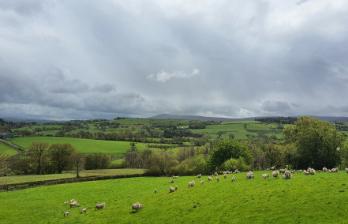

Modelling on the potential economic effects of the Sustainable Farming Scheme published alongside the consultation suggests:
• a reduction in farm business income of up to £199 million
• a reduction in farm output of £125 million
• 122,000 fewer livestock units
• an 11% decline in on-farm labour requirements.
“The reality is that if the scheme remains in its current form, and if the modelling report is correct,
“The Sustainable Farming Scheme must be accessible by all, and provide long-term stability for farming businesses and the wider rural economy that relies upon agriculture. The SFS needs to provide a meaningful income stream which properly rewards farmers and underpins the importance of a high quality food supply chain, produced here in Wales” said Mr Rickman.
The uncertainty around the future of agricultural support in Wales comes against a backdrop of continuous bovine TB breakdowns and the slaughtering of thousands of Welsh cattle every year. This is in addition to an all-Wales approach to bureaucratic pollution regulations which will cost the industry in excess of
“I cannot, however, overstate how important it is for every individual and business that will be affected by these proposals to formally respond to this consultation by the 7th of March. It is absolutely crucial that we all do so.
“I would also ask you to contact your local elected representatives at every opportunity, whether they are county councillors, local and/or regional Members of the Senedd or Members of Parliament at Westminster.
“We need to ensure that they also hear your voice and your concerns in order to ensure that we can continue to bring pressure on the Welsh Government to revise the scheme in a way that promotes a sustainable agriculture industry in Wales and safeguards it for the future.”
Farming | News
AHDB levy rate increases in four sectors receive Ministerialapproval
Levy rate increases proposed by the Agriculture and Horticulture Development Board (AHDB) for the Beef and Lamb, Cereals and Oilseeds, Dairy and Pork sectors have received approval from Ministers in Defra and the Devolved Administrations.
The new rates will be implemented from April 2024 and allow AHDB to maintain its focus on delivering the objectives set out in the Sector Plans, published in November 2022.
With no increase to the levy in the Beef & Lamb and Cereals & Oilseeds sectors for more than 10 years and no change in over 20 years for Dairy and Pork, the spending power of levy funds over the past decade has been reduced by up to 40%.
AHDB Chair Nicholas Saphir said: "We are pleased Ministers have approved the proposals, which will ensure the levy continues to supportthe work
AHDB has committed to prioritising forfarmers and processors across all the sectors we serve.
"The new rates will allow us to enhance our key activity whether,for example,that involvesgrowing export opportunities or exploring further marketing campaigns in the Beef and Lamb, Dairy and Pork sectors as well as increasing our research offering to Cereals and Oilseeds producers. "Levy payers can be assured that our commitment to helping them navigate through an unprecedented period of change for the industry is secure and we will continue to listen to their feedback to ensure we are delivering real value for money."
The Government has also agreed that Nicholas Saphir will serve a further 12 months as AHDB Chair.
The extension to Mr Saphir's appointment means he will remain in the role until 31 March 2025.

Farming | News
New Lake District Farming Officer is appointed
The National Park Authority has recently welcomed a new farming officer to join its team, tasked with supporting the Lake District farming community.
Claire Foster has moved to the Lakes from Yorkshire and brings with her a wealth of experience that stands her in good stead to hit the ground running in her new role, which she describes as a passion, not a job.
Claire has farming in her blood as she was brought up on her parents' tenanted arable farm just outside Leeds. She knew that she wanted to work in agriculture, so studied Sustainable Land Management at Askham Bryan College near York.
Catchment Sensitive Farming, as well as facilitating a farmer group in Upper Nidderdale and developing projects with the Nidderdale AONB (Area of Outstanding Natural Beauty) team and Yorkshire Water.
During her work as an independent farm adviser in Yorkshire, Claire has supported predominantly upland beef and sheep farmers to access many environmental grants and schemes. Added to this is seven years' experience as Farmer Coordinator for The Farmer Network, covering Nidderdale and the Eastern Yorkshire Dales. But she recognises that much of her working knowledge of upland farming is linked to her time spent living in Nidderdale, and her connection to Swaledale sheep.

Her farm adviser career started with a role at the Farming and Wildlife Advisory Group (FWAG), based at Thirsk. It was this job that took Claire into Nidderdale, where she lived for 12 years, working on a variety of projects including
She said: "Although it's sad to leave the farming community of Nidderdale where I have spent the last 12 years supporting farmers there and living at the very centre of this community on a beef and sheep farm, I felt the time was right for a new challenge.
"I'm looking forward to getting out and about meeting Lake District farmers and attending shows and shepherds' meets to get to know more about Lake District Farming methods and learn about this incredible landscape.
"I know the Lake District is very different to the upland areas I have previously worked in, particularly with commoning and fell farming and their respective challenges. But I know that many farmers are facing an uncertain future, and I am ready to learn fast and work hard to be able to improve this outlook."
Claire joins the farming team as the Farming in Protected Landscapes grants programme goes from strength to strength. The funding has helped 161 projects already and there'smore than £1.4 million still available in the Lake District National Park before the end of the programme in March 2025.
Through this programme the National Park wants to meet the needs of the farming sector during the agricultural transition and reach farmers in the greatest need. The team wants to support more farm clusters working together to secure food production, support nature, address climate issues and protect cultural heritage.
For more information on the Farming in Protected Landscapes visitwww.lakedistrict.gov.uk/fipl
Farming
Newly appointed Farming Officer Claire Foster (left) who joins Farming Assistant Eliza
| News
Inflation and cost of living put long term resilience of farming under pressure in 2024
Long term resilience in farming will be challenged amid cumulative inflationary pressure and the ongoing impact of the cost of living on consumer demand.
The latest Agriculture and Horticulture Development Board (AHDB) Agri-market Outlook has highlighted cumulative inflation of more than 30% in agricultural inputs since 2019, coupled with market stresses and policy uncertainty, as the key drivers behind the threat to long term resilience in the industry.
It also revealed markets, food businesses and consumers are still battling with the ongoing challenges of inflation, fuelled by the energy crisis, the war in Ukraine and shortage of labour. Recent developments in the Middle East also represent additional risk to the global economy and UK inflation.
Farmers are likely to feel the effects of cumulative inflation in inputs. Combined with energy and interest rates, this is continuing to pressure businesses and consumers, fuelling an ongoing price-sensitive consumer market for their produce. This has the potential to significantly impact trends in food consumption in 2024 and beyond.
Sarah Baker, AHDB Head of Economics and Analysis, said:"Farmers saw input costs rise significantly during 2023, putting pressure on farm business margins with the cost of fertiliser being a prime example. While some input costs are falling, they remain above pre-inflation levels and are likely to remain risky due to linkage to energy markets and instability around the world. Coupled with market stresses and policy uncertainty aroundburgeoning environment schemesand the budgets that underpin them, long term resilience will be put under pressure.
"With the current level of uncertainty on multiple fronts, markets, businesses, and consumers are now operating in a short-term bubble which poses a risk to long term resilience and inward investment. Without long term certainty and the recovery of consumer confidence, challenges are likely to persist for the industry in 2024."
AHDB's Agri-market Outlook examines the factors likely to affect farm businesses, helping levy payers plan and budget for what may lie ahead. The analysis features detailed market outlooks for each levy-paying sector covered by AHDB's remit - beef & lamb, dairy, pork and cereals & oilseeds. It examines trends in farm business inputs and consumer demand.
Key findings include:
Beef:
• Cattle numbers remain finely balanced in 2024 with concern over the long-term direction of the national suckler beef herd – driven by production economics, access to land and agricultural policy
• AHDB will be conducting further in-depth analysis
of the beef supply base this year
• Some optimism for some discrete volume demand increases but will be sensitive to consumer finances and competition from other proteins
Lamb:
• Slight declines in domestic production, from limited expansion in the lamb crop, and contraction in the breeding flock due to general industry uncertainty
• Pressure from imports with large price disparity with the Southern Hemisphere and increased tariff free access with Australia. Exports will decline in line with lower domestic production, as the EU remains our key destination.
• Falling domestic demand continuing to cause concern as consumers are squeezed by the cost of living. However, key seasonal events such as Easter and Eid, could see improvements
Pork:
• No recovery in the herd or production expected, with competition from chicken causing demand challenges
• Small uplift in trade with potential opportunities in US and Mexico alongside competitive EU imports.
• Fall in feed prices will bring some relief, depending on how much decline in grain prices is seen in finished feed costs.
• Escalating straw costs present a risk through 2024
Dairy:
• There are green shoots of recovery with commodity prices starting to build, but the approaching spring flush will drive market direction
• Demand continues to be muted, a little growth coming back into retail, but China continues to disappoint in import demand
• Falling fertiliser and feed costs will help, but higher straw costs should be expected through 2024
Cereals and Oilseeds:
• A massively challenging autumn and winter has disrupted crop areas for harvest 2024 with markets anticipating that the UK will need to be a net importer of wheat
• AHDB will be updating estimates of crop areas for 2024 in mid-March
• While crop prices have returned to pre-inflationary levels, fertiliser costs remain above the 'normal' levels
• Recent falls in commodity prices are a cause for concern for profitability and cash flow. Lower fertiliser prices have helped, but they remain above pre-inflationary levels
Farming | News
New Silotite Film Uses Recycled Content for Improved Environmental Credentials
Berry Global’s leading balewrap brand, Silotite, has added a new film made with 25% post-consumer recycled plastic (PCR) to its B Circular Range of agricultural films. SilotitePro1800 Sustane incorporates PCR into a high-performance product to deliver a quality silage film with an improved environmental profile.
The use of recycled content in SilotitePro1800
Sustane film is part of Berry’s Five-Pillar programme to improve Silotite’s sustainability and adds to the existing benefits of its preorientated ProTechnology. The film also provides a longer reel length than Silotite® original 25 μm, 1500m film, so customers can wrap more bales per reel, saving time and preserving silage quality.
By using recycled content, Berry is supporting the circular economy and helping to divert waste from landfill or incineration. Life cycle analysis data confirms that using SilotitePro1800 Sustane 23 μm film (with 25% PCR) reduces the environmental load by 24% compared to standard Silotite® 25 μm film (with 0% PCR)*.


Additionally, SilotitePro1800 Sustane film has been certified by RecyClass, giving users full traceability to the origin of the recycled content. The product is also conveniently packaged in a polyethylene (PE) sleeve, allowing the balewrap and outer packaging to be recycled together and eliminating the need for separation.
“We are proud to continue offering customers a range of films that meet highperformance standards across quality, functionality, user experience, innovation, and sustainability. The introduction of SilotitePro1800 Sustane film, alongside the other initiatives in our five-pillar sustainability programme, achieve these aims,” said Bart Geeraert, Commercial Director of Berry Global’s European Agricultural Films business.
Learn more about SilotitePro1800 Sustane
*This was calculated using the equation in the Circular Stretch Film Project Life Cycle Analysis (LCA) from Materials and Packaging Research & Services (MPR&S), published 26th February 2021.
Farming | News
Royal Bath & West Show: A grand celebration of rural life
When summer returns so will the Royal Bath & West Show with three full days of farming and foodies, activities and entertainment, music and family fun – a grand celebration of rural life.
Returning to the Bath & West Showground near Shepton Mallet, Somerset, on 30 May to 1 June 2024, the show is doubling its efforts to showcase the region’s farming and food heart. “Somerset has a rich – and delicious – food producing history,” says head of shows, Jess Chiplen.
Discover the Future area will help bring farming and science to life, with lots of fun and interactive activities for the whole family. “Bridging the gaps that exist between people, farming, food, and the environment is a clear priority,” says Ms Chiplen.


“Take the 800-year-old tradition of cheesemaking; the county’s rich pastures are perfect for producing creamy milk from the dairy herds the land has nourished. And we have the age-old practice of cider making, with 156 apple varieties which have a connection to the county and its orchards.
“Farming and food have always been – and will forever remain – at the heart of our annual show.”
Never failing to draw crowds – farming or otherwise - an array of British, continental, and rare breed cattle, sheep, pigs, goats and heavy horse breeds will call the show home for its duration. All will be expertly exhibited and shown by the finest stockmen and women competing for top tier silverware and a spot in the Grand Parade.
And the family-friendly Lakeside Farm and

“It’s not only integral to our health and wellbeing, but also to the future prospects of young people and the custodianship of our beautiful countryside.”
Taking visitors from farm to fork, the Great British Kitchen will be serving up live demonstrations, with celebrity chefs taking ‘centre-stove’ and local produce the star of the show. And for those wanting to take home the taste of the South West, it will be welcome news that this year’s regional food and drink marquee has been expanded.
No county show would be complete without a full programme of showjumping, scurry racing and pony club games. Horsepower and adrenaline will also be full-throttle in the main ring, with Jamie Squibb’s team of professional motorbike riders performing extreme tricks and jawdropping stunts.
And there will be lots of dogs with the launch of a new area; Bark & West, featuring favourite dogfriendly stalls, dog shows and high-speed agility. “Visitors to the show will of course be treated to the usual mix of shopping aisles, curated show gardens, celebrity guests, art and a plethora of craft,” says Ms Chiplen. “Live music will be playing out across the showground with the hugely popular Pilton Tent vibing into the evening – and don’t forget to book your pitch for on-site camping. We can’t wait to welcome one and all.”
Advance tickets are on sale until 16 May - to book visit www.bathandwest.com/tickets
Farming | News
Farm seeks funds to reconnect people with food and nature in multi-million-pound project A
nature-friendly farm managed by the Soil Association Land Trust is seeking funds to deliver a multi-million-pound community hub to reconnect people, schools and businesses with food and wildlife.
TheBlack Barn Project atWoodoaksFarm, Hertfordshire,hasthe confirmed support*of two major funders:the National Lottery Heritage Fund andtheHS2 EnvironmentandCommunity Fund.
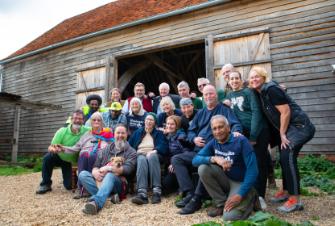

But it needs to raise a further £600,000 across 2024tocomplete the projectand is urging trusts and foundations to support the dramatic transformation the farm is undergoing.
The previously intensively managed farm was gifted to the Soil Association Land Trust in 2020 and with support from the community has planted 2,000 metres of hedgerow habitats as it converts to organic.
Although work is yet to start on building the hub, a programme of wildlife-focussed learning events –like butterfly spotting and bat listening sessions –are starting this month to pilot the experiences that the hub will offer when complete.
Woodoaks Manager Rose Lewis,of the Soil Association Land Trust, said: "Farming is often invisible to the public – they walk past huge fields of single crops and do not necessarily understand the negative impacts this has on nature.
"This funding will totally change that. We already work with an amazing team of volunteers and are starting to run exciting projects such as open days, tours, birdbox building and hedge planting.
"Being so close to London, Woodoaks is often the first chance for younger visitors to see farm animals
and nature up close – plus they can meet our team of growers, rangers and wildlife experts.
"We get so much joy from people experiencing things for the first time – children and adults love digging in the soil to find worms, observing red kites in the sky, or seeing Saturn through a telescope."
Education on nature-friendly farming
Previously growing just three crops, Woodoaks now educates locals on nature-friendly farming and grows more than 30 crops with sales directly to the public starting last year for the first time in decades.
The farm will now be able to give more back to the community with the planned education hub project, which will renovate and repurpose old farm buildings for education and events, with the historic 16thcentury, Grade II listed Black Barn at its centre.
The Black Barn Project aims to establish the UK's very best outdoor classroom, develop an educational programme for local primary and secondary school children, and empower teachers and students to make pro-climate, nature and environmental choices.
Initial support* of £200,000 has been received from the National Lottery Heritage Fund,made possible by National Lottery players, in preparation for a full grant application of £1.6million to besubmittedlater this year.
Maple Cross JMI and Nursery School Headteacher Hannah Trickett said: "We're so lucky to have Woodoaks nearby. Connecting with nature is a vital part of education, and Woodoaks gives our pupils opportunities they can't get anywhere else.
"The children have loved the hands-on experience – if they meet their funding we can send larger groups, so more young learners get to enjoy these benefits.
"We're excited to get involved with their pilot schemes and to see this develop so future generations can access nature and farming." Further volunteer recruitment and a schedule of events to engage the local community, together with school visits, is now underway, with the building works expected to complete in two years.
Trusts, foundations and anyone interested in supporting the project can find out more and get in touch atwoodoaksfarm.com
Farming | News
Couple Highlight Importance of Working Safely with Livestock
Awell-known farming couple are looking forward to attending The Farmers’ Choir performance this month at Perth Concert Hall for a particularly poignant reason.
As well as being members of the Supporters’ Scheme run by agricultural charity RSABI, the couple are very grateful for the help they received from an air ambulance crew when a typical morning four years ago turned into a life-threatening situation.
In a video interview with RSABI, Carol and Richard Rettie share their experience in March 2019 when a bull panicked while being handled, saying they hope their experience will remind people to take a little extra time to minimise risks when working with livestock.
Carol, who runs a bull livery service with husband Richard, sustained very serious injuries – including five broken ribs and a lung puncture – and needed surgery to her eyes and ear after a typical day turned into a lifethreatening situation.
were brilliant. Given the discomfort Carol was in, there was no way she could have travelled to the hospital in an ambulance, and being flown there also cut down the travel time considerably on a busy Friday afternoon,” said Richard.
The couple are incredibly grateful for the medical support they received.
“I can remember the doctor who treated me on the way to Ninewells was so kind. I ended up being known as ‘the bull lady’ in Ninewells and I couldn’t have been treated any better by the doctors and staff there. I am so grateful to them all,” added Carol.


The couple are looking forward to The Farmers’ Choir concert, sponsored by United Auctions and compered by well-known farmer and comedian, Jim Smith, on Sunday 25thFebruary at Perth Concert Hall.
Less than 200 tickets are left and are available from Perth Concert Hall Box Office, priced at £20 plus booking fee, with funds raised going to RSABI and Scotland’s Charity Air Ambulance.
Recalling what happened that day, Carol describes the bull in question as one of the quietest she had ever handled but her very tranquil, normal working routine changed dramatically when she was blow drying him ahead of a visit by a prospective buyer.
“I’d washed the bull and was getting him ready for blow drying when things changed completely in just a matter of seconds,” said Carol. “All I did was flick the drier flex to get a little more length to work with but that simple action startled him leading to me dropping the hose of the blower.
“The hose then started to snake underneath him because I couldn’t turn it off which startled him even more and I got slammed into the side against the gate multiple times. I remember slipping down the gate and thinking, this is it, I’m not getting out of this.”
Fortunately, there was a split second when the bull turned, allowing Carol to get out but she doesn’t remember much after that, other than lying on the concrete unable to see and struggling to breathe.
Richard was feeding some cattle nearby when he heard Carol, ran round and immediately called 999.
“The air ambulance arrived shortly after and they
Carol and Richard are urging people to take an extra few moments to assess risks when working with livestock.
“Anything can happen within just a few split seconds,” said Richard. “Just try to assess situations to see if there’s a safer way you can do things and avoid putting yourself in potential danger, even if it's something you’ve done a hundred times. Just be careful, don’t do anything unless it's necessary and please don’t take a chance.”
RSABI offers free practical, financial, and emotional support including counselling services, delivered quickly after receiving the initial enquiry. Its free confidential support service is available 24 hours a day, every day of the year, by calling 0808 1234 555 (calls won’t show up on phone bills) or through a confidential webchat service, available on RSABI’s website www.rsabi.org.uk.
For more information about farm safety and the work of the Farm Safety Foundation please visit www.yellowwellies.org.
Carol and Richard Rettie’s interview with RSABI is available to watch here: https://bit.ly/3UwFHgG
Farming | News
Changes for farmers, gamekeepers and pest control businesses in new rodenticide stewardship report
In readiness for all anticoagulant rodenticide purchases being restricted July onwards to their use inside and around buildings only, the latest UK Rodenticide Stewardship annual report includes for the first time an explanation specific to rodent pest control of what constitutes a ‘building’.
Summarised from guidance in the report, this means a permanent enclosed structure with foundations, constructed from wood, brick, concrete or metal that provides protection from the elements and minimises access by non-target species that might otherwise consume rodenticide baits placed inside. Temporary or easily moved structures are not generally considered to be buildings.
From 4 July specifically, none of the five second generation anticoagulant rodenticides (SGARs) are allowed to be bought for use in open areas or waste dumps. The five active ingredients – brodifacoum, bromadiolone, difenacoum, difethiolone and flocoumafen –are sold under numerous brand names. Announced in June
2023, this restriction is designed to strengthen rodenticide stewardship and lead to reducing SGAR contamination in barns owls, the sentinel species for non-target wildlife.
In response to the report, the HSE-led Government Oversight Group (GOG) to which stewardship operator the Campaign for Responsible Rodenticide Use UK (CRRU) is accountable acknowledges that commitments made at the 2016 outset have been fulfilled. It confirms that UK Rodenticide Stewardship, still under review by the GOG, is considered by government to be ‘fit for purpose’.
Ongoing scrutiny also covers something of which the operator is acutely aware that there have been no reductions in any of the key environmental criteria. Four additional working groups, each containing government and CRRU representatives, have been set up to review rodenticide sales data, residues in wildlife, application of best practice and anticoagulant resistance.
Another major change covered by the report is that from January 2026, all buyers and users of professional rodenticide products
must hold an approved training certificate and, if this is more than five years old, membership of a stewardship-specific Continuing Professional Development (CPD) scheme. For the first time, this means farmers, gamekeepers and pest control technicians will have to be equally qualified.
Among results identified by the report, stewardship’s training function has now issued 41,000 qualification certificates to pest control technicians, gamekeepers and farmers. In the past year alone, downloads of CPD materials have increased by 40% to 29,000 items, and a video produced with the Game and Wildlife Conservation Trust, for example, had 15,000 viewings.
Point-of-sale audits of 661 premises found 1% failures, 17% qualified passes with only minor corrections, and 83% outright passes. Over the past three years, 37% of farmers report attending stewardship training or seminars, up from 24% when last assessed in 2020. Farmer awareness of CRRU increased markedly from 20% in 2020 to 74% last year, on a par with gamekeepers (75%) and closing on pest control technicians (93%).

Farming | News

LOOKING TO REVOLUTIONISE YOUR FARMING OPERATION?
In the ever-evolving landscape of agriculture, efficiency and reliability are paramount. Enter Awemak Agricultural Machinery, the game-changer that combines competitive pricing with unparalleled build quality to elevate your farming operation to new heights.
At the heart of Awemak's success lies its commitment to delivering value without compromising on quality. Unlike other brands that may cut corners to lower prices, Awemak takes a different approach. By leveraging advanced manufacturing techniques and sourcing high-grade materials, they offer machinery that withstands the rigors of daily farm life while remaining affordable.
But what sets Awemak apart isn't just its competitive pricing – it's the exceptional build quality that ensures longevity and reliability. Each piece of equipment undergoes rigorous testing to meet the highest standards, giving farmers peace of mind knowing their investment will endure season after season.
The impact of choosing Awemak extends far beyond the initial purchase. By investing in reliable machinery, farmers can streamline their operations, minimize downtime, and maximize productivity. Whether it's cultivation, grassland control, vinyard and orchard maintenance or pneumatic seed drills, Awemak equipment and its partners empower farmers to work more efficiently, ultimately leading to increased revenue. Moreover, the durability of Awemak machinery translates to reduced maintenance and repair costs over time. With fewer breakdowns and less frequent replacements, farmers can allocate their resources where they matter most, further optimizing their bottom line.
In an industry where every penny counts, Awemak Agricultural Machinery proves that affordability doesn't have to mean sacrificing quality. By choosing Awemak, farmers not only invest in their own success but also in the future sustainability of their operations.
Join the countless farmers who have already made the switch to Awemak and experience the difference firsthand. Revolutionise your farming operation today with Awemak Agricultural Machinery – where affordability meets unmatched quality




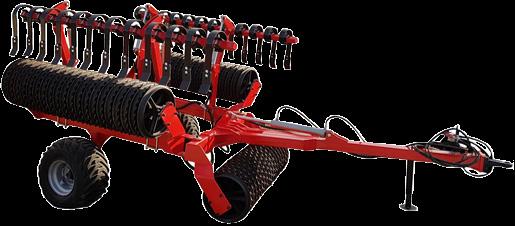



| News
For enquiroes and orders: info@pfc-eu.com Victor: 07523270710 Office: 01805603363 Ex-Demo 3m Flexi-Legs and Disc Cultivator combo £16,000 24 inch Cambridge Roller £15,000 5m Titan (stock item) £36,000 6m £40,000 Product Sample: For enquiries and orders:
SLE WELCOMES AGRICULTURE POLICY CO-DESIGN COMMITMENT FROM THE FIRST MINISTER
The views of all farmers and land managers in co-designing future agricultural policy must be taken into account for it to be a long-term success, Scottish Land & Estates said today.
The rural business organisation commented after several key commitments were made by First Minister Humza Yousaf in a speech at the NFU Scotland conference today.
The Scottish Government said it was to gradually return the missing £61million convergence funding to the Scottish agricultural budget. On future funding, the First Minister announced that from 2027, at least 70% of overall agricultural funding will be for tier 1 and 2 direct payments. The Less Favoured Area Support Scheme (LFASS) funding will also be reworked and be available from 2027.
Eleanor Kay, Senior Policy Adviser – Agriculture & Climate Change at Scottish Land & Estates, said:
"The First Minister has set out the allocation of future funding and this will increase the sector's confidence to some degree. However, we have repeatedly made the case for impact assessments and modelling data to be produced by government to explain the rationale for such changes and examine how changes to funding will have an effect. We still need to see this produced.
"Considering the challenges of biodiversity, climate change and food security, the Scottish Government must be clear on what balance it is seeking to achieve and how it will deliver a resilient farming sector. We welcome
the announcement that the government will continue to support high-quality livestock production – as long as it is sustainable production, we know it can form a key part of ecosystems and habitat restoration.

"We would also like to see Scottish farmers and land managers who are striving to deliver climate adaptation, mitigation and biodiversity work have access to other parts of the Scottish budget, not just through agricultural support. These are national targets and the efforts of farmers and land managers will benefit all of Scotland, not just within the realm of farming."
SLE added that improved communication with the sector remained key in the years ahead.
Eleanor added:"As we have said throughout this process, communication with all farmers and land managers is what is required to strike an achievable balance between food production, nature restoration and climate mitigation.
"We are pleased that the First Minister has committed to co-design and we hope the government remains true to its word on this. This includes clearer communication and open dialogue on difficult issues. This work cannot simply be left to a narrow grouping such as the Agriculture Reform Implementation Oversight Board (ARIOB)."
Government must take horticulture sector seriously or risk its future
The government’s response1to the House of Lords Horticulture Sector Committee Report does not adequately address the significant challenges facing the sector and misses the opportunity to grow our fruit, vegetable, plants and flower industry, says the NFU.
This is despite the horticulture sector being earmarked by the government at its Farm to Fork summit as an area for growth and a promise of a Horticulture Strategy within its own Food Strategy, published in 2022.
NFU horticulture and potatoes board chair Martin Emmett said: “The British horticulture sector is worth £5 billion to the UK economy, yet despite its own ambitions, much of the Government’s response seems to have missed the opportunity to grow the British horticulture sector.
“As an industry we are facing the third year of unprecedented and highly volatile costs of
production, together with supply chains that return little value back to growers. The recent Promar2report showed this is having a direct impact on growers with many business owners saying they are thinking about cutting production this coming season. The risk and lack of reward is simply too high.
“Having experienced shortages of some of the nation’s favourite fruit and vegetables in the past 12 months, and with ongoing global instability, our supply chain is fragile. We shouldn’t rely on imports to feed the nation. Instead we need government to match its own ambitions for the sector, alongside supporting our ornamental plant and flower businesses to achieve their environmental and biosecurity objectives.
“As a start, we need to give our British growers certainty by having a consistent plan for seasonal labour, including a five-year rolling Seasonal Workers Scheme, as well as sustainable returns and longer-term contracts with their key customers, the retailers and processors.”
Farming | News
Farmers from across Scotland look to the future in conference first
Nearly 200 farmers and speakers from across Scotland gathered in Edinburgh to discuss the future of farming at the first FAS Connect conference.
The key take-home messages included: build your farming system around your life and business aims – not the other way around; don't wait for disaster to start building a resilient farming system; and take time away from day-to-day tasks to work on the business as a whole.
FAS Connect groups bring farmers and crofters together to tackle the big problems with shared experience, ideas and knowledge. The group members work closely with a dedicated facilitator to tailor content to topics decided by the members - from beef to organics.
The event, hosted by the Farm Advisory Service at Murrayfield last week, brought together members of the 45 FAS Connect groups for the first time to hear three panel discussions covering the global outlook for agriculture, time and technology, and carbon and sustainability.
In addition, attendees had the opportunity to discuss the issues with other attendees and to field questions to the panellists.
Jennifer Struthers, event organiser from SAC Consulting – part of Scotland's Rural College (SRUC), said: "I'm delighted that the first FAS Connect Conference was a sell-out event. There were some great discussions and a brilliant buzz in the room, and we've already had excellent feedback from participants who thoroughly enjoyed their day."
Attendee Robbie Meikle, member of FAS Connect Group Sustainable Dairy Lanarkshire,said: "The diversity of the speakers was fantastic so I couldn't miss the opportunity to come and hear their opinions."
Another attendee Glen Neilson said: "It was great to listen about time management, to take a step back and think are we farming smart?"
Anyone interested in joining a FAS Connect group can visitwww.fas.scot/connectto find out more.


Farming | News
Thousands of applications made for improved Sustainable Farming Incentive
More than 10,000 farmers across England have now applied for the improved Sustainable Farming Incentive (SFI) since it opened in September, Defra has announced on Wednesday 14 February.
Four months after applications re-opened, the scheme, which has been developed with feedback from farmers, is proving popular, with one-in-eight eligible farmers having now submitted an application. This is on top of the 32,000 Countryside Stewardship agreements which are already in place.
SFI, which pays farmers for taking actions that support food production, farm productivity and resilience, whilst protecting and enhancing environment, has attracted applications from farmers in every part of the country, with every type and size of farm business represented.
Farmers have taken up actions through the scheme to deliver tangible environmental benefits alongside food production. As of January, 174,000 hectares of arable land is now being managed without insecticides, 71,000 hectares of low input grassland is focused on improving sustainability, and almost 15,000km of hedgerows are under management.
It comes as Defra also announces the winners of the‘On farm Environmental Resilience’ competition, with projects awarded a share of £12.2 million funding to solve long-term challenges to plants, crops and farmed animals.
Farming Minister Mark Spencer said:
“The Sustainable Farming Incentive has something on offer for every type of farm business, so it’s pleasing to see the scheme proving popular with farmers across England.
“For those who have not yet applied, I encourage you to take a look at how the scheme could work for your business so you can join the thousands of other farmers already getting paid.”
Rural Payments Agency Chief Executive Paul Caldwell said:
“We’ve worked hard to make the application process straightforward and the feedback we are getting from a majority of farmers is that they are finding it so.
“Everything that farmers need to apply has been published and I would urge them not to wait and get involved now.”
SFI has been expanded and improved based on farmers’ feedback, with a straightforward application process, greater flexibility for farmers to choose the actions that work for them, and the ability to be in SFI at the same time as Countryside Stewardship as long as the actions are compatible.
Today’s announcement follows the government’s announcement at the Oxford Farming Conference of thebiggest upgrade to the UK’s farming schemes since leaving the European Union.
This included around 50 new actionsthat farmers can get paid for across all types of farm businesses;a 10% increase in the average value of agreements in the Sustainable Farming Incentive and Countryside Stewardship driven by increased payment rates, with uplifts automatically applied to existing agreements;and a streamlined single application process for farmers to apply forSFI and Countryside Stewardship Mid Tier.
Farmers are encouraged to apply for an SFI agreement now and choose from the 23 actions already on offer, rather than delay until summer when the scheme will be expanded further. This is to ensure they can benefit from funding available now, and can then add actions to their agreements annually - or have multiple agreements - if they’d like to carry out further actions.
There is a range of support on offer for farmers applying or considering applying for the scheme, including:
• Sector-specific webinars in February and March to give farmers and land managers a chance to give their feedback and learn more about SFI.
• Defra and RPA colleagues will be on stands at agricultural shows throughout England
Farming | News
with more information.
• 6 regional events in Southwest, West Midlands and North East to raise awareness of schemes, especially amongst livestock and mixed sectors.
• Planned joint webinars with trusted networks including Catchment Sensitive Farming advisors, FAS, Barclays Bank, Waitrose.
• Defra attendance at NFU conference
• Ongoing monthly engagement with top 30 stakeholders through forums and bilaterals
Farmers can find out more about upcoming webinars and Defra regional events by visiting theFarming blog. Farmers can also access free business advice through theFarming Resilience Fund,or speak to the RPA through their Rural Payment Service helpline – 03000 200 301
Farming Innovation Programme ‘On farm Environmental Resilience’ competition
24 innovative projects that are developing cutting edge technology to future-proof British farms will receive a share of over £12.2 million to boost productivity, food security and sustainable farming practices, it has also been announced today.
The winners of the ‘On farm Environmental Resilience’ competition are using technology to tackle a range of long-term challenges to plants, crops and farmed animals including preventing potato blight, improving the wellbeing of farmed chickens, growing climate resistant hops and maximising grape yields in British vineyards.
The funding is part of Defra’s £270 million Farming Innovation Programme (FIP) delivered by Innovate UK. To date, the fund has committed over £140 million to support more than 170 projects across the country.
The successful recipients include a project which will boost food security by increasing the yields of fresh fruit and vegetables grown in greenhousesby 20%. The project is using pioneering sunlight changing materials todesign a new greenhouse which alters the ratio and amount oflight that plants receive, reducing theneed for extra LED lighting and saving electricity.
Another will develop a smart indoor lighting system that responds directly to chicken behaviour to help improve their welfare, reducing the spread of disease and boosting productivity. Meanwhile a third project is working with leading UK vineyard Rathfinny
Wine Estates to boost the production of high quality sustainable British wine through precision farming. The project will use technology to accurately andremotely monitor soil and water conditions, leading to better crop management.
Lambda Agri was awarded over £400,000 through the scheme to develop its pioneering new greenhouses. Its chief executive Niall Haughian said:
“Lambda Agri is delighted to receive funding from this particular Farming Innovation Programme competition which will allow us to undertake independent trials at a large scale. Lambda will develop enhanced polycarbonate sidings, in partnership with Queen’s University Belfast and Brett Martin, that will provide plants with extra red light which has been proven to increase crop yields.
“Lambda, in partnership with Brett Martin, will sell enhanced greenhouse sidings to growers next year. This will provide welcome boost to British greenhouses growers while also making the country more food independent.”
Klara Hajdu from Wye Hops limited, which was awarded over £475,000 to produce environmentally adapted hop varieties said:
“We are delighted to have received the Farming Innovation Programme funding which will allow us to develop new climate resilient hop varieties to support the UK hop and brewing industries.”
Innovate UK Executive Director for the Healthy Living and Agriculture Domain Dr Stella Peace, said:
"Funding across the innovation journey plays a pivotal role in enhancing productivity, ensuring food security and fostering sustainable farming practices. It's a commitment to cultivating a resilient and forward-thinking agricultural landscape."
The FIP has funded 20 competitions since opening in October 2021 helping to develop new approaches for farms to become more sustainable and productive, from new ways to reduce or eliminate pesticide use through to projects to reduce emissions from livestock. The fund will help meet the commitment made by the prime minister at the Farm to Fork Summit in Downing Street in May last year to continue to produce at least 60% of the food we eat here in the UK.
Farming | News
++++
Urgent need to support farm investment, says CAAV
The looming Spring Budget must do more to encourage farm investment, according to a submission to the Government by the Central Association of Agricultural Valuers (CAAV).
The 16-page document urges the Chancellor to consider a number of proposals to make farming more productive, efficient and able to adapt to current and future demands. The nine recommendations include an income tax relief to encourage letting of land and changes to inheritance tax to remove a bar to environmental uses. The paper also urges a review of capital allowances to stimulate investment in buildings, to help farmers adapt to climate change and invest in new technology.


“Our fundamental concerns are that the tax system supports farming in achieving a renewed pace of productivity improvement, and so contributes to economic growth and resilience,” said Jeremy Moody, secretary and adviser to the CAAV. “In practice, this means enabling the most proficient farmers to have use of the land and to support them in investing and innovating at this time of great technological advancement.”
Critically, farmers need to be able to invest in new technologies when it’s most appropriate to do so, to continue to improve buildings and structures, and adapt to the impact of climate change. While grant schemes are welcome, longer-term changes to the tax structure will enable better use of private money to achieve Rishi Sunak’s aims of greater capital investment in businesses, said Mr Moody.
Specifically, the CAAV has called for partnerships and sole traders to benefit from full expensing (writing off investment in plant and machinery against profits), which companies already have. If not, the Annual Investment Allowance should at least be increased in line with inflation, which has been 24.4% since January 2019, when the £1m limit was set.
It also argues that the Structures and Buildings
Allowance (SBA) is not fit for purpose. “Farm buildings are distinctive in the wear and tear they face, meaning they have shorter lives than found in other sectors,” said Mr Moody. “Obsolescence is also a factor with new technologies, increasing standards and regulation, and changing equipment.”
Rather than writing agricultural buildings off over 33 years, farmers should be able to write them off over seven years, as is the case in Ireland. “Such an approach would meet the aims of being both fair and stimulating the investment we need.”
Farmers also need to be able to adapt to climate change, and its resulting droughts, floods, storms and extreme heat. Investment in reservoirs, irrigation and rainwater harvesting systems is therefore essential, alongside flood management works, power systems to support farm operations, and controlled environment storage. “We ask that a class of capital allowance be created so that critical improvements that would ordinarily be within the SBA be treated as plant and machinery, meaning such investment can be written off in the year of expenditure,” said Mr Moody.
Investment in environmental improvement works should also qualify, including covered slurry stores and silage clamps, as should pig and poultry buildings and greenhouses, which are highly automated and can become outdated very rapidly.
“The urgent challenge of improving productivity, the need to respond and adapt to the impact of advancing climate change, and the scale of required environmental improvement are such as to warrant a new approach,” said Mr Moody. “Clear and simple stimuli within the tax system can be powerful levers for positive change.”
For more information visit www.caav.org.uk
Farming | News
Jeremy Moody
The value of Scotland's housing stock expands again, UK figure £1.585 trillion higher than pre-pandemic level
The total value of all homes across the UK now stands at £8.678 trillion (£8,678,000,000,000), according to new research by property firm Savills, with Scotland outperforming.
Faisal Choudhry, Head of Residential Research for Savills in Scotland said: "Scotland's housing sector remains robust and resilient, with the value of housing stock continuing to rise against a backdrop of a marginal dip in the value of UK stock.
Scotland's growth comes down to comparative affordability, the relative value gap between Scottish locations and those south of the border, with room for further growth a result. Scotland has remained in demand as a place to invest in property from buyers from all over the UK."
The analysis of the UK's housing stock reveals that the total value has fallen marginally on 2022 – when values peaked – but remains£1.585 trillion higher than before the pandemic (2019).
"Despite higher mortgage costs, the market's resilience means UK housing continues to be a significant, and a relatively secure, store of wealth. Even after deducting outstanding mortgage debt of £1.652 trillion, our figures show that net housing wealth continued to exceed £7 trillion; a figure 2.6 times the size of the UK's economy," comments Lucian Cook, head of residential research at Savills.
"In 2023 the total value was supported by an £80 billion uplift from new housing delivery. But, more fundamentally, the market was insulated from interest rate pressures by a combination of more stringent mortgage regulation, the increased use of fixed rate mortgages and the assistance provided by lenders to those in financial difficulty.
"We may see the cost of mortgages ebb and flow over the course of 2024, as markets respond to changing expectations of when and how much the Bank of England will cut the base rate. But over the medium term we expect affordability pressure to ease, meaning that the recent loss in value should be short lived."
According to Savills, the value falls, though relatively benign, were concentrated in the south. The total value of London's housing stock decreased by -£39.3 billion (-2.1%), while the South East, South West and East of England
saw a combined -£16.5 billion (-0.5%) fall.
By contrast, markets further from London which have a greater capacity for growth, saw values increase on the year. The most significant uplift was in Northern Ireland (3.2%), North East (1.4%), Scotland (1.3%) and the East Midlands (1.3%).
While London accounts for the largest proportion of the total value of UK housing, since 2016 it has only accounted for 12.01% of total growth. As a result, its proportion of the total value of UK housing has fallen from a high of 24% (in 2016) to a more normal 21% in 2023.
"A geographical rebalancing of the UK housing market continued in 2023," continues Cook. "As expected at this stage in the cycle, the most robust regional markets were those where mortgaged buyers had to borrow less in relation to their income."
Outright owner occupiers continue to be the major beneficiaries of value growth. According to Savills, homes owned outright now account for almost 40% of the total value of all UK housing.
The analysis shows that the value of property held bymortgage-free owner occupiers has increased by £1.505 trillion (£1,505 billion) over the past decade, while that held by mortgaged owner occupiers has risen by a lesser £978 billion.
"Back in 2013 the value of housing held by unmortgaged and mortgaged owner occupiers was very similar. However, demographic changes and a shift in access to home ownership have substantially widened the gap between the two in the last 10 years," says Cook.
"We continued to see people who benefitted from the homeownership boom of the latter part of the 20th century joining the ranks of the mortgagefree in 2023. But at the same time, aspiring homeowners had to contend with a combination of high deposit requirements and increased mortgage costs last year.
"Meanwhile increased taxation and regulation have constrained supply in the private rented sector housing, despite rising tenant demand," concludes Cook.
Farming | News
New date for AgriScot 2024
The UK's leading agricultural business event, AgriScot, has changed its date, bringing the event forward by one week to 13 November.
The Royal Highland and Agricultural Society of Scotland (RHASS) and AgriScot have been working in partnership for a number of years. The relationship is one of collaboration to ensure that AgriScot remains preeminent in the agricultural calendar. To do that working together is pivotal, and this year means a change of date for AgriScot to allow RHASS to support other events at the Centre. This allows RHASS to deliver on their charitable remit, which continues to support important agricultural events like AgriScot.
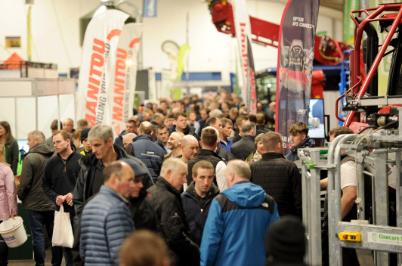

Robert Neill, AgriScot Chairman explained why the board have supported the request from RHASS.
"When RHASS approached us to review the date, allowing them the flexibility to welcome another organisation to utilise the space, the board, after much discussion, felt it was important to support the request and allow Scotland's longest-standing agricultural society the ability to generate further income to support their work."
Whilst AgriScot's core purpose is to deliver an annual agricultural business event, that brings together new products, services, and advice, for all sectors of the industry, AgriScot fully supports the value of charitable and community initiatives.
"Each year we support RSABI by offering them complimentary trade stand space at AgriScot and facilities to host their AGM as well as a platform to generate donations. We work with SAYFC to
support their Agricultural and Rural Affairs Committee, providing personal development opportunities. And we have a long-standing partnership with SRUC through our Business Skills competition, supporting mentoring and business skills development. In addition, we have supported individuals to complete studies and research that will benefit Scottish agriculture,"added Robert Neill.
AgriScot has now been running for over 20 years and during this time the board has actively looked to develop partnerships, such as that with RHASS, generating more opportunities for visitors by expanding the number of exhibitors, seminars and competitions as well as ensuring the event and car parking remains free.
The Royal Highland Centre offers a venue that is easily accessible for visitors and provides the ideal indoor space for a winter event.
Commenting on the decision, Mark Currie from RHASS said
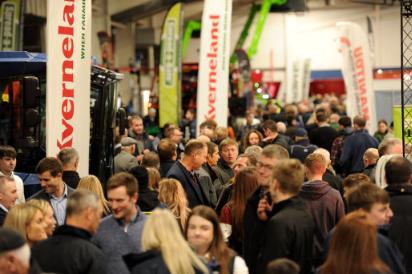

"AgriScot is one of the most important events in the Royal Highland Centre's annual calendar, and we want to do all we can to ensure the revised date is well communicated and does not impact the event in any way.
"The event is not only vital for agricultural businesses; it allows our industry to connect and network and brings to the fore some of the most important advancements and announcements within Scottish agriculture. Our thanks go to the event's Directors for supporting our request and we look forward to welcoming AgriScot back on 13 November 2024."
Farming | News
British cheese takes centre stage in Vegas

Dairy exporters have taken centre stage in Las Vegas to showcase world-class British cheese at an exclusive event for key buyers.
Sixteen exporters took part in the Agriculture and Horticulture Development Board (AHDB)-hosted British Cheese Night at the Foundation Rooms, Mandalay Bay Hotel.
The event, which coincided with the Winter Fancy Food Show, brought together exporters with existing and potential customers. It attracted more than 80high end buyers from hotels and retailers, chefs and distributors and included cheese displays and tastings, underlining what British dairy exporters have to offer.
exporters who took part and our ambition is for this year's event to replicate and build on that that success."
The US is the UK's second biggest dairy export market andAHDB analysishas highlightedfurther opportunities over the next decade with increasing levels of cheese consumption.

Lucy added: "There are considerable potential long-term opportunities in the US for the British dairy sector, building on our current successes in that market. AHDB is committed to working with industry to capitalise on those opportunities and our British Cheese Night has a key role to play in helping realise that ambition.

Lucy Randolph, AHDB Head of International Trade Development (Dairy), said: "Our British Cheese Night was a great success. This is the second year we have run this event which provides a fantastic opportunity for British cheese exporters to showcase their world-class products to high end buyers in this sought after venue. Last year's event helped deliver some significant business wins for
"Our aim is to grow the event to become the go to annual dairy showcase in the industry calendar for buyers in the US and help our exporters gain a stronger foothold in the US market."
Further details about export opportunities for UK dairy in specific regions around the world can be found in theAHDB analysis Prospects for UK agrifood exports.
Farming | News
British firm tries and fails to get EU to undo oxo-degradable plastics ban

ALondon-based material innovation company’s legal challenge to the EU’s ban on oxo-degradable plastics, which was implemented in 2019 due to pollution concerns, has failed.
Symphony Environmental filed a lawsuit at the Court of Justice of the European Union (CURIA), alleging that the ban is not compatible with existing business competition law and that, in designing the ban, legislators were misled over the lifecycle impacts of oxo-degradable plastics.
Oxo-degradable plastics are plastics designed to break down in open environments, landfills, industrial composting facilities, and water. Proponents claim that they do not result in microplastic pollution or toxicity, whereas the EU’s lawmakers heard prior to the ban that they only break down to a certain extent, leeching plastics into the environment.
Oxo-degradables are different to compostables. They are made from traditional plastics with prooxidant additives incorporated during manufacturing. Symphony Environmental’s product portfolio includes such additives.
CURIA’s General Court ultimately dismissed Symphony Environmental’s case. It ruled that the EU is within its rights to ban certain products in the
interest of protecting the environment and/or human health.
Lawmakers “did not make a manifest error” with the ban, CURIA ruled, noting that it acted on a wealth of scientific research available at the time casting doubt on the environmental impact of oxodegradables over their lifecycle.
Symphony Environmentalsaid in a statementthat “EU officials and politicians can ignore the rules and get away with it”.
It accused the EU of paying for expert evidence gamed towards outcomes that would support a ban and urged fresh environmental impact assessments to be conducted.
Prior to the EU-wide ban, oxo-degradables had already been removed from France, Spain, Switzerland and some other EU member states. Wales looks set to implement a ban by 2026 and the UK’s other nations may well follow suit.
The Ellen MacArthur Foundation has advocated for a global ban.It has the supportof more than 150 other organisations in this endeavor, including retail and FMCG giants, trade bodies, universities and other NGOs.
Farming | News
Teachers empowered withhands-on farm experience to enhance classroom learning
An interactive teachers' conference aimed at empowering them to enhance classroom learning,proved to be a resounding success.
Sixty-five teachers from various parts of the country participated in a hands-on workshop at Harper Adams University, gaining opportunities to engage in activities related to food production, science, and nutrition, ultimately enhancing their curriculum delivery.
TheFood – a fact of lifeconference featured workshops covering a range of topics and included a farm walk of the university's beef and sheep units, robotic milking dairy unit, and pig unit. Participants experienced ice cream production, bread production, and sensory evaluation of food products.
The event, delivered in partnershipby the Agriculture and Horticulture Development Board (AHDB) and the British Nutrition Foundation, included insightful sessions on nutrition, emphasising how breakfast impacts the dietary quality of children. It highlighted specific initiatives such asregenerative flour, alterative feed and nutrition, all aiming to contribute to the environment's well-being. It also informed teachers about the career opportunities available to their students in this sector.
The conference was well-received by the teacherswith 100% of them feeling more informed and saying it had given them ideas to take back to school and implement. Tracy, a teacher from Green Corridor, said she attended the event to make new connections, learn about sustainability, and pick up some practical skills. "It has been amazing," she said. "Welearnt about sustainability in wheat making, and I have some great ideas to take back
to the classroom. It has really been interesting."
AHDB's Head of Education, Roz Reynolds, said:"It was a great experience collaborating with the team at Harper Adams University to host our interactiveFood – a fact of lifeconference, together with the British Nutrition Foundation. Teacher training is a key part of our overall education programme, and we were thrilled with the turnout for this hands-on and immersive conference. Teachers really enjoyed the opportunity to learn firsthand from industry experts and see sustainable farming in action through the farm tour. We have received hugely positive feedback from teachers that the day provided new insights and ideas to boost their classroom teaching."
Lucy Catley, Senior Lecturer at Harper Adams University, added: "This has been a fantastic example of how organisations working together can achieve amazing things. We have loved the opportunity to meet food teachers from across the country who are as passionate about food education as we are. Our university's mission is the commitment to 'making a difference' and I really feel we have achieved that today."
Frances Meek, Education Services Manager, British Nutrition Foundation said: "We were delighted to work in partnership with AHDB and Harper Adams University to be able to offer teachers this valuable opportunity for professional development. As a former teacher myself, I know how important it is to get hands-on experience of a wide range of activities, as well as to be able to network with colleagues and experts in the field. Our hope is that the learnings teachers take away from the event will support them to provide even more engaging and up to date lessons for children and young people."




Farming | News
New Chair for quality assurance for Scotland's crops
FArable ife arable farmer, John Hutcheson, has been appointed the new Chair of the Board for Scottish Quality Crops (SQC), Scotland's quality assurance scheme for combinable crops, alongside new Vice Chair Mark McCallum.
John farms an extensive arable unit, growing cereals and oats in West Fife. He brings with him varied experience and perspective from running his own farming enterprise as well as his roles as Chair of Scottish Agricultural Organisation Society (SAOS), Chairman of Oat Co Group, a cooperative for oat growers in Scotland and the single largest supplier of Milling Oats into Quaker, and is a former Chairman of Tayforth Machinery Ring.


SQC, which was first established in 1994 and provides quality assurance for grain markets, is streamlined to have just one part-time employee, the Managing Director. Being underpinned by an experienced Board with strong leadership is critical to the success of SQC and ongoing support to our members, says current Managing Director, Teresa Dougall:
"We are looking forward to John and Mark taking the helm of the Board and leading SQC through its next phase of both opportunity and challenge. There is plenty of change and progress in our sector and we welcome the experience and insights they will bring as we ensure our assurance scheme remains fit for purpose and continues to secure access to the widest and most lucrative markets for our farmer members."
Teresa also thanked outgoing Chair, Andrew Moir, arable farmer and industry stalwart, who has steered the board for the last eight years. Andrew has also been Chair of AgriScot and of Ringlink, and steered the Farmer Led Group for Arable: "We've greatly valued Andrew's expertise and insights from working across the industry with NFUS, the Voluntary Initiative and other related posts, as well as his ground-up perspective as an arable farmer. I have also personally gained from his generous support and guidance when I took on the role as Managing Director at a time of significant change, including appointing a new certification body and the impact of Brexit and policy changes on maintaining fluid market access.

I'd also like to congratulate Andrew on being awarded this year's Ed Rainy Brown Award from SAOS in recognition of his many years of cooperation and collaboration within the agricultural industry. It's very well deserved, and we wish him all the very best for the next chapter."
Andrew was also involved, with Teresa and the Board, in undertaking a full review of the standards and creating a Scottish Crops Supply Chain Hub. This cross-sector group provides an interface with the industry on important issues and has proved a valuable mechanism for specialist constructive feedback from across the cereals supply chain to ensure the standards remain relevant.
Mark McCallum, who will take up the role as SQC Vice Chair, farms an arable enterprise comprising of the home farm and a number of contract farming agreements between Dingwall and Cromarty on the Black Isle. He is a former Chairman of the grain cooperative, Highland Grain, as well as growing for the coop, and, as current NFUS Regional Chair for the Highlands, will be one of the NFUS representatives on the SQC Board, which is made up of representatives from seven industry organisations.
The SQC assurance scheme was founded in 1994 as Scottish Quality Cereals, to give cereal producers the opportunity to place Scotland's cereals at the premium end of the UK and European markets. Changing its name to Scottish Quality Crops in 2007 to encompass all combinable crops, in 2020 the company became a stakeholder co-operative to maximise expertise and collaboration opportunities across the sector. John, who has been integral within the SQC Board for some time, says he is looking forward to continuing to strengthen SQC and its offering to farmer members and stakeholders:
"Quality Assurance and traceability, and increasingly evidence of sustainable farming practices, is essential for customers and the supply chain. SQC's overarching goal is to help growers gain market access and premiums for their crops by providing this. This is by ensuring that the standards meet the requirements of the widest and best markets, but it is also supporting growers through the audit process, taking a pragmatic approach to quality standards, streamlining and leveraging technology where we can, and continuing to place the farmer at the heart of the organisation."

Farming |


Keeping the depth. Always.
Cultus HD sets a new standard in the mounted tine cultivator segment. It is designed to never compromise n its exact depth precision and high field performance.
The heart of the machine is the new heavy-duty Cultus HD tines. With a release force of up to 680kg, Cultus HD will keep its depth in a full range of conditions.
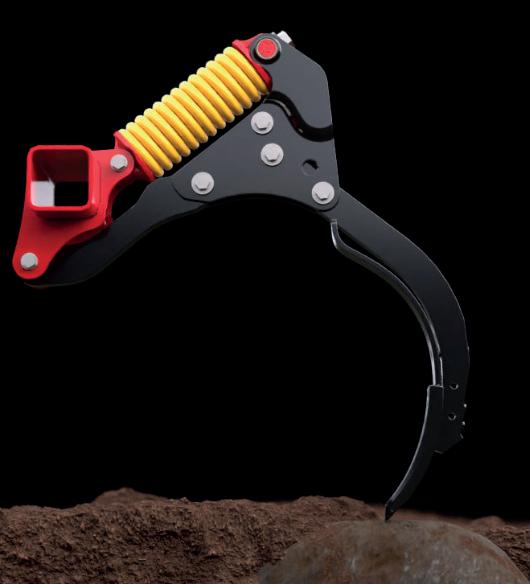
Learn more at vaderstad.com
Farming
Cultus HD The new Cultus HD 425-525
Where farming starts

KUHN launches KARL its future autonomous concept
KUHN has launched its autonomous concept KARL, a driverless solution aimed at arable crop production.
KUHN presented KARL at Agritechnica 2023 to gauge customer feedback on the design concept and to assess if KARL’s attributes meet the needs of progressive crop production systems.
Edd Fanshawe, KUHN’s product marketing specialist for arable and connected services says: “KARL is an autonomous solution dedicated to plant production which we are convinced offers many advantages. Field crop production is evolving significantly, with farmers aiming to lower soil compaction and reduce chemical inputs, while maintaining food supply. This focus will likely increase the number of operations, and agricultural robotics can help in a big way.”
KARL uses a hybrid diesel/electric power source with a 175hp Volvo engine running an electric generator. The drive of the tracks and implement is solely electric, which offers a smooth drive


engagement, along with the ability to make incremental adjustments to the implement. The implement has a level of intelligence to detect errors, blockages, and breakdowns by sending an alert signal to KARL if there are issues, something that isn’t possible with a conventional implement with no communication method.


A 2.5m HR 2520 e has been tested with KARL for several hundred field hours, with this width easy to load on standard trailers for transporting between fields without requiring additional licences. KUHN is currently exploring soil engaging and shredding implements, along with additional tools from KUHN’s portfolio, that can be available to KARL in the future.
“Although KARL isn’t ready for commercial production yet, we hope that a five-year timeframe is realistic as more field tests in real-world conditions take place over the next few years. KARL shouldn’t be considered a replacement for the tractor, but a different concept entirely, with the potential to run a fleet of KARL autonomous tools to adapt to different farm sizes and labour restrictions faced by farmers across the world,” concludes Mr Fanshawe.
Farming
| Arable
Claydon Drills receive prestigious ecological excellence award from the Suffolk Farming and Wildlife Advisory Group
Claydon Drills’ achievements in designing and manufacturing machinery which enables farming businesses to implement crop establishment solutions which are both commercially and ecologically sustainable has been recognised by the Suffolk Farming and Wildlife Advisory Group (SFWAG).
The organisation’s 2023 Peewit Award for Excellence in Ecological Farming was presented to Jeff Claydon, the company’s founder and Chief Executive, during a recent SFWAG-organised event celebrating exceptional approaches to sustainable farming.
Anna Beames, Chief Executive of SFWAG states: “At a time when so much discussion is taking place about the environmental issues which are impacting the world it is very pleasing to note that where farming was once regarded as a major part of the problem it is now rightly recognised as a key part of the solution. This was confirmed at the recent COP28 summit in Dubai, where global leaders acknowledged the profound potential of agriculture and food systems to drive powerful, innovative responses to climate change.
numbers of worms and staggering levels of soil organic matter. Worms may not be sexy, but they are the unsung heroes of the farming world and instrumental in changing soils for the better, so as one of their greatest exponents Jeff is a deserving winner of the Suffolk FWAG 2023 Peewit Award.”
SECURING THE FUTURE
“I am delighted to receive this prestigious award from Suffolk FWAG at a time when farming is under increasing environmental and economic pressures,” states Jeff Claydon. Jeff developed the Opti-Till® System in 2001 to reduce production costs without adversely impacting output, thereby securing the economic future of his family’s farm. Combining well-proven stubble management and direct seeding techniques, it enables farming businesses to operate much more efficiently, profitably, and sustainably.
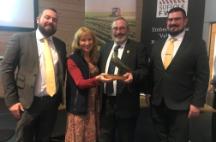

“The Suffolk Farming and Wildlife Advisory Group was born from farmers with a deep understanding of integrated farming which considers both the environment and wildlife, so we are keen to recognise those who actively seek to reduce the industry’s environmental impact. Our annual awards highlight exceptional examples of ecologically sustainable agriculture which restore, protect and create high levels of Natural Capital to deliver ‘public goods’ whilst profitably producing healthy, nutritional food.
“Our theme for 2023 was ‘Sustainable Farm Solutions’ and Claydon Drills is an extraordinary example of that. Because of that we were delighted to round off Suffolk FWAG’s series of farm walks last year with a visit to the Claydon’s arable farm at Wickhambrook in Suffolk. The farm has been in the Claydon family for nearly 100 years, with Jeff and his brother Frank farming there for more than 50 of those years; during that time the business has grown from 100ha to 250ha, plus 90ha which is contract farmed and some contracting.
“Soils are the farming industry’s greatest asset, yet many have been degraded to a point where now they merely provide a growing medium which depends on high levels of artificial inputs to maintain productivity. Jeff addressed this key issue more than two decades ago by developing the Claydon Opti-Till® System, a holistic approach to crop establishment which delivers consistent, high-yielding crops at low cost for maximum profitability. Crucially, it also enables farmers to become more ecologically sustainable.
“During our visit to the Claydon farm we were able to see the massive improvements which this approach has brought about over the last 22 years, including high
Since launching its first drill in 2003, Claydon has relentlessly promoted the importance of excellent soil health and raised awareness of how to improve it. With more frequent extremes of weather, Opti-Till® is particularly relevant because it is effective in all conditions, minimises risk and provides sufficient capacity to exploit narrow weather windows. This allows all agricultural seeds which can be air-sown, from herbs and grasses to cereals and maize, to be drilled at the right time, in the right conditions and ultimately produce the high yields required to make farming businesses more weather and financially resilient.
Now the Claydon family’s main operation, Claydon Drills also involves Jeff’s sons Oliver (Operations Director) and Spencer (Commercial Director). Unlike many other companies in the UK farm machinery sector which import machinery made overseas, Claydon designs, tests and manufactures all its products from scratch, employs local staff and sources materials from UK suppliers.
Versatile, reliable, with a low power requirement and ownership costs, Claydon Evolution and Hybrid drills, Straw Harrows, TerraStar® light cultivators and TerraBlade inter-row hoes are manufactured to exceptionally high standards at the company’s factory in Wickhambrook, Suffolk, which employs over 70 staff.
European market leader in direct seeding technology, Claydon has seen demand for its products grow ten-fold since 2010. During 2023 the company experienced significant growth in sales as the business worked closely with its dealer and distributor partners in existing and new markets. With many markets still at an embryonic stage and its distribution network growing rapidly the company expects sales to continue increasing during 2024.
Further details about the Claydon Opti-Till® System are on the Claydon website (claydondrill.com).
Farming
| Arable
Irish growers gain access to proven wheat fungicide Univoq
Corteva Agriscience has announced that Univoq, one of the leading fungicides used to control septoria and rusts, is now available to wheat growers in Ireland.
Univoq has been widely used across Europe and the world and consistently proven its efficacy against key diseases, most notably septoria.
The product contains the Inatreq active molecule in coformulation with prothioconazle, optimised by Corteva’s patented i-Q4 formulation which enables Univoq to stick to, spread across, and penetrate the leaf’s surface.
Its robust activity on the main diseases found in Irish wheat fields means green leaf area is maximised, laying the foundations for greater yields.
Independent trials carried out by the UK Agriculture and Horticulture Development Board (AHDB) in 2023 showed, for the third year in a row, clear daylight between Univoq’s yields and those of the next closest competitor.
The greatest benefit of applying Univoq has been seen at the T2 fungicide timing, although many growers have also explored the benefits of the product at T1.
Liz Glynn, Corteva’s National Technical Manager for Ireland, said: “It’s really good news that Corteva is able to offer Univoq to wheat growers in Ireland this year following the great successes it has delivered in terms of disease control and yields across Europe.
“Many growers here will have already seen how effective the Inatreq molecule is having used it in our Questar, Aquino and Peacoq fungicide copacks which have been on the market since 2021.
“In Univoq we now have a one-bottle solution offering simplicity and ease of use, with the additional benefit of the i-Q4 formulation.”
Steven Kildea, Plant Pathologist at Teagasc, said: “We have seen in the field that Inatreq active is an excellent molecule when it comes to controlling septoria, which is much needed.
“We’ve seen actives disappear from the Irish grower’s toolbox but Inatreq came in and has really found a home for itself in fungicide programmes. Now, with Univoq, we will see the same efficacy in terms of disease control to help build yield, but it will be co-formulated into a single bottle which will appeal to farmers here.”
Growers have flexibility on the rates they choose to apply Univoq at, ranging between 1.5l/ha and 2l/ha depending on the disease pressure.
Inatreq active offers outstanding biology performance, and its novel target site for septoria gives farmers an important tool to help manage the disease, as it shows no cross-resistance to existing cereal fungicide chemistries. Farmers also will benefit from its flexible application characteristics and consistent, broad-spectrum performance.
For more information on Univoq go to www.corteva. ie/univoq

Farming
| Arable
BSPB appoints policy specialist
The British Society of Plant Breeders (BSPB) has created a new role and appointed Dr Anthony Hopkins as head of policy. This reflects the BSPB’s need to strengthen its ability to represent plant breeders in response to the many policy challenges the sector faces. Dr Hopkins commented on his new role saying:
“Plant breeders and growers are operating in a difficult post-Brexit policy environment, especially in terms of how we work with our European partners. As supply chains tighten, we want to ensureUK farmers and growers have access to the best genetics possible and continue to benefit from the investment and innovation that plant breeding provides.”
Dr Hopkins joins the organisation from the NFU to work alongside head of business operations Stephanie Spiers. He was most recently chief crops adviser at the NFU, with a proven track record of securing improvements across a variety of issues affecting the arable sector such as access to crop nutrition and plant protection products.

“There are many challenges, but with the right policy environment the plant breeding sector offers enormous value to UK agriculture, domestic food security, and sustainability. I’ll be working to ensure this is recognised and supported by policymakers in line with the BSPB’s strategy, and the needs of our members,” says Dr Hopkins.
BSPB Chair, Robin Wood, commented on the appointment saying:
“I’m delighted to welcome Anthony to the BSPB. With his background in farming and agricultural policy, combined with a PhD in
political strategy, I’m confident he’ll ensure the BSPB has a strong voice in policy discussions.”
Dr Hopkins’ immediate priorities will include resolving trade barriers, providing long-term access of plant protection products, and securing vital seed treatments. Further focus will also be given to gene editing technology, which the BSPB has already been instrumental in securing via the Precision Breeding Act.
“I look forward to working with the BSPB’s members and other organisations across the agricultural and horticultural supply chain to maximise the influence we have,” concludes Dr Hopkins.
Farming
| Arable
Multiple weather station updates aid crop management decisions

Growers using Agrovista’s weather station services can now access a suite of new and updated on-screen features to help optimise crop management following an extensive overhaul of the company’s data platform.
Several hundred weather stations provided by Agrovista are in use across the UK. These measure a range of parameters including rainfall, air temperature, soil temperature, soil moisture, relative humidity, leaf wetness, solar radiation and wind speed, depending on which option growers choose (see box).
Each station provides location-specific data that is transmitted to a central server for processing, providing a range of high-quality weather-based information that individual growers can access via their own online dashboard on a range of devices.
This information includes live weather data, weather forecasts, crop disease predictions and irrigation management (in combination with soil moisture sensors).
The most obvious change is the new dashboard design, which presents a wide range of data in a cleaner, more accessible format via an app that works across different devices, says James Martin from Agrovista Weather.
“The modernised dashboard display will be especially useful for smartphone users, helping them to easily access all the information they need,” he explains.
Weather and disease forecasting for all crops including arable, potatoes, vegetables and fruit, as well as a forecast for spraying conditions, are now included on the same platform. “Before they were on a separate system – now we’ve embedded them, improving access,” says James.
Farming | Arable


Up-to the minute weather data helps growers to make immediate decisions, while detailed shortand medium-term weather forecasts aid planning.
These forecasts, along with additional measurements such as leaf wetness, are also used to model accurate disease forecasts for precise integrated pest management planning.
In addition, access to rainfall measurements in the local area for the past 24 hours and previous seven days provides a valuable overview for growers who irrigate.
“This is particularly useful for crops further away that are covered by a weather station,” says James. “Growers with moisture probes can also find out which areas require irrigation, and how much.”
The update also includes an irrigation probe dashboard with a soil forecast, indicating where moisture might be after seven days without rain. The dashboard also shows rain amounts, soil moisture levels and temperature measurements, as well as EC measurements for soft fruit growers.
“We are also working on water monitoring for irrigation pumps, so growers can record water usage and pressures within the dashboard,” says James. “We also provide a similar feature for polytunnel systems.”
New crop development indicators have also been introduced; growing degree days for all types of crops, growing degree hours for soft fruit crops and cooling degree hours for crops like blackcurrants that need a certain amount of chill over the winter. “Using these, growers can obtain thresholds for key management decisions and inputs,” says James.
The overall result is a more comprehensive tool that enables growers to connect swiftly and easily to their data, says James.
“It pools relevant data from different sources and delivers a lot more value for money, putting realtime weather insights into growers’ hands.”
Weather station package options
Starter – rainfall, temperature, relative humidity
Advanced – as above, plus wind speed and direction
Professional – as above, plus solar radiation
• All the above are expandable with additional sensors such as in-field soil moisture and temperature probes.
• For a free consultation or demonstration please email your contact details to james.martin@agrovista.co.uk
Farming | Arable
New data shows severity of brome
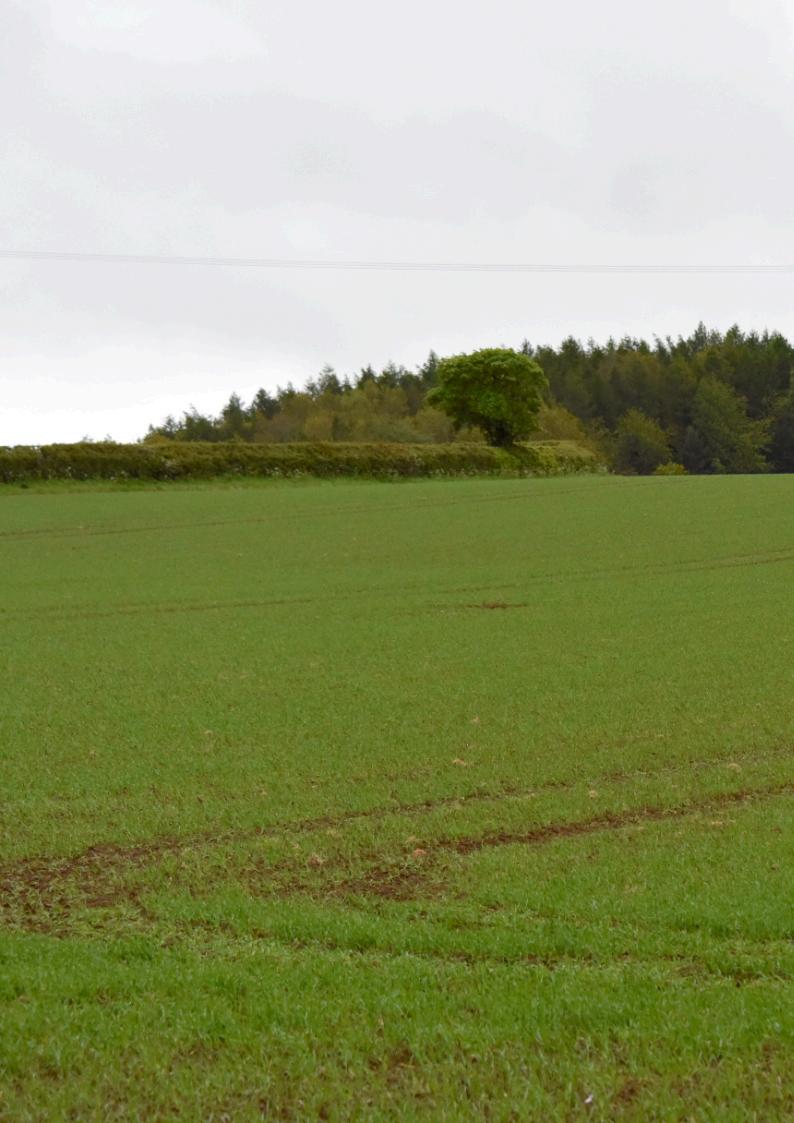
Hundreds of farmers, contractors and agronomists have indicated that brome is a growing threat in the battle against grassweeds in UK arable fields.
New data from a Corteva Agriscience survey shows that 80% of respondents have populations on their farms with the vast majority estimating it to be infesting up to 25% of their winter wheat area in 2023.
Cultural control methods such as rotational planning, delayed drilling and ploughing are being deployed on every farm involved in the research, and the brome problem has been shown to exist in all the main wheat-growing regions of England, Scotland, Wales and Northern Ireland.
Alister McRobbie, Cereal Herbicides Category Manager, said: “This work provides more clarity
on how widespread brome issues are and the various approaches being taken to reduce populations.
“Blackgrass is usually the grassweed which gets the most attention for understandable reasons, but brome has a similar potential to steal yield so can’t be ignored.”
Almost 250 of the 282 respondents said that up to 25% of their winter wheat area was infested with brome in 2023, with a small number of growers reporting up to 50%. Three-quarters were able to identify the species they have, with the most common being sterile followed by meadow, soft, rye and great brome.
Most farmers, agronomists and contractors said they didn’t know the resistance status of their brome, but the majority of the 30 who did said it had shown reduced sensitivity to ALS
Farming | Arable
brome concern for wheat growers
inhibitor herbicides such as Atlantis®.
The most popular herbicide used by growers to control brome is Broadway Star®, evidenced by 68% of respondents indicating it was their product of choice. A broad spectrum of weed control, effectiveness, and ease of use were the main reasons respondents said they preferred to use it.
“Broadway Star gives excellent control of all brome species, ryegrass and wild oats in winter wheat,” Alister said.
“It is also effective against a wide range of broad-leaved weeds. Used in conjunction with a residual herbicide programme, it provides robust control going into the key period of the growing season.”
A programmed approached was favoured, most commonly a pre-emergence application of products including flufenacet, pendimethalin,

tri-allate or DFF, followed by a contact spray. But it is clear that chemistry is always used in combination with cultural controls. Delayed drilling, shallow cultivation, grazing and crop rotation are the tools being deployed. Alister added that a busy spring period lies ahead for wheat growers and that they should be prepared for weed control applications to take place when conditions allow.
“For best results, always include a recommended adjuvant and always target weeds when they are small and actively growing, and don’t spray when it is cold as efficacy will be reduced,” he said.
“A good rule of thumb is that if the grass is growing and needs a cut, it’s probably suitable for applications of Broadway Star.”
To read the best practice advice, go to www. corteva.co.uk/products-and-solutions/cropprotection/broadway-star.
Farming | Arable
Farmers invited to test a new biostimulant made from seaweed in Wales P
roduction is set to begin this year on a natural biostimulant made from sustainably farmed seaweed off the coast of Wales – and farmers are invited to get involved in additional testing of the product.
Biostimulants are being explored by increasing numbers of farmers keen to transition towards a more regenerative farming practice.Câr Y Môr, Wales' first regenerative seaweed and shellfish farm, is to build a new seaweed processing facility this year at its site in St Davids, Pembrokeshire. It is inviting any farmers who wish to trial its Welsh-grown and made seaweed biostimulant to contactthemto join the trial, which will take place later this year.
Founded in 2019, Câr Y Môr is a Community Benefit Society (CBS). This business structure enables it to be owned and democratically run by its growing 260 members. Membership is open to all as it only costs £1. Câr Y Môr's mission is to improve the health of our planet and people by sustainably farming seaweed and shellfish on its ocean farms off the coast of Pembrokeshire, and selling sustainable Welsh Seafood products locally, online and across the UK. The addition ofseaweed biostimulantto their product range is key to bringing more benefits to all.



Initial research of seaweed biostimulants shows an average of 17% boost in crop yield (more details on the fact sheet accessed viathis web page), reducing dependency on costly synthetic fertilisers, and empowering your soil with enhanced resilience against abiotic stress – all while contributing to the UK's transition to lowcarbon agriculture.Câr-YMôr'sbiostimulant makes this a reality by tapping into the rich resource of farm-grown sugar kelp and oarweed, harnessing the ocean's nutrients through an energy-efficient process to nourish and invigorate the soil.
Câr Y Môr co-founderOwen Haines said: "Our seaweed biostimulant is not just a product; it's a promise to the land and to those who nurture it. As a sustainably focused, community-owned business
based in Pembrokeshire, West Wales, we provide a cutting-edge biostimulant derived from our zeroinput ocean farm located in grade A waters in the Ramsey Sound, off the coast of St Davids."
Owen hopes to inspire farmers and other agricultural experts to work with Câr Y Môr to trial the biostimulant and discover how best to use the biostimulants to improve crops, the land, and sea ecosystems.
Farming | Arable
Photo: Arthur neumeier
Photo: Arthur neumeier
Photo: scott chalmers
Farming Innovation Programme award to explore vital role of soil microbiomes and move towards greater sustainable agriculture in the UK
Eagle Genomics, announces an award from DEFRA’sFarming Innovation Programmeto explore the vital role of soil microbiomes as part of a move towards greater sustainable agriculture and net zero food production to feed the planet’s growing population.
This award – to be delivered in partnership withInnovate UK’s Transforming Food Production (TFP) Challenge– prioritises solutions for farmers and growers to facilitate improved arable farming, productivity, sustainability, and resilience with less impact on the environment.
By leveraging science fromRothamsted ResearchandCABI– as well as novel data analysis and insights using Eagle Genomics’ innovativee[datascientist]platform – this two-year feasibility study advances an understanding of arable soil and farming practices to promote regenerative farming.
It is being delivered underDEFRA’s Farming Futures: Environmental resilience, Feasibilityfunding – worth £391,347 – fromInnovate UK.
The project will utilise soil from sites in the ASSIST farm network, which are also included in the BBSRC fundedUK Crop Microbiome Cryobank project, as well as Rothamsted long term experimental fields. It also builds on Rothamsted’s past research in understanding biological, physical, and chemical elements of soil health.
Dr Yvonne Pinto, Director of Strategy, Innovation, Sustainability and Bioeconomy, Ag Bio at Eagle Genomics, said, “Eagle Genomics will analyse data signatures between different agricultural practises and link these to develop a barometer for soil health, while CABI will biobank these samples for provenance.”
“This will increase understanding of the effect of different agricultural practices on the functionalities of healthy and poor soil indicators.”
These outputs will directly benefit farmers in the UK, providing indicators of soil health status and guide the transition to more sustainable and restorative agriculture.
Dr Tim Mauchline, Plant and Soil Microbiologist at Rothamsted Research, said, “Soil Health testing laboratories have the appetite to use these signatures to provide more detailed analysis to guide farmers decision making. This will enable the provision of specific practical advice to farmers to improve their
resilience, to increase soil carbon, increase biodiversity and water retention and potentially with additional revenue streams.”
In the UK roughly 84% of fertile topsoil has been lost since 1850 due to highly mechanised farming systems causing compaction, erosion, and sub optimal plantings. Soil microbiomes drive critical functions in agro ecosystems, including soil fertility, crop productivity and stress tolerance.
Soil degradation was calculated to cost £1.2B a year in 2010. System-level agricultural management practices can induce structural alterations, thereby changing the microbial processes at the micro-scale.
These changes have large-scale consequences, such as soil erosion, reduced soil fertility and increased greenhouse gas emissions. Currently, the major soil health indicators are categorised into three groups: physical, chemical, and biological.
The important work, as part of this collaboration, will significantly advance soil microbiology as an important component of the soil health continuum and enable practical strategies for farmers to conserve and regenerate their soils.
Dr Matt Ryan, Research Lead, Biological Resources at CABI, said, “These valuable crop microbial samples are a vital resource for scientific researchers investigating how to ensure food security amid a range of challenges to crop production that also includes the threats posed by pests and diseases.
“Advancing research on solutions to mitigate these stressors is also imperative to help ensure the UK’s food security at a time when chemical fertilizers and pesticides are in the spotlight amid the growing concerns of climate change.”
Professor Martin Broadley, Science Director, Sustainable Soils and Crops at Rothamsted highlights, “Rothamsted Research is delighted to be partnering with Eagle Genomics and CABI, to support this exciting project to develop practical indicators of soil health status. Applying recent advances in our understanding of soil biology, to enable the development of ‘next generation’ soil tests, will help farmers and the wider agriculture sector in delivering profitable and healthy agricultural systems.”
Victoria Kimonides, Eagle Genomics’ CEO added“The output of this project is instrumental in developing models and providing advanced services to organizations that enable them to understand, monitor, and be proactive in addressing climate change and its impact on agriculture”.
Farming | Arable
Bayer herbicide Emerger approved for use in pulses
Emerger, the pre-emergence residual herbicide with activity against a range of common broadleaved weed species, can now be applied in field beans (winter and spring) and combining peas. The authorisation does not include vining peas.
The news will likely be welcomed by growers given the low number of pre-emergece herbicides authorised for use in these crops, explained Richard Phillips, Bayer campaign manager for roots and horticulture crops.
“As the only aclonifen product on the market, the authorisation for Emerger in peas and beans means growers have access to a herbicide with a broad-spectrum of activity. Its novel mode of action – HRAC group 32 – will also support efforts to promote resistance management,” Mr Phillips says.
Among broad-leaved weeds, Emerger offers good activity on fat-hen, redshank, black bindweed, mayweeds, charlock, chickween and poppy as well as moderate control of black-grass (from seed).
“Emerger is primarily absorbed by the shoot of germinating weeds, this is advantageous in dry weather conditions such as those that typically occur in the spring when seeking to establish spring crops,” Mr Phillips adds.

To promote all-round weed control and protect efficacy, Bayer will support Emerger in mixes with one other herbicide so long as minimum application rates are observed (see table).
“It is prudent to ensure Emerger is partnered with a product belonging to another mode of action group to support effective control and protect efficacy. Depending on the crop and the weed spectrum to be managed, we have identified those products and inclusion rates that give growers the greatest means possible of achieving the control they desire,” Mr Phillips says.
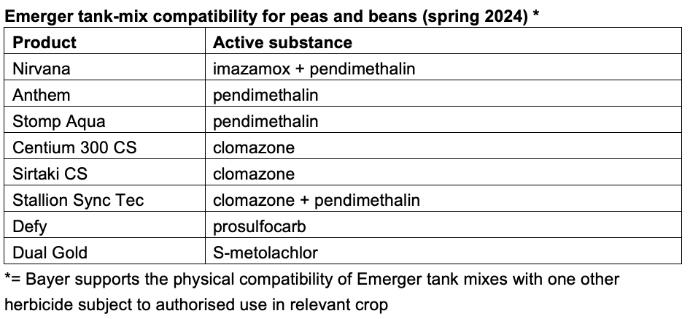
Farming | Arable
Avoid falling foul of the transition from winter to spring
As such, any crops drilled beyond this date will be defined by the CRD (the Health and Safety Executive’s Chemical Regulations Division) as spring-sown and must comply with the relevant crop protection regulations.
“Any crops sown on or after 1st February in the year of harvest are considered spring crops, irrespective of the variety being drilled,” explains Jonny Oosthuizen, Herbicides Product Manager for ADAMA UK.
“Unfortunately, because of the wet winter, a lot of growers throughout the UK still have winter wheat seed in the shed and, now that conditions have finally started to improve, are rushing to get as much of this into the ground as quickly as possible.
“What many might not be aware of as we move into February is that any crop protection products registered only for use on winter wheat can’t be used on crops sown after 31st January, even if the seed is technically a winter variety. Instead, these crops can only be treated with products labelled as being approved for spring-sown crops.”
This changing of the seasons narrows the crop protection options available to control fresh flushes of weeds.
“Some herbicides aren’t permitted for use on spring wheat, even if the actives themselves may be used via other products,” Jonny says. “That might come as a surprise to some growers, especially those who haven’t traditionally grown spring wheat before. Understanding the rules is therefore essential to ensure herbicide programmes don’t fall foul of the transition from winter to spring cropping.
“Fortunately, there are still plenty of options available to ensure spring-sown cereals remain protected and ahead of the curve in terms of weed competition,” Jonny adds. “For example, product’s such as HURRICANE (500 g/L diflufenican) and TOWER (250 g/L chlortoluron + 40 g/L diflufenican + 300 g/L pendimethalin) are approved for use on spring wheat and barley and have been proven to offer value for money as a reliable means of controlling some key grass and broad-leaved weeds. Likewise, ANTHEM (400g/L pendimethalin) is also approved for use on spring barley, although it is no longer approved for use on wheat drilled from 1st February onwards.”
If in doubt about which products can and can’t be used on or after 1st February, check each product label carefully to ensure it is approved for use on spring crops. Alternatively, seek professional advice from a qualified agronomist or visit www.adama.com/en for more information.

Farming | Arable
Five do’s and don’ts for managing 2024’s winter wheat disease control challenges
Wide variations in drilling dates, the aftereffects of the wet winter on crop growth, and the early appearance of disease are set to make winter wheat disease control challenging this spring, says a leading agronomist.

According to Mike Thornton, head of crop production for agronomy company, ProCam, crops will need managing very much on a field-by-field basis.
“Don’t let attention to detail slip with any crop,” advises Mr Thornton. “Just as much effort, if not more, will be needed to protect backward crops as normal ones to ensure further yield potential isn’t eroded.”
To help growers, Mr Thornton offers five key tips:
1. Do remember the importance of early disease management
While it might be tempting to ease back on early fungicide inputs if crop potential has been compromised by delayed drilling or poor winter growth, diseases are already present, says Mr Thornton, and a T0 fungicide provides a wider management tool.
“Yellow rust is already being found in crops, particularly in the southern half of the country, and it becomes more difficult to control later. Similarly, Septoria is easy to find in early-drilled crops.
“As well as targeting diseases present at application, a T0 fungicide provides a level of insurance in case the follow-up T1 fungicide is delayed. We saw this in 2023; in fields where T0 fungicides were omitted, Septoria exploded once the rains arrived in March.”

Farming | Arable
Watch for yellow rust this spring –it can be a particular problem in backward crops, says Mike Thornton, and difficult to control later if it gets out of hand
2. Don’t get caught out with spray timings
Accurately timing fungicide sprays to target the correct leaf layer that has emerged is essential for maximum yield protection, says Mr Thornton. But with drilling dates varying widely from September to February this season, and varieties having different speeds of development, crop growth stages will be all over the place, he notes.
“Don’t assume that just because one field has reached the correct growth stage for its T1 spray, for example, that its neighbour will also have. Fields will need checking individually – splitting stems to expose the developing leaves and counting back from the ear to identify which leaf layers have emerged.”
3. Don’t overlook the effects of crop stress
Backward and poorly-rooted plants, whether from later drilling or because they have sat in cold, waterlogged fields over winter, together with leaching of soil nutrients by the heavy winter rainfall, mean crops are likely to be under increased stress this spring, says Mr Thornton. This makes them more vulnerable to infection, he says, particularly yellow rust.
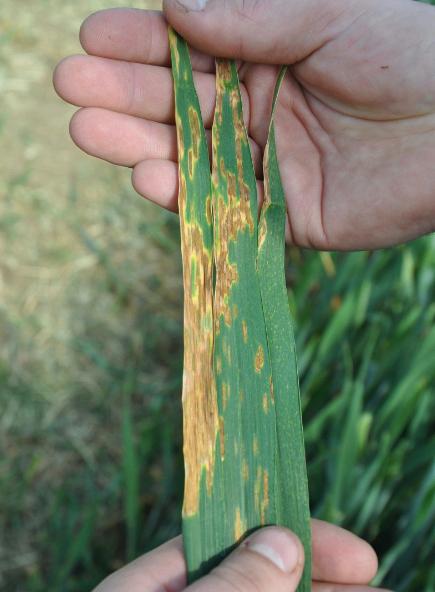
Septoria can easily be found in earlier-drilled crops, says Mike Thornton, and observations at ProCam’s trials hub in Yorkshire last season illustrated how earlier drilling increases Septoria pressure. Pictured left to right: Septoria on leaf two in September, October and December-drilled untreated wheat
“Use accurate soil testing to identify which nutrients need topping up. But don’t just test for the nutrient levels present in the soil. Use testing which shows the levels actually available to the plant. And consider a phosphite-based treatment such as Incite to encourage rooting.”
4. Don’t discount diseases not seen for a while
Just because a disease has not been a problem for a few years, do not assume it has gone away, says Mr Thornton. “The root-rotting effects of take-all could be exacerbated this year if second wheat has small roots because it has sat in wet soil. If we have a dry spring and summer, take-all effects are worsened.
“With more crop debris left on field surfaces due to minimum tillage, eyespot can also be
hidden a threat, which increases lodging risk. Several varieties chosen for their good Septoria tritici resistance have low eyespot ratings. Make sure you know what your varieties are susceptible to.”
5. Do keep your eye on the ball
Even varieties with good Septoria resistance, when drilled early, are at risk from the disease, says Mr Thornton, so don’t let variety resistance ratings make you complacent.
Similarly, last year’s hot, dry June brought sudden yellow rust outbreaks in some areas, he says, illustrating how disease pressures can suddenly change.
“The lesson is to ensure you have all likely disease threats covered. As a national company, we’re able to monitor disease development around the country. Having persistent protection from the fungicide is also important,” he adds.
Farming | Arable
Arable farmers need to rethink herbicide strategies following 2024’s wet start
With some fields still under water following widespread flooding in January, farmers will need a robust herbicide plan in place as they battle to catch up this spring. A wet autumn delayed drilling of many winter cereals, causing a backlog of fieldwork that will need to be fulfilled as quickly as possible.
Those who did manage to drill their wheat will also need to review their herbicide strategy following the bad weather.
“We’ve had a number of difficult seasons in a row, and each poses a new challenge for arable farmers,” says Corteva Agriscience’s Cereal Herbicides Category Manager Alister
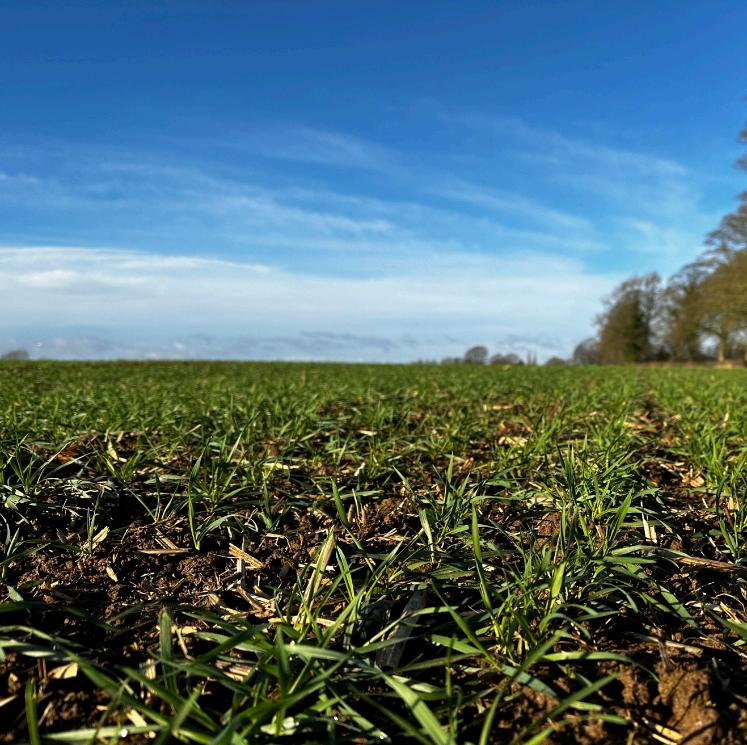
Farming | Arable
McRobbie. “The past couple of years have been very cold and dry, but we’re facing the opposite in 2024.
“Parts of the major wheat-growing areas of the UK are either under water or suffering from saturated soils, so it will be a while before there is any on-farm activity in badly-affected areas. “Those with a compressed fieldwork schedule should plan ahead, decide on their herbicide programme in advance, and make sure it’s in store ready to go.”
Those farmers who managed to drill wheat last autumn will also need to rethink their strategy

as it is unlikely they will be able to rely on the activity of their pre-emergence applications. “A lot of the wheat drilled would have received a pre-emergence herbicide, but there has been so much water it is likely this will have been washed through the soil profile,” adds Alister. “It won’t have worked very well, so there will be a need to control grassweeds such as brome, ryegrass and wild oats relatively early.”
The performance of autumn residuals will undoubtedly be impeded by the wet conditions, making a spring clean of weeds even more essential than usual.
Broadway® Staris a mainstay of spring grassweed control programmes and will be among the first products applied as soon as the opportunity to get sprayers working presents itself.
It gives excellent control ofbrome species,ryegrass,wild oatsand a range ofbroad-leaved weedsin winter wheat and also has approval for use in spring wheat. “Generally, we don’t recommend applying a residual alongside Broadway Star, but this season we would advise it – Broadway Star is contact only, so it will kill the weeds there at the time of application and a residual will remain in the soil and eradicate grassweed seeds as they are germinating, before they get too big,” Alister explains.
Broadway Star also controls a range of difficult broad-leaved weeds, including cleavers, charlock and cranesbill, so there is usually no need for a broad-leaved weed follow up spray. “If you just need to target broad-leaved weeds, it’s better to take them out early with Arylexbased products such as Zypar or Pixxaro,” Alister says. “Get this on in a timely manner and take weed competition out early to avoid them competing with the crop and negatively impacting yield.
“There will be a lot of demands on farmers’ time this spring but cutting corners and overlooking weed control won’t help in the long run.”
Tank mixing with plant growth regulators, fungicides and trace elements will help reduce the number of sprays applied to crops in the busy spring period. This will be especially helpful with the expected increase in spring drilling work. However, farmers should ensure they don’t neglect sprayer hygiene in order to avoid contaminating subsequent loads.
Farming | Arable
How To Save Up To 35% On Your Grain Drying Costs Every Year
Combine 4 key elements into your grain drier construction and functionality and you can save up to 35% on your operational drier running costs season after season. It’s very achievable when you use a Perry of Oakley Savannah continuous flow grain drier combined with some key additional options.
The savings come from combining Hot Air Recirculation, Insulation, Automatic Grain Moisture Monitoring and PLC drier control. Using these four options allows the drier to run automatically at the optimal hot air temperature and speed to achieve the correct moisture content of the grain (no over-drying), while also recirculating the hot air which keeps your fuel costs down.
So how does it work?

saves fuel due to minimising the temperature loss and therefore minimises the fuel required to achieve the necessary temperatures.
The Automatic Drier Moisture Monitoring utilises a Near Infra-Red technology that only requires calibration once a year (that’s a game changer in itself!). The moisture measurement is coupled with a self-teaching algorithm which makes the necessary adjustments to the drier temperature, fan speed and the discharge speed of the drier. This prevents the quite large financial losses associated with overdrying grain such as decrease in weight, extra fuel usage, labour and electricity, for example. This means big savings and peace of mind can be achieved.
The system has been developed in-house at Perrys, including the writing of the algorithm so all the support you may need is in the UK.
The Hot Air Recirculation reduces your drier fuel consumption by up to 24%. The grain drier fuel savings come from the reduction in the amount of fuel the drier consumes to heat the air to dry the grain.
The cooling air, from the lower levels of the grain drier, which is unsaturated and of the highest temperature, is recirculated to the hot air side of the drier and remixed with the heated air.
Depending on the drier size, 25% to 30% of the warmest air in the drier is moved by the recirculation fan along transfer ducts to an additional plenum and mixed with the freshly heated ambient air.
The less air you have to heat, the more money you save.
Insulation of the hot and heated area of the drier also
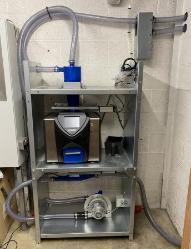
The Savannah range of grain driers come with a touch screen PLC Control interface as standard. This can be accessed remotely via Wi-Fi enabling the drier to be monitored and controlled from anywhere with mobile coverage. This will save you labour costs as you no longer need to have your drier staffed while it is running and also give you peace of mind while you spend your time on other activities.
The Perry Savannah Series Driers have a capacity range from 5tph upwards and with all of the options listed above there is a powerful argument to purchase a Savannah drier.
The actual savings you can achieve using these options will vary based on several factors including hot air and ambient air temperatures, crop type & moisture, drier model and fan speed and the general ambient conditions. Contact Perrys today to run your reallife data through our Drier Cost Savings Calculator to see how much you could save on (0)1404 890 300 or email sales@perryofoakley. co.uk

A British Manufacturer
Perrys have been a key part of the British agricultural sector for over 75 years. Perry design & manufacturer their entire product range in the UK which means that all the support you need is rapidly available, including a large stock of spares.
Contact Perrys today for all your handling, storage & drier requirements on (0)1404 890 300 or email sales@perryofoakley.co.uk, and receive a free, no obligation quotation.

| Grain Farming


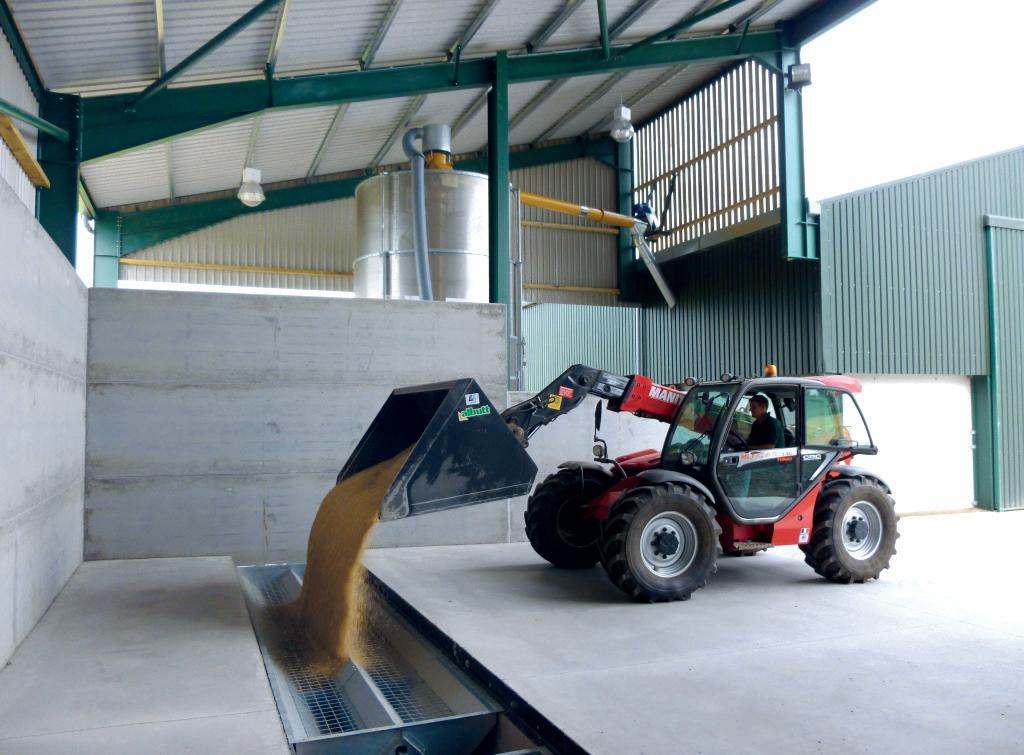
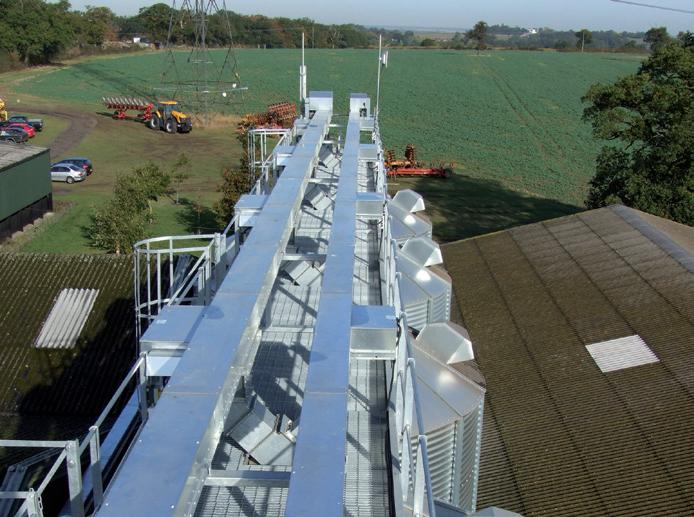
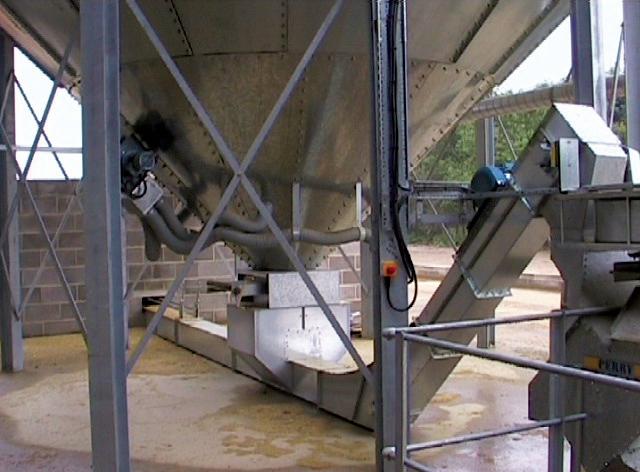






Grain Drying, Handling & Storage From Individual Machines & Bins to Full Grain Stores with Silos British Designed, Manufactured & Supported Visit us online at www.perryofoakley.co.uk sales@perryofoakley.co.uk +44 (0)1404 890300 The UK’s Most Experienced Manufacturer of Grain Drying, Handling & Storage Equipment Want To Save Up To 35% of Your Drier Running Costs? Contact Us Today!
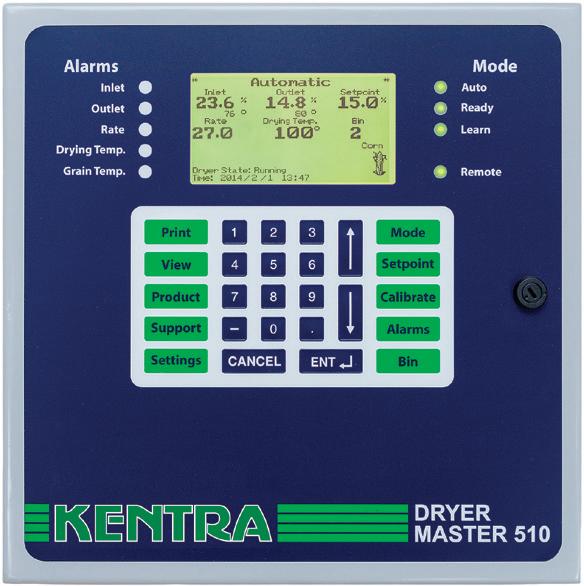

New grain moisture monitoring systems from Kentra help growers manage crop drying operations, we explore the technical world of Kentra crop drying and discover the capabilities and possibilities of Kentra’s unique products.

Kentra, the Yorkshire-based manufacturer of mixed flow crop dryers, has introduced two new moisture measurement and recording systems for growers, and an automated moisture monitoring system ideal for use at the grain intake, adding to its exisiting range of crop moisture management
The high-accuracy products come from Canadian manufacturer Dryer Master, whose long established DM510 control system fully automates the grain drying process with minimal manual intervention.
“The new DM100 is a lower cost, less sophisticated version that still provides an element of control to relieve the workload of whoever is managing the dryer”
Grain moisture is measured at the discharge point and adjustments to the discharge rate are made automatically when operator-set
high, low and target moisture levels for each of three discharge speeds are hit.
Unlike the fully automatic DM510, the DM100 requires the speed set points and moisture targets to be adjusted periodically to maintain optimum performance.
The new Moisture Monitor Pro records grain moisture and temperature at the discharge – with the option to add an intake sensor as well – to help operators achieve consistent results from fully manual control.
As with the DM510 fully-automatic and DM100 semi-automatic systems, values are shown on a colour display, are accessible remotely using a mobile phone and can be downloaded to farm computer records.
These features are also common to Load Monitor, a system that records the average moisture of entire lorry or trailer loads of grain at the intake.
“The sensor is fitted in the grain flow line – for example in a duct where grain passes from the intake pit to an elevator – and Load Monitor automatically starts logging as soon as the sensor detects grain flowing across it”
“The finished record includes a consignment identifier and time stamp, and compared with sampling, using Load Monitor means there is no delay to tipping incoming consignments and the moisture reading will be fully representative of the bulk.”

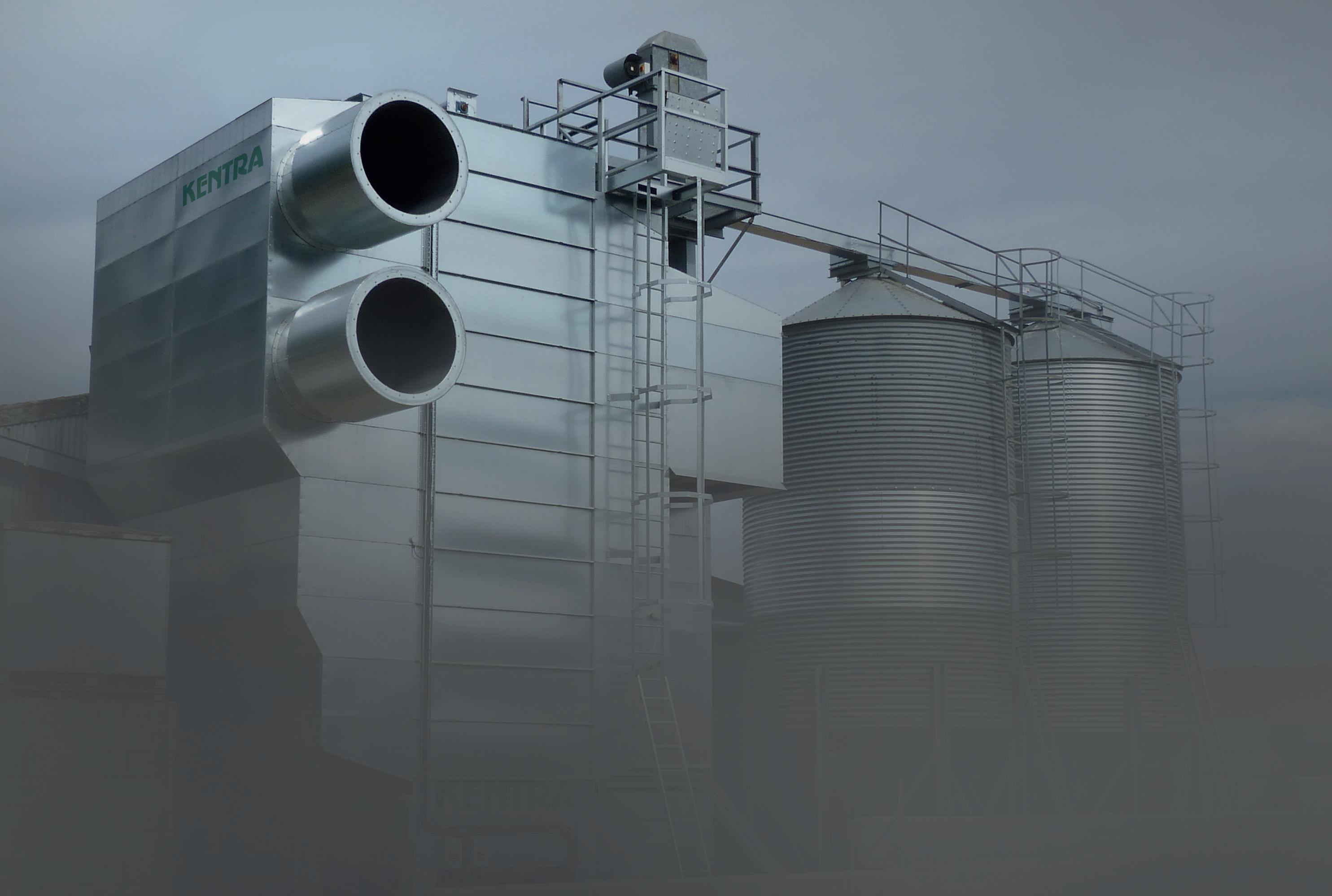
Farming
CROP MOISTURE MONITORING
Our experience harvests results

Kentra Grain Systems was formed in 1989 to design and manufacture grain dryers that meet the challenging requirements of British farmers.
Today, the range of mixed flow dryers produced from heavy-duty galvanised steel features a unique column design for effective drying of all free-flowing combinable crops and control systems, axial flow fans and designed, developed and manufactured in-house.
The modular construction of the dryer allows for maximum flexibility in model selection.
So if you need a throughput of 10 tonnes or in excess of 100 tonnes per hour our range of dryers and user-friendly management software give you complete, real time control over your harvest.



Grain drying demands real time control and automated decision making at your fingertips. Kentra brings you both and more.
Our ever changing climate ensures it has never been more challenging to produce a consistent quality harvest.
Kentra has been at the forefront of continuous flow grain drying technology for well over 30 years.
Our range of dryers and user-friendly management software give you complete, real time control over your harvest.
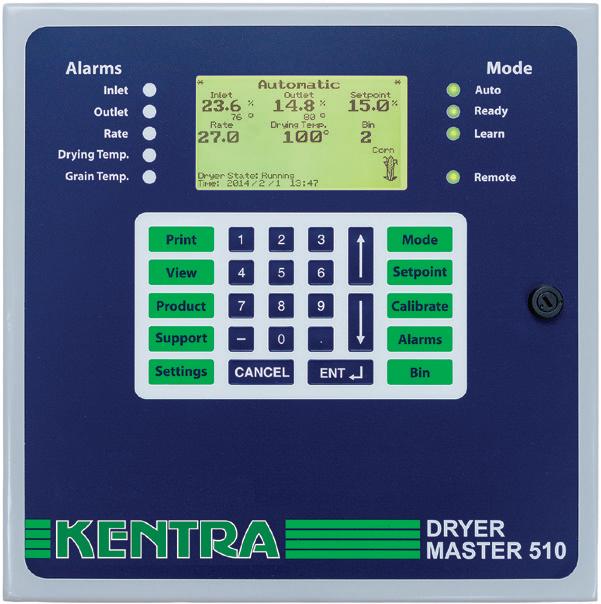






• CONTINUOUS AND EVEN GRAIN DISCHARGE
• REMOTE INTERNET MONITORING AND CONTROL
• TOUCH SCREEN CONTROL FOR EASE OF USE
Farming
Sales@kentra.co.uk www.kentra.co.uk
For further information please telephone: 01423 326665 PROUDLY MADE IN THE UK
3 yr WARRANTY 120 tonnes / hr Throughputs up to Low power requirement | Grain
Upgraded grain processing plant from McArthur BDC and installed for harvest 2023 is already delivering return on investment

Pete Olds and his father, Len, grow 300 acres of combinable crops and run an arable contracting business at Cornhill Farm in Cornwall. With their grain processing plant struggling to cope with handling up to 4,000t of wheat and barley each year, the Olds worked with McArthur BDC to install an upgraded plant in time for harvest 2023.
“Due to the improved efficiency of the new plant, it is already delivering a return on investment,” said Pete Olds. “Our previous 25t drier, even in the hot summer of 2022 was averaging just 6.5tph, whilst our new Svegma 15tph SV3/3 continuous flow drier,
manufactured by Akron, delivers a significant increase in productivity. It has been hitting 20tph when the crop has been drier, which we’re very pleased with.”
The Olds had considered various new and second-hand drier options but issues around dismantling and then installing used driers were not viable options. Plus, the new drier had to operate within the confines of an existing shed and a maximum electricity supply of 100amps. As well as providing additional drying capability, the Svegma crucially did not require an increase in the electrical power supply.
Having decided on the Svegma drier,
Farming | Grain
discussions then took place between the Olds, and McArthur BDC, who the Olds knew well as it had supplied their previous drier, around the handling kit to be installed in the new plant.
The handling equipment installed to match the drier throughput includes: 2 x 40tph Skandia Elevator I-Line chain and flight trench intake pits, 6 x Skandia L-Line chain and flight conveyors, 2 x Skandia L-Line belt and bucket elevators, 1 x Skandia dust & chaff remover, 1 x moisture monitoring system (MMS) and a PLC control panel to enable remote management of the plant.

“The combined McArthur BDC team presented us with a 3D CAD drawing which provided great insight into exactly how the different elements of the plant fitted together. We could see exactly what they were putting together for us,” explained Pete Olds.
The grain enters the plant via the two Skandia trench intakes. The twin pits allow two wet intakes so two crops can be stored, or they can double the storage of one crop, ensuring flexibility and a quick turnaround of tractors and trailers during harvest.
From the intake, a series of Skandia conveyors take the grain to the dust and chaff extractor from where it is transported via conveyors and elevators to either the Svegma drier, or one of two storage sheds.
Using predefined levels, the MMS monitors the moisture content of the crop going into and out of the drier. With different customers delivering grain into the farm the moisture content varies constantly.
The PLC control panel and MMS automatically sends alerts if the moisture content is outside the predefined levels, there is a blockage, the intake pits are empty, or there are any other issues. This avoids the constant monitoring of the drier, and the associated waste of valuable resource during harvest. The Olds are made aware of any problem as soon as it occurs and can quickly resolve it.
“Speed of throughput and ease of use have
been critical factors for us. It was a challenging wetter harvest and as good a year as any to upgrade our drying capabilities,” continued Pete Olds. “We used to have to stockpile wet corn temporarily outside before it got to our previous drier. Sometimes we have four combines harvesting and sending corn into us, so the previous drier had become a real pinch point for us.”
“The intake pits are ideal and provide a buffer for us to operate the drier. In fact, the drier is so swift, we need to get a decent amount of grain in before we start up the plant! We haven’t used any outside storage this year.”
As the Olds’ were extending part of the plant’s building infrastructure themselves it was important that they liaised closely with McArthur BDC.
“We were doing all the groundworks and shed installation ourselves. McArthur BDC was very flexible around what we needed to do and once the drier and the handling equipment was installed, we were able to complete the works at our own pace. The install went very well and was commissioned just as the first harvested grain arrived,” added Pete Olds.
“The new plant, which we see as having a 20 plus years lifespan, is working really well for us and has certainly made harvesting easier. We had been used to drying grain around the clock for days on end to keep up with the combines, but for harvest ’23 we only had to dry past midnight a handful of times. We were able to get some much-needed sleep!” concluded Pete Olds.
Farming | Grain

A cosy night in



Last month I was kindly gifted a wonderful wool duvet from Baavet in Snowdonia and immediately thought OK! I’ve heard lots of wonderful things regarding woollen duvets and as a fibre artist myself, I’m aware of the benefits however, would it provide a good night’s sleep? I think it’s safe to say that we all have preferred choices with our bedding. When we snuggle down after a hard day’s work, getting 8 hours of quality sleep is essential to help us function. But rest assured, I’ll never endorse anything unless I’ve tested it myself as we’re all aware of the term ‘Greenwashing’ aren’t we?
Before I share my findings with ewe all, let me take you back to the beginning of how Roger & Lesley began with their idea for a British made wool duvet



on their farm in Snowdonia.
Their aim from the beginning was to find a way to help farmers get a fair price for their wool and to utilise this wonderful natural resource to produce high quality, sustainable, eco friendly products. But after discovering there was sadly no longer anyone in the U.K with the necessary skills or machinery, they set about bringing together a team with the expertise and traditional skills to enable their dream to come true.
After several months of researching and numerous leads they finally found someone who had one of the few remaining wool carding lines left in the UK that could card wool to the width they required and who was keen to help Roger & Lesley to develop their product. But then their searching continued to find someone who understood quilting. Their next two years continued in the same vein exploring, researching and
Farming | British Lifestyle

experimenting resulting in creating probably the first wool quilting line in the UK.
They set up a small factory unit in Snowdonia to convert rolls of quilt made in Huddersfield into the individual duvets soon becoming competent in keeping everything running smoothly. Their hard work eventually paid off and they launched their wool products on the internet and were amazed with the public’s response. Now they employ 4 people full time and 5 part time and have secured two jobs in the wool carding mill at Huddersfield doubling their turnover year on year in the last 3 years.
Since then, this dynamic duo has launched several product lines including Pure wool mattress protectors, pillow, pet Baavets and mattresses. Baavet was born and is now the leading producer of Pure Wool Bedding in the U.K. Taking care of every step from ewe to you! A world class product Made in Britain!
Aside from sheep farmers & woolists not everyone understands the huge benefits of wool however it simply is the most marvellous of natural materials and is far superior to Polyester, Feather, Down or Silk. Wool has the capability to regulate your temperature keeping you warm and comfortable throughout the night and trust me it truly does! Also, it’s antibacterial which means these fabulous products from Baavet are fantastic at repelling dirt, moisture wicking and are dust mite resistant so are naturally clean and if need be, all you must do is refresh by airing outside. Subsequently these products are hypo-allergenic which means they can ease asthma and eczema symptoms. My daughter suffers with Urticaria and has dramatically seen a huge benefit with using a wool duvet providing a comfortable night’s rest. It’s honestly been such a significant improvement.
If you’re not convinced yet to choose Baavet, why not consider all the ‘greenwashing’ testimonials out there in cyberspace that state they are good for our planet when genuinely they’re not? Baavet is professionally manufactured to the highest of standards right here in the U.K! We should be


celebrating and supporting these wonderful initiatives which use British machinery and expertise. Using wool from farmers, who have years of experience working with the natural wool that goes into their products, with great ethics which all provides a feel-good factor.
Baavet is a British product that you can trust leaving you with just one problem of not wanting to get up in the morning. Even offering to refund if you don’t receive a good night’s sleep – it doesn’t get better than that now does it? I for one am convinced of the benefits and will be returning like many others to support this innovative business.
Visit Baavet www.baavet.co.uk and check out their lovely blog, glowing testimonials, handcrafted products and sign up to their newsletter.
Find them on socials @baavet
Made In Britain as seen on Dragons Den
Written by Olivia Shave Instagram: @ecoewe

Farming | British Lifestyle
B Branston Net Zero Plans Step Up A Gear
ranston has introduced the first, fully electric truck to its fleet, as part of its ambitious plans to reach net zero by 2035.
Following a successful trial in June this year with Crossroads Truck and Bus Ltd - the truck dealer for Volvo - Branston has now permanently added a Volvo FM Electric 4x2 truck to its fleet. Transportation is a key focus area of the company’s wider net zero ambitions; reducing the carbon emissions of


collecting and delivering many tonnes of fresh potatoes around the UK.
Paul Donkin, group transport manager at Branston, said: “This is a fantastic milestone for us to introduce our first electric vehicle (EV) to our transport network. After the trial, we knew we could start to integrate an EV into the fleet, and initially we’ll be using it to do regular depot deliveries to Livingston as well as a few farm trips to test the mileage and efficiency.
“Getting this EV is a big step, and we are training our drivers in the best way to drive it, which is quite different to a standard diesel truck. We're also investing in driver training to ensure that the rest of our fleet is driven as efficiently as possible. We can

achieve a saving of 20% on miles per gallon when cruise control and acceleration are used strategically, which all helps to bring costs and carbon down.”
When compared to a traditional diesel truck, the Volvo FM Electric 4x2 truck could save up to 50 tonnes of carbon emissions each year, provided the correct infrastructure was in place UK-wide for maximum charging efficiency. One of the biggest investments is the fast charger, which reduces charging time from 10 hours to just two hours.
Paul added: “One of the challenges will be the infrastructure, or lack of it in some places. While we can do what we can as a business to work towards net zero, without infrastructure across the country keeping pace, there’s only so far we can go. Branston will be investing in a fast charger at our Scottish site and will be monitoring the performance of the EV to determine our next steps.
“We’re open minded to all avenues and know there are many routes we can take, including a hybrid approach combining EVs and hydrogen powered vehicles. This is just one of many changes we expect in our transportation of spuds in the next 10 to 15 years.”



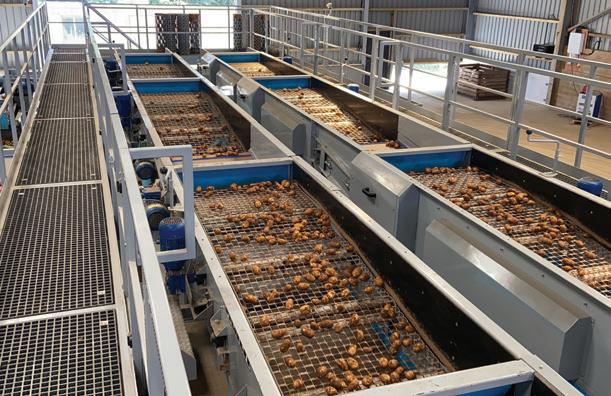


Farming | Potatoes & Root Crops
2 Farm Machine of the year 2024: GRIMME EVO 290 with ChangeSep
0 national and international specialist journalists have voted: the “Farm Machine of the year 2024” in the field of root crop technology is the GRIMME EVO 290 with “ChangeSep”.
The trailed two-row bunker harvester EVO 290 evolves the SE principle that has been tried and tested for years - screening, cabbage separation and height conveying in one operation. Impressive performance meets profitable efficiency. The “ChangeSep” change-over separator allows you to conveniently change the second separator on machines such as the EVO 290, which are equipped with two separators. The switch between the finger belt (“ClodSep”) and scraper rollers (“EasySep”) can be carried out hydraulically from the cabin in less than 2 minutes.
This makes it possible to adapt quickly and easily to changing soil and operating conditions as well as different harvesting methods (direct, divided or enriched). This saves an enormous amount of (reconstruction) time and creates the conditions for optimizing the area performance without sacrificing gentle treatment of the tubers.
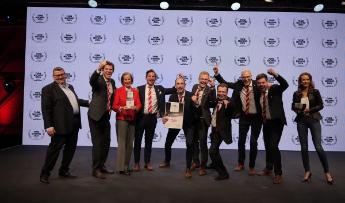

With the “ChangeSep” change-over separator, two existing systems were combined in one machine. The “ ChangeSep ” was also awarded the silver medal by the DLG.
The joy is enormous: Alexander Bohnsack (editorin-chief AGRARTECHNIK) and presenter Susanne Schöne present (from left) Christoph, Christine and Philipp Grimme as well as Michael Hassig, Maximilian Gerken, Jürgen Feld, Sebastian Talg and Cord-Hinrich Fürstenau with the coveted award.

Farming | Potatoes & Root Crops
Attention to detail in store as important as ever after a horrible harvest
Biox-M is the only 100% natural and sustainable sprout control for potatoes.
The south had enjoyed a few dry days as we moved into February (now back under water), but, for many growers, the 2023 harvest will remain etched in the memory as one of modest yields and dreadful lifting conditions. Little of the crop still left in the ground is likely to reach its intended market, even at prices not seen for many years.
Store management, always requiring excellent attention to detail, is facing additional
challenges as we head into spring. Stores with a prolonged filling window are always harder to control, but that is made still worse if the late arrivals turn up wellcoated with wet soil. Crops have to be dry before treatment; there can be no compromise, and patience has been necessary. One factor, which is working to the advantage of growers, is that the 2023 crop seems to be less keen to break dormancy than the 2022 crop, grown in glorious summer sunshine. Patience is paying off, as
growers are often able to delay first treatments, and ensure that the stored crop is in reasonable condition for treatment.
The new year cold spell is likely to have helped the situation and reduced sprouting pressure in stores using ambient cooling. However, we are now back in above-average temperatures. Regular store checks are recommended; well-timed control as the eyes open is always better than a rescue treatment.
• Is a naturally occurring and truly sustainable product, in widespread use in the food industry,
• Is approved for use on organic potato crops,
• Has no harvest interval or MRL beyond the one-day mandatory withholding period after treatment,
• Has flexibility of timing of application,
• Results in minimal weight loss in store,
• Does not leave persistent residues in the fabric of stores and boxes used for storage,
• And is therefore suitable for use in stores, which may subsequently be used for the storage of other crops or seed potatoes,
• Is effective at higher storage temperatures, reducing the risk of acrylamide development when crop is processed,
• Sequesters carbon during growth, removing 1t of CO2 for every 1,000t of potatoes treated,
• And should be a component of the sustainability plan for every farm and every customer; effectively carbon neutral.
Farming | Potatoes
| Potatoes & Root Crops

Natural. Effective. Powerful.




Farming
100% Spearmint Oil sprout inhibitor for use on ware potatoes in store. Peter Hall peter@junopp.com 07973 172 722 www.junopp.com Nick Tapp nick@junopp.com 07775 785 748 MAPP 16021 U K ANNIV E R S A R Y 1 0 YEAR
Haith Group, the UK’s leading manufacturer of vegetable handling equipment treated visitors to its stand at last month’s Fruit Logistica to a true taste of Yorkshire with Yorkshire Tea and biscuits on offer to all.
As well as hospitality, Haith's team also promoted the company's new potato dryer, the ProDry, the latest version of its Queen's Award-winning RotaTip, the QuantaFill box filler and its water treatment systems.
The Haith ProDry uses an innovative fan and belt system to speed up the drying time of potatoes. As well as being quicker than conventional sponge dryers, Haith's new system eliminates any potential bacteria build-up which can occur in other drying systems.
Haith's ProDry complements the company's range of sponge roller dryers. The innovative solution conveys washed wet potatoes through a drying tunnel where a combination of fans dries the whole surface area of each tuber.
Haith's 2024 version of its market-leading Rota-Tip box tippler has been enhanced by introducing an in-feed and out-feed box stacking and de-stacking functionality, which speeds up the box emptying process and dramatically reduces forklift movements.
Haith's Rota-Tip PRO gently empties potato boxes quickly and reliably, even in harsh conditions. As the tippler is rotated around a centre pivot, the weight of the box is never lifted, and the machine is not put under pressure, which eliminates fatigue or prevents damage to both the machine and the box.
The absence of hydraulics also removes the chance of oil contamination, and as Haith only uses high-efficiency motors, which only run during the tipping sequence, the Rota-Tip offers exceptional power consumption.
Hydraulics are also absent from Haith's third new product – the QuantaFill box filler.
The QuantaFill features an innovative infeed conveyor that gently layers the crop into a buffer bunker, which is then lowered into the box. Active discharge doors then open to transfer the crop into the box, simultaneously raising as it fills. The
process ensures that the weight of the box is never lifted and the machine is not put under pressure, which eliminates fatigue or prevents damage to both the machine and the box.
The additional box handling functionality allows the operator to place stacks of empty boxes into the machine, which are then automatically de-stacked and transported to the filling module. After filling, the boxes are re-stacked for the operator to remove from the line. As well as the new

Farming | Potatoes & Root
Crops
machinery, Haith will also showcase its water treatment systems and wastewater recycling solutions.
"We had a fantastic time at Fruit Logistica and it was great to have a chat with so many people over a cuppa!" says Rob Highfield, Sales Manager at Haith. "As well as promoting our latest innovations in vegetable handling, we also put the spotlight on our water treatment solutions, which allow food processors to reduce both their environmental
impact and their water bills. Our water treatment systems are predominately found in the UK, but there's no reason why they cannot deployed further afield, so with Fruit Logistica attracting visitors from across Europe and around the world, it was the perfect place to promote our capabilities.”
To find out more about Haith have a look at www. haith.co.uk, email sales@haith.co.uk or call 01302 831 911.

Farming | Potatoes & Root Crops
Kawasaki leads the way in customer security with the adoption of the CESAR system for utility range in 2024
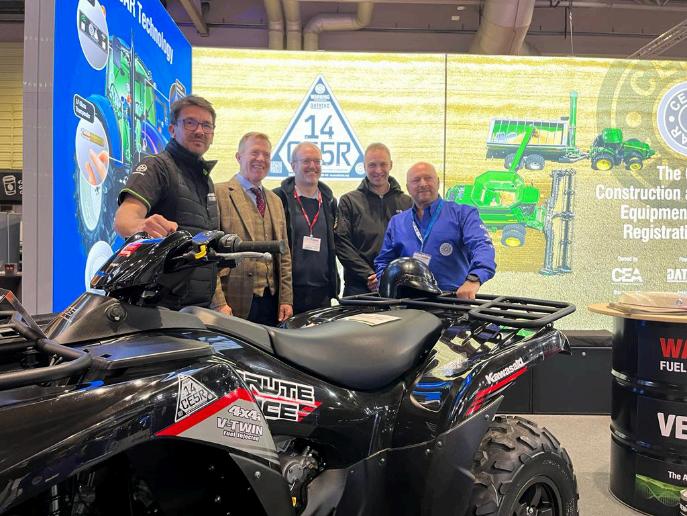
In anticipation of the groundbreaking Equipment Theft (Prevention) Act 2023, Kawasaki proudly announces the integration of the industry-leading CESAR Security System, powered by Datatag, into all its ATV models beginning in 2024.
Addressing the critical issue of vehicle theft in the agricultural sector, Kawasaki proactively enhances customer security and protects their investment. The CESAR Security System, endorsed by the Agricultural Engineers Association (AEA) and developed by Datatag ID Ltd, offers cutting-edge security marking and registration, significantly reducing theft rates and aiding in the recovery of stolen vehicles. Kawasaki's adoption of CESAR underlines its commitment to innovation, high performance, and customer safety.
Craig Watson, Kawasaki's Sales and Marketing Director, said, "At Kawasaki we value the trust our customers place in our products, and their security is of utmost importance to us. We recognise the business critical nature of our products to our
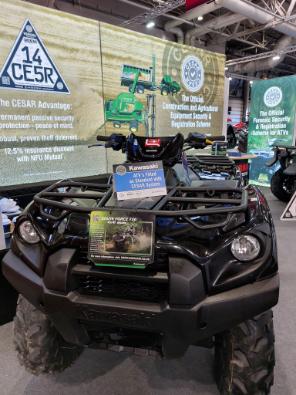
Farming
| LAMMA
customers and by integrating the CESAR system with its Datatag technologies, we are reinforcing our dedication to providing a complete and secure offering for our customers."
The CESAR scheme, the official security marking system of the industry, boasts a successful track record in theft reduction and supports law enforcement in recovering stolen vehicles. The database, accessible around the clock to authorised users, allows prompt identification and retrieval of stolen ATVs. The recent introduction of Datatag's smartphone-enabled RAPID asset-checking system further enhances the security and theft deterrence of registered assets.
The CESAR ATV System features unique tamper-evident identification, combining visible and concealed identifiers with a distinctive DNA solution, significantly complicating a thief's attempts to operate covertly.
KevinHowells,CEO of Datatag, commented, "We are extremely honoured to partner with Kawasaki in protecting their customers. As the delivery partner for the sole official industry scheme, we possess the necessary infrastructure to support Kawasaki's decision and will continue training UK police forces on how CESAR facilitates quick,


easy identification of assets, thereby deterring theft."
Ruth Bailey, CEO of the Agricultural Engineers Association, a strong advocate of the CESAR Scheme, remarked, "ATVs are crucial machines on many farms and their theft can be incredibly disruptive to farm businesses, not to mention possible implications for animal welfare and environmental improvements. Anything which helps to deter theft is, therefore, welcome. The industry's CESAR scheme has extensive coverage across the agricultural sector and it is great news that another leading manufacturer is adopting it."
Suneeta Johal, CEO of the Construction Equipment Association and owner of the CESAR Scheme, said, "Kawasaki's decision to incorporate the CESAR system into their ATV models is a significant milestone. It highlights the industry's united front against equipment theft and our firm commitment to safeguarding customers' investments. This collaboration between Kawasaki and the CESAR scheme is a model for how manufacturers and security systems can work together to enhance safety and security in the industry."
Farming
| LAMMA
A CESAR announces 625,000th machine protected today at LAMMA
t the country's premier agricultural show, LAMMA, CESAR celebrated a significant milestone: the protection of their 625,000th machine with advanced security marking technologies. Kevin Howells, MD of Datatag ID Ltd, a key partner in the scheme, presented a symbolic CESAR identification plate, numbered 625,000, to Ian Roberts, Sales Manager, Ernest Doe, on behalf of CNH (Case New Holland).
Associationsaid, "Reaching this landmark is a testament to how much the industry values the CESAR scheme and the extra security it has provided to our customers over many years. The fact that nearly all of the major manufacturers fit CESAR to their agricultural tractors as standard shows the industry's commitment to reducing the risk of theft."


Ian, who is the recipient of the 625,000th machine said "CESAR and its Datatag technologies, have been a useful tool within the New Holland "toolbox" to help sell a product. Apart from the obvious sign on the unit the other elements to the tagging process are well hidden and go somewhere to ensuring peace of mind to the end user."
CESAR's latest innovations were also showcased, including the CESAR ECV - a tool that quickly verifies a machine's emissions status - and the recent integration of Ultra High-Frequency RFID transponders, further improving security capabilities. The new RAPID machine check system allows police officers to swiftly verify a machine's status using a smartphone, solidifying CESAR's lead in the industry.
Ruth Bailey, CEO of the Agricultural Engineers
Kevin Howells, MD of DATATAG ID,said, "I must thank Case New Holland for their support of the CESAR Scheme, being as they were one of the first in the agri sector to adopt its technologies to protect their customers." He went on to say "Our nextgeneration UHF transponders, unique in their security features, and our RAPID check system are innovations that keep CESAR Scheme and its DATATAG technology at the forefront of the field and place CESAR in a strong position to meet the requirements of the proposed private members bill addressing machinery and tool theft, a blight on the agri community."
Suneeta Johal, CEO of the Construction Equipment Association, owners of the CESAR Scheme, shared her support, "The milestone of protecting 625,000 machines is a testament to the industry's trust in CESAR. As we approach the implementation of the Parliamentary Equipment Theft (Prevention) Bill,our commitment to combating equipment theft with cutting-edge technology has never been stronger or more necessary."
To learn more about the CESAR Scheme and its impact on reducing equipment theft, visithttps:// www.cesarscheme.org/
Farming
| LAMMA
K Workshop - Powered by Kramp showcased at LAMMA
ramp, a leading agricultural parts supplier, showcased its Workshop | Powered by Kramp solution to visitors at LAMMA this year. The system organises all the consumables an agricultural engineer, parts department or farmer needs, and barcode scanning using the Kramp app allows easy reordering of the correct item.
Workshop | Powered by Kramp began as a method for stocking fasteners in dealer workshops and parts departments but has evolved into a mixand-match system that theoretically can stock the entire Kramp range of consumables, explains Alwyn Roach, account manager for Kramp. On display at LAMMA was a complete hydraulics fitting station.
“All the installations we have done have had excellent customer feedback, so we wanted to show it to a wider audience at LAMMA,” says Alwyn.
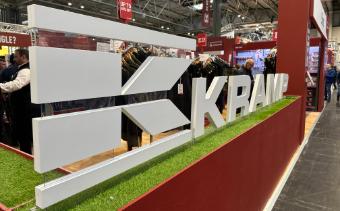


their stock via an online account with their dealer, and the items are dispatched on next-day delivery from the Kramp distribution centre straight to the farmer’s chosen address.

“There are 165 different locations for hydraulic fittings on the unit demonstrated. Manually putting an order together for 165 items is about 45 minutes of work. However, using the Kramp app, all the locations on the unit can be scanned in less than five minutes.
“There is an initial capital outlay, but the unit will pay for itself within 12 months because the timesaving and order accuracy dramatically improve productivity.
Although the system was initially designed with Kramp’s dealers in mind, there was a lot of interest at LAMMA from farmers and contractors. Farmers with a Kramp Workshop solution can replenish
Workshop | Powered by Kramp is one of several business solutions that Kramp offers designed to help businesses increase sales, reduce costs and increase productivity.
Customers benefit from expert technical advice.
The hydraulics workshop unit benefits from technical support from Kramp’s expert team. Gene Orchard is a hydraulics product specialist at Kramp and a British Fluid Power Association (BFPA) qualified trainer.
He says: “When we install a hydraulic assortment for a customer, we will include the product and hose range the customer needs. The unit at LAMMA is a standardised kit. It has a varied selection of different thread forms, hose inserts, adapters, quick-release couplings and dowty seals. Sometimes, I am asked by a customer to advise on which thread forms and quantities will be best to stock.
“Along with the fittings and hose, sometimes we are asked to supply the equipment to make the hose assembly. When this happens, we will provide training to make sure they are using it safely.
“Our goal is to ensure every business supplied with a hydraulics assortment can service their customers using it as soon as it is installed.”
Farming
| LAMMA
Ktwo Showcases Enhanced Compact & Push Trailer and Revitalised Warwick Trailer Range at LAMMA24

At LAMMA24, Ktwo, a frontrunner in agricultural machinery, unveiled significant advancements with the upgraded Compact & Push Trailer and the newly relaunched Warwick Trailer range. These developments represent a major stride in Ktwo's ongoing effort to redefine performance, durability, and efficiency in agricultural machinery.
Revolutionary Compact & Push Trailer Sets New Industry Benchmarks
Ktwo has introduced their new version of its Compact & Push Trailer, renowned in the market for its innovative design and efficiency. Terry Kelloway, the founder of Ktwo, highlights the innovation behind this design, "The integration of the Curve tipper style body in our trailers significantly bolsters their longitudinal strength, ensuring they maintain squareness and rigidity during compaction or ejection, which keeps the pusher grain tight and ensures tight seals on the headboard." This redesign emphasises manufacturing efficiency with a streamlined production process supported by jig-based construction. This method not only speeds up manufacturing but also reduces the number of parts required,
effectively lowering the overall weight of the trailer. This allows customers to transport more while staying within the 31-ton gross weight limit. The Compact & Push Trailer has


Farming
| LAMMA
consistently been a major highlight at LAMMA, and the 2024 event was no exception.
Warwick Trailers: Embarking on a New Chapter
The relaunch of the Warwick Trailers range at LAMMA24 is a key milestone for Ktwo, reflecting the company's response to customer demands and its commitment to supporting its dedicated dealership network.
The Warwick range now includes the new Eco spreader, previously part of the Ktwo range and the first spreader for the Warwick Trailer brand. Designed specifically for smaller scale farmers, the Eco spreader, and the entire Warwick Trailers range maintain the highquality finish that Ktwo is known for.
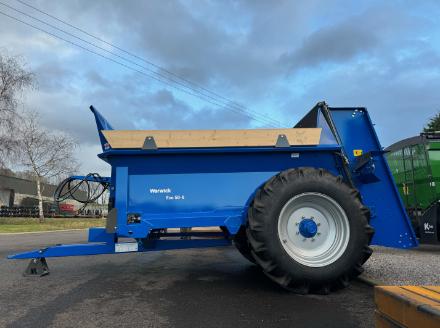

Unprecedented Success and Excitement at LAMMA24
Ktwo's exhibition at LAMMA24 was a resounding success, drawing significant attention and excitement, especially for the Warwick Trailers range and the enhanced Ktwo Compact & Push Trailer. The stand was
constantly surrounded by visitors, particularly interested in the Compact and Push Trailer and the Eco spreader. LAMMA24 provided an excellent platform for Ktwo to showcase its commitment to innovation, quality, and customer satisfaction in the agricultural machinery industry.
For more information about Ktwo and their machines, please visitktwo.co.ukor contact sales@ktwo.co.uk / 01844 299290.

Farming
| LAMMA
HARPER ADAMS VICTORIOUS ONCE AGAIN IN THIS YEAR’S DAIRY STUDENT AWARD
Jon Witter, a student at Harper Adams University, has beaten off five other finalists in a closely fought contest to win this year’s RABDF Dairy Student Award, sponsored by ForFarmers.
The award, which has been running for over a decade, is open to entrants studying at universities and colleges, and is highly regarded throughout the whole sector. Taking the form of 1,500 word essay in response to a case study prepared by Kite Consulting and delivering a presentation to a panel of judges at the Farmer’s Club in London.
The winner was announced at Dairy-Tech, the RABDF’s flagship event, on Wednesday 7 February. The presentation saw Jon take home a cheque for £750. Teddy Moore from Reading University was named the runner up.
The competition, run by the Royal Association of British Dairy Farmers (RABDF), is designed to reflect real-life challenges seen on dairy farms and broader policy issues and identify some of the sector's rising stars and new entrants.
This year's judging panel consisted of RABDF Chairman Robert Craig, who was joined by Alison Ewing from ForFarmers and Kaia Hillsmith from
Kite Consulting.
Commenting on the winner, Mr Craig said: "The standard of this year's students was incredibly high, making the final decision almost impossible.
“Jon gave an excellent presentation which highlighted his knowledge of dairy farming both at home and on a wider level concerning the industry as a whole.”
“This is the first year ForFarmers have sponsored the award, something we are proud to be associated with,” explains ForFarmers Technical Development Manager, Alison Ewing.
She said: “I thoroughly enjoyed the judging process and meeting the finalists; their passion for the dairy industry was infectious, once nerves were overcome.
“Congratulations to all and especially to Jon and Teddy, as winner and runner-up. I hope they start their dairy careers with good support and mentors to harness their enthusiasm and knowledge.”
The award winners were announced on the Dairy Hub at Dairy-Tech and were presented by RABDF Chairman Robert Craig.
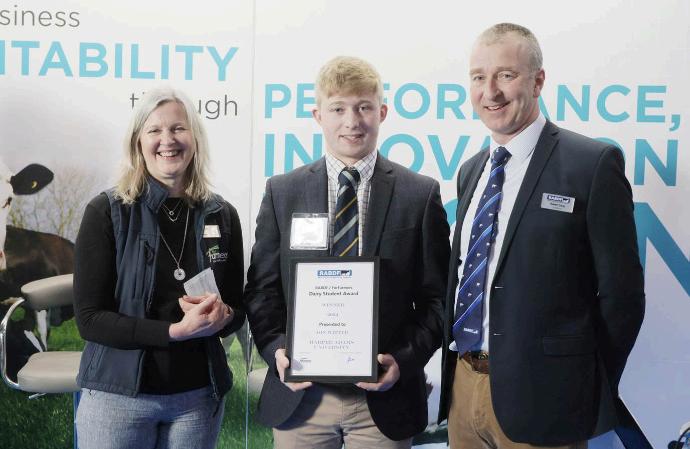
Farming
| Dairy Tech review
NEW BLOOD TEST FROM BIMEDA BEATS OFF COMPETITORS TO WIN ROYAL DAIRY INNOVATION AWARD

ImmnuIGY Bovine IgG from Bimeda was named winner of the Royal Dairy Innovation Award at Dairy-Tech in 7th February.
ImmunIGY Bovine IgG is a novel test that checks whether a calf (up to 42 days old) has received sufficient antibodies from the colostrum (IgG levels). The blood test is easy to conduct using a lancet and directly measures IgG levels using a lateral flow device (LFD) in just 10 minutes.
Calves receiving insufficient, high-quality colostrum in the correct timeframe will suffer from Failure of Passive Transfer (FPT) and have been shown to be more susceptible to disease and poorer performance in terms of daily live weight gains.
Farms which routinely monitor IgG status have been shown to suffer significantly lower rates of failure of passive transfer, highlighting the importance of monitoring.
Head Judge and RABDF Vice Chairman, Tim Downes says: “This year’s winner of the Royal Innovation Award was seen as a new step forward in measuring the success of rearing healthy calves.”
He continues: “The judges were impressed with the potential benefits for the dairy industry by allowing testing of colostrum intake up to 42 days old.”
“Bimeda are incredibly proud to have received this award,” says Bimeda General Manager Mark Cokayne.
“We are thrilled that by using the Immunigy Bovine IgG test producers can now assess calf IgG levels with definitive direct results. Praise is also due to our partners in this project; Synergy Farm Health, Soma Bioscience & Buitelaar Group. It has been a real team effort to get to this point and we are all excited about the future.”
Bimeda will be formally recognised in a presentation by Her Royal Highness The Princess Royal later this year.
The runners up for the award were:National Milk Records (NMR) with GenoCells;an innovative herd management and herd improvement service centred exclusively around genomic testing and DeLaval with DeLaval Plus; an online platform that uses the most advanced level of farm management analysis to give farmers the tools to turn on all their farm data into actionable and easily understood information.
Picture: Connor Smith, Bimeda receiving the winner certificate from judges (L-R)CIEL's Head of Innovation and Animal Health, Dr Grace O'Gorman, RABDF Trustee Tim Downes and Global Sales Director for smaXtec Chris Howarth.
Farming
| Dairy Tech review

Integrated Pest Management
(IPM) Planning Tool updated
4
00 users have registered to use the IPM Planning Tool since it was launched in September 2023 and feedback is the tool is useful, user friendly, and informative by independent agronomists.
Since the launch of the free IPM Planning Tool late last year, over 400 registered farmers, agronomists, and advisors have produced 600 IPM cropping plans. In response to user feedback so far, an updated version of the tool has been released today with enhanced functionality including:
Expanded crop types, including spring barley, wheat and beans, to cover more diverse rotations and support decisions on spring crops in IPM strategies.
The ability to view the previous year’s pest, weeds and disease issues, practices, and comments so farm progress of IPM uptake can be recorded.
The option to duplicate previous plans as a starting point for the following year, which will speed up the process of producing a new plan and allow time for review and reflection of selected strategies.
Farmers and agronomists who have used the tool have appreciated the ease of use and the depth of information available on IPM approaches across all the major field crops.
Speaking at the AICC annual conference last week, Simon Senior, independent agronomist said, “It is a very useful user-friendly tool, from which both myself and my clients have learned a great deal from the IPM measures outlined”.
Agronomist Andrew Beeney agreed, “The tool has certainly encouraged me to discuss it with my clients, so that it encourages them to complete an IPM plan”.
Neil Paveley, Technical Director for Crop Protection in ADAS, added “We are delighted that farmers and agronomists are finding the IPM Tool useful for crop planning, and that the number of users is growing fast.”
The IPM Planning Tool is freely available at www. ipmtool.net or via the VI websitehttps://bit.ly/ VolInit_IPM. BASIS crop protection and environmental advisor points are available for completing the tool.
Farming
| YAMS
INDEPENDENT AGRI PARTS TO SHOWCASE LATEST RESTORATION PROJECT AT YAMS 2024
Independent Agri Parts return with another restored classic!
Following on from last years iconic 1455, the IAP team are returning to YAMS 2024 onstand H2with another timeless classic.
After keeping the details behind closed workshop doors, we can now reveal IAP will be featuring alatterP reg Massey Ferguson 185.


Restored using everything IAP supply, from wheels and body to gear knobs and bushes.
IAP will also be returning with United Seats, displaying a wide range of replacement agricultural and construction seats. Ranging from compact




tractor to heavy duty plant machinery seats. You can keep up to date with the restoration progress and all things IAP by following them on social media -https://www.facebook.com/ independentagripartsltd
https://independentagriparts.co.uk/
UPGRADES TO YOUR DRIER CAN SAVE UP TO 35% ON FUEL AT ALVAN BLANCH!
Upgrades to your drier can save up to 35% on fuel at Alvan Blanch*!
We are excited to visit YAMS and showcase our CD & DF Grain Dryer range with newly introduced special features and options.
We proudly say that you canSAVE up to 35%on your fuel bill with our new upgrades like heat and sound insulation, EcoHouse which recovers discharged heat from dryers, SMART moisture control taking live moisture contents from intake and output also you can use it with Multiple heat sources including heat exchanger and biomass. Come to stand MK310 in Expo hall 2 and meet our UK Sales Managers


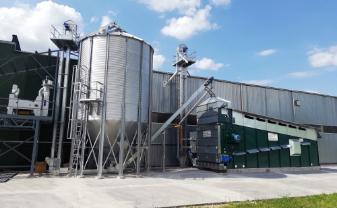

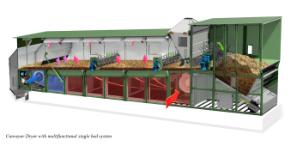

Chris Pennell and Roger Wilkinson.
For any queries please contact –info@alvanblanch. co.uk
#wedryeverything
Farming
| YAMS



LWC LAUNCH NEW FLAGSHIP
TheNEWHigh-Tipbucketwill be on display at YAMS 2024 on stand - G1 andboasts an impressive3.02mtr3capacity.
LWC now proudly manufacture buckets in the UK from a 3' widthskidsteer bucket through to the largest 9' width telehandler bucket. LWC manufacture products for all applications with
the new High-Tip bucketaimed at high capacity telehandlers and loading shovels.
LWC HIGH TIP BUCKET 8.6' X 106 CU/FT
Holds 2200 kg of wheat based on an 85% fill.
• Bolt-on brackets included
• Bolt-on bucket edge included
Farming
| YAMS

FLAGSHIP HIGH-TIP BUCKET
• Curved bucket sides
• Heavy duty design - 12mm thick Grade S355 rear frame for maximum strength
• Rubber stops for soft close
• Double hydraulic rams
• Remote greasing points
• Manufactured in the UK by LWC (Leeds Welding Co.)
• Perfect for tipping into high sided trailers
https://lwcgroup.co.uk/
Farming
| YAMS
Go Dutch at YAMS
Grimme UK is encouraging carrot and parsnip growers to ‘Go Dutch’ at this year’s Yorkshire Agricultural Machinery Show (YAMS)
Visitors to Grimme UK’s stand at the York Auction Centre on 7th February who order a new carrot or parsnip crowner will be able to take advantage of a 50% deferred payment on the ASA-Lift CR-1510, effectively going Dutch!

Furthermore, orders for carrot and parsnip machinery received after the show but before April will receive an additional early order discount.
The latest version of the ASA-lift CR-1510 offers a 150cm cutting width, with the cutting depth hydraulically adjustable from the driver’s cab. The machine’s support wheels in front and behind the four hardened conical discs ensure
Farming | YAMS
a constant cutting height, whether running on ridges or in beds.
Carrot growers will also be able to find out more about Grimme’s vegetable Varitron 270 harvester, which features a twin hedgehog 150cm wide intake at the front and a multiseparator specifically tailored to carrots.
“YAMS is a really important event for Grimme UK, and with 90% of UK growers already
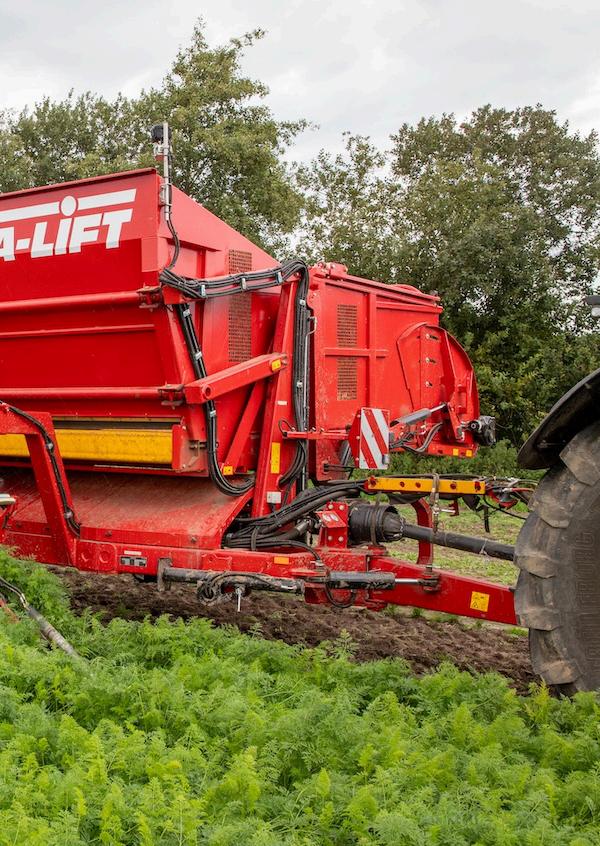
relying on Grimme and ASA-Lift harvesters to gently lift their crop, we’re looking forward to catching up with lots of existing customers and meeting some new ones,” says Nathan Hotchen, Grimme UK’s Sales Manager. “Since announcing our New Year Deals, we’ve had a very positive response, and we’re expecting a lot of visitors to the York Auction Centre to be interested in going Dutch with us!”
Farming | YAMS


Farming | Mental Health




Farming 08001884444 Farmingcanbe tough. Callourfree,confidential24/7helpline: RABIisalwayshereforyou


Farming | Mental Health

Farming | Mental Health


y name is Alice Montgomerie, and I am a fifth-generation farmer in the Southeast, based in Kent. Other than convincing myself I was going to be the first human to fly with cardboard wings at 5, I always knew the farming industry was where I would find myself. Reflecting on my ‘why’; I live 18 miles as the crow flies from Hyde Park, and the South-East in 2024 is pretty built up, so being one of very few children from a rural background at school I have first-hand witnessed the disconnect with food the modern British public finds itself in, not to mention the looks of horror when my late card from Mum said ‘sorry, too many sheep lambing and Alice had to help’. The environmental crisis, in my lifetime, has also been a fundamental topic of conversation at Government, Industry and Public level. To me, and most of those that work in our industry, we are in no doubt that British farming and the environment go hand in hand, yet somehow this message has been lost

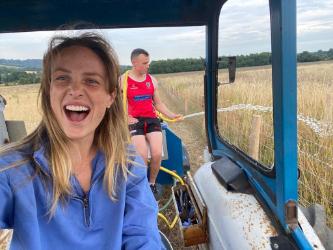


in translation to many of our consumers, and often we find ourselves faced with criticism and blame for much of climate change. The lack of understanding on where our food comes from and the role that British farming has to play in protecting our environment for generations to come has been the driver in my passion for producing quality British products and dedicating some of my time to educating those from different backgrounds on why they should care about the food that’s put in front of them every single day.
My Mum’s side of the family farm locally on a mixed 900-acre farm, whilst I have taken on from my Dad who decided farming wasn’t for him many years ago. I therefore found myself coming home to a lovely plot of roughly 70 acres in the summer of 2019, but no existing business other than a few rapidly depleting buildings, no machinery, tools or kit. Starting from scratch comes to mind! This means both my partner, Jack, and I continue to work our full-time corporate jobs to fund the rather odd hobby that sees us, at times, working late into the night and at weekends. Fortunately, Jack is a land agent practicing in the south-east and I work for the NFU Mutual, so both play into the farming side quite nicely.
Although a small farm and young business with plenty of setbacks, we have spent the last few years slowly investing in the likes of fencing, grass and hedges through the support of
Farming

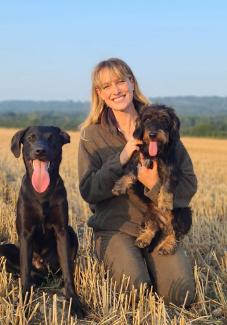


Countryside Stewardship schemes amongst some other smaller projects, whilst also planning for the sort of business we want to create longer-term. Realistically, with our size, location and abundance of footpaths around us, diversifying into hospitality is the most natural way to go. To me, this is a great opportunity to educate those around us on what it really means to choose British. We also have a flock of coloured Ryeland’s which we have built up from 3 to 11 over the last couple of years and Jack is into his deer stalking, particularly with the overpopulation of fallow in the south-east. In the near future we hope to start selling meat boxes locally of both lamb and venison.




Always one to stay busy, in 2019 when the NFU started their Farmers for School’s programme, I jumped at the opportunity. This has taken me to several inner-city schools, No. 10 Downing Street and most recently LAMMA, again with school children from urban backgrounds. I find this incredibly rewarding as most have never set foot on a farm before and are the consumer of tomorrow. Many of the children often have pre-conceived ideas of what a farmer looks like, so for me, as a young female in her mid-20’s, I find it especially important to challenge that perception. As ambassadors, if we can change or inspire even a few young minds, then to me that’s a job well done.
I’m particularly interested in the link between our mental & physical health with eating good food that isn’t pumped full of antibiotics or growth hormones, sprayed with chemicals we haven’t seen in the UK for years or reared in sub-standard welfare systems, as well as the endless benefits of spending time in nature and natural light. There is an abundance of research coming out on these topics and again I think it’s an opportunity for us in the UK to grab hold of and demonstrate how well we do things at home. How exactly, I’m yet to figure out!
Whilst I think the industry is at a time of challenge and change, I’m never happier than when I’m outside, in the knowledge I’m doing my bit to educate our public and protect our environment.
Follow Alice’s journey on instagram: @twowanderingfarmers

Farming
Powerlift performance from Börger’s super strong mobile separator


örger’s BioSelect, which is designed for the easy and highly effective separation of slurry at farms and biogas/AD plants, is now available as a tailored mobile unit.
Suitable for a car or truck trailer, the new Powerlift Separator can be built (capacities between 25 m³/h and 150 m³/h), to suit a specific application(s).
The entire mobile set-up, including feed-pump, macerator, liquid-phase pump, control technology, as well as the Separator, is all designed and manufactured in one, compact unit by Börger.
The Powerlift can be extended hydraulically to a discharge height of more than 4.30m, so that even large dump trucks can be filled easily.
The Börger rotary lobe pump (benefitting from Maintenance-in-place) feeds the BioSelect, and at the same time sucks the medium to be separated through the macerator (a Börger Multi-Chopper),
which then shreds the fibres, depositing impurities into the debris collector.
Achieving Dry Solids (DS) content up to 38%, the Börger Separator is load-triggered, whilst the feed pump ensures that volumes do not exceed capacity. The high-density solids-discharge-pump determines the degree of thickness, so the user can (for example) thicken 4 per cent dissolved solids (DS) content liquid into 12 per cent DS, to make it suitable for a tanker. Likewise, liquid manure and fermentation residue can be thickened to 22 per cent DS, without making any mechanical adjustments to the machine.

01902
Farming | Energy
UK
Borger
977 www.boerger.com uk@boerger.com
798

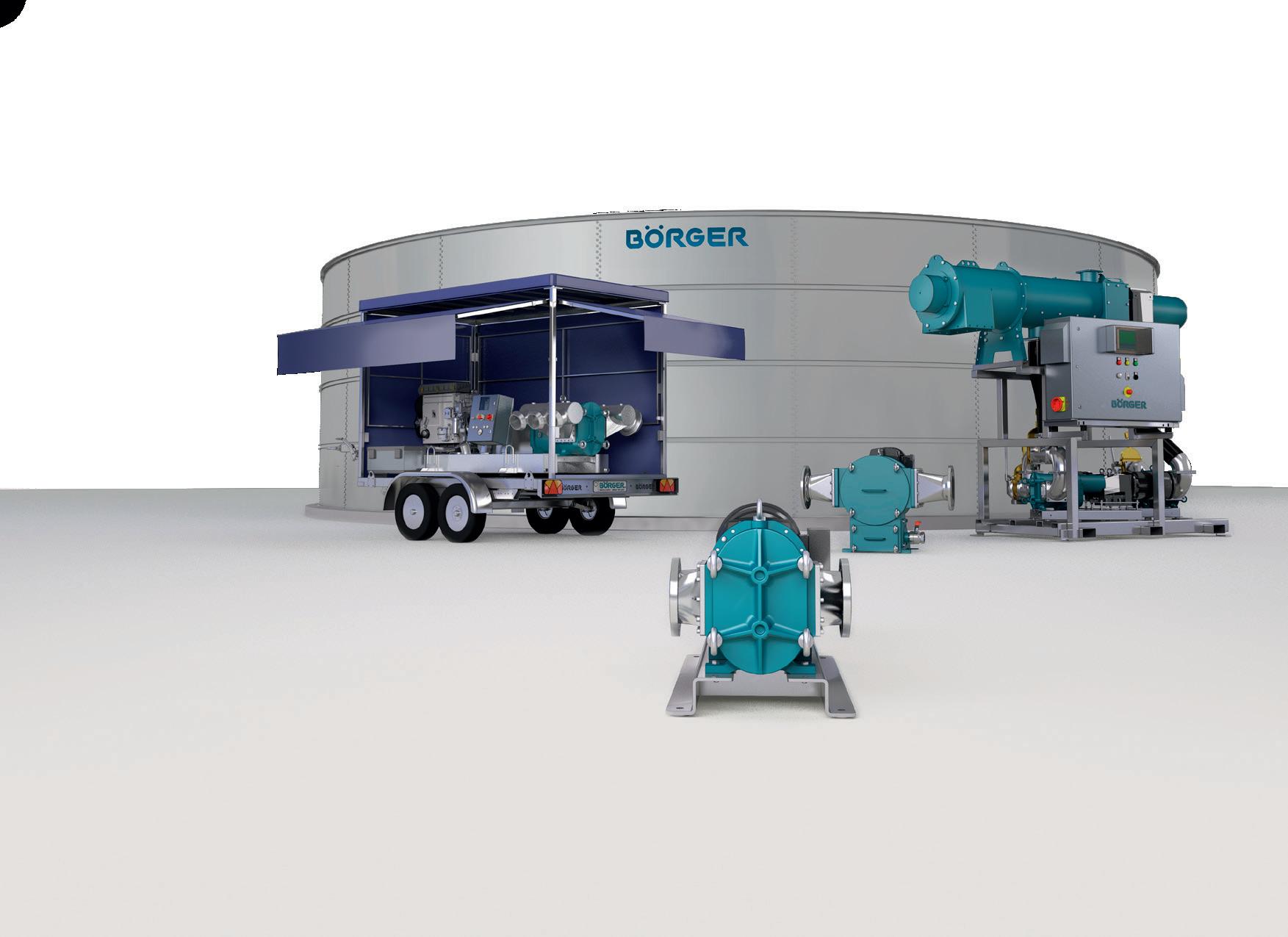
Farming | Energy Börger UK Ltd. | East Wing – Old School | Watling St. Gailey | Staffordshire | +44 1902 798977 | uk@boerger.com www.boerger.com • Rotary lobe pumps • Separation technology • Stainless steel tanks • Agitator technology • Macerating technology • Liquid feeding technology WE DELIVER SOLUTIONS. OTHERS TALK. WE DO IT. EXCELLENCE – MADE TO LAST WE DELIVER SOLUTIONS. 220615 ANZ_UK_BoergerProducts 170x125 mm_RZ_01.indd 1 15.06.2022 13:21:09

ince the commencement of my mission at the ORLEN Group, I have operated under the steadfast belief that mediocrity is not an option. I can now proudly say that, through collective efforts, we have successfully secured our place as a fully-fledged member of the premier league of Europe’s major players,” declares Daniel Obajtek, CEO and president of the management board of ORLEN S.A., in his introductory remarks to our latest report titled“Multi-Energy ORLEN. The Company’s Growth from 2016 to 2023.”In this comprehensive publication, ORLEN delineates its key initiatives and triumphs over recent years,which have been instrumental in achieving our strategic objective: the establishment ofCentral Europe’s largest fuel and energy group, with diversified operations,a robust business model, and the capacity to execute billions of euro worthof energy security and transition projects across the region.
In recent years, the ORLEN Group has taken on the challenge of merging several companies crucial for the energy security of Poland and the region. The successfully completed mergers with Grupa LOTOS, PGNiG, and Energa have laid the foundation for building a strong, multi-energy group with diversified operations - ranging from upstream activities to crude oil processing and energy production, and up to comprehensive wholesale and retail business. This growth trajectory has also been consistent with the global trends of moving away from energy production based on a single fuel towards a more sustainable mix, with a predominance of renewables.
As a result of these mergers, ORLEN has evolved into a corporate group with a potential comparable to that of other leading European companies in its sector, such as Repsol or ENI. In the S&P Commodity Insights Top 250 Global Energy Company Rankings for 2022, which included the largest 250 energy companies globally, the ORLEN Group ascended from the 60thto the 37thposition. In last year’s edition of the prestigious American Fortune magazine’s list of the largest 500 companies in the world by revenue (Fortune Global 500), ORLEN ranked 216th, surpassing corporations such as Airbus, IBM, or Bayer, a significant improvement from the 454thposition in 2015. Moreover, in the
Fortune 500 Europe, announced for the first time in November 2023, ORLEN was placed 44th, making it the highest-ranked Polish company.
ORLEN is also the first fuel and energy company in Central Europe to have committed to achievingcarbon neutrality by 2050. To deliver such an ambitious objective, substantial investments are essential. The scale of the capital projects undertaken by ORLEN in this area is best illustrated by figures alone - in 2016, the Company’s capital expenditure amounted to approximately PLN 4.7 billion, rising to PLN 19.7 billion in 2022, and standing at PLN 20.4 billion after the first three quarters of 2023.
The growth of the ORLEN Group goes hand in hand with the increase in raw material and fuel security for Poland and the entire region. It was thanks to the completed mergers and effective building of business relations across the globe, among other factors, that we were able to maintain stable supplies of fuels and energy to customers throughout the pandemic and following the outbreak of war in Ukraine. During this time, we broke away from the Company’s legacy dependence on Russian crude oil, which as recently as 2015, accounted for nearly 100% of the oil reaching the ORLEN Group’s refineries. Our current import portfolio is well diversified, including crude oil supplies from the North Sea, West Africa, the Mediterranean, the Persian Gulf, and the Gulf of Mexico.
Additionally, we have successfully diversified natural gas supplies to Poland. In 2015, deliveries from Gazprom represented closeto 90% ofPGNiG’s gas imports. A mere year later, in 2016, the first shiploadof liquefied natural gas from a different source arrived at the President Lech Kaczyński LNG Terminal in Świnoujście on the Baltic Sea. Since then, LNG has accounted for a steadily growing share of imports, and in 2022 it became the main source of gas for Polish consumers. In the same year, the Baltic Pipe gas pipeline was launched, connecting Poland with the Norwegian Continental Shelf, where ORLEN has extensive hydrocarbon production operations. As a result, since 2023 Poland’s economy has been fully independent of oil and gas supplies from Russia.
The key to successful business development lies not only in ensuring stability but also in the readiness to embrace state-of-the-art
Farming | Energy
technologies and solutions. Over the last eight years, ORLEN has made significant investments in various green energy projects, including offshore and onshore wind power, solar photovoltaics, biogas and biomethane, biofuels, electromobility, and hydrogen. The Group’s capital expenditure in 2023-2030 is planned to reach a total of PLN 320 billion, of which as much as 40% will be allocated specifically to carbon emission reduction projects, i.e. the development of renewable energy assets. In 2023, the ORLEN Group made a final investment decision on the construction of Poland’s first offshore wind farm, Baltic Power, which by 2026 will achieve the capacity to feed nearly 1.2GW of clean energy into the country’s power grid, sufficient to meet the demand from 1.5 million households. Furthermore, to ensure the availability of adequate installation infrastructure for the offshore industry, the Company has also begun the construction of a dedicated installation terminal in Świnoujście.
“After completing the series of mergers in February 2023, we revised our ORLEN2030 strategy, stepping up capital expenditures from PLN 140 billion to PLN 320 billion. One of the pillars of the ORLEN Group’s futurewill be green projectssupporting our journey towards net zero. We plan to spend PLN 120 billion on those initiatives by 2030. ORLEN is at the forefront of the energy transition, which is essential for maintaining the competitiveness of Poland’s economy. At the same time, while effectively implementing our ambitious investment strategy, we remain committed to sharing profits with the shareholders,”said Daniel Obajtek.
In 2023, ORLEN distributed a record dividend of PLN 6.4 billion. Thisenhanced capacity for profit sharing is one of the outcomes of the process of building a multi-energy group.
In recent years, the ORLEN Group has also progressively strengthened its position in the biofuels segment. In 2018, it adopted the“Biofuels Programme”, which aims at a tenfold increase in the Company’s biofuel output- to 3 million tonnes by 2030. More than PLN 15 billion has been earmarked for achieving this target. ORLEN’s biofuel projects, which aresited in Poland and the Czech Republic, contribute to job creation and stabilising demand for farming produce used as feedstock.
In building a robust multi-energy group, ORLEN engages in new business activities while honoring its roots. Accordingly, in 2021, the expansion of the Płock Production Plant’s Olefins III complex was commenced, representingthe largest petrochemical investment project in Europe in the last 20 years. Once upgraded, the facility is expectedto
contribute approximately PLN1billion PLN to ORLEN’s annual operating profit and, thanks to the application of state-of-the-art technologies, to help reducecarbonintensity - ultimately by up to 30% per tonne of output. TheOlefinsIII complex expansion project is slated for completion in 2027, positioning ORLEN as a likely leading player in the regional olefin market, controlling about 40% of olefin production capacity in the region.
Over the last eight years, the Group has also been intensively developing its retail segment. In line with our strategy, we aim to boast a portfolio of at least 3,500 modern service stations operating under the ORLEN brand across Poland and the wider region by 2030. As a result of numerous investments and acquisitions, including the takeover of Austria’s third-largest network of retail fuel assets, we have already achieved more than 98% of this target.
Following the rapid upscaling of our operations and thanks to our unwavering commitment to investments, the ORLEN Group has become the largest taxpayer in Poland, contributing billions of złoty to the state budget. “I take pride in highlighting that ORLEN stands as the foremost corporate income tax contributor in Poland. Our tax liability for 2022 amounted to a substantial PLN 4.37 billion. Just under a decade ago, in 2016, this figure stood at PLN 1.14 billion. This serves as compelling evidence of the positive trajectory we are on. In the first six months of 2023, the Group paid PLN 36.5 billion in various charges and dues to the state budget and local governments. This money contributes to the modernisation and ongoing enhancement of the living standards of citizens throughout the country,”notes Daniel Obajtek in the latest report.
Another effective tool supporting our Group’s business objectives is its sponsorship activities. In recent years, ORLEN has collaborated with professional athletes and para-athletes and engaged in initiativesdedicated to improving the conditions for practising sports for a total of 300,000 children and young people. Moreover, the Company has partnered with cultural institutions and sponsored important community projects.
** To access the entire report“Multi-Energy ORLEN. The Company’s Growth from 2016 to 2023”, please visit: orlen.pl/multi-utility-orlenreport
Source:PKN ORLEN
Farming | Energy


anish multinational Ørsted has reduced its targets for installing renewable capacity by 2030, coupled with a downsizing of its workforce, in a bid to rebound from a financially challenging year.
Ørsted had been planning to operate 50GW of renewable energy capacity by 2030 but has scaled back its forecast to 35-38GW.
As a result, the company expects a reduction in its workforce, with approximately 600-800 positions set to be cut globally.
Nearly 250 positions are slated for elimination in the upcoming months.
Moreover, Ørsted has suspended dividends, with plans to reinstate them from the fiscal year 2026 onwards.
The company also aims to accelerate its divestment program, aiming to generate approximately 115bn Danish kroner by 2030 through farm-downs and divestments, with a considerable portion expected between 2024 and 2026.
After nearly a decade in the position, the company’s chair, Thomas Thune Andersen, will

step down following the departure of two senior executives in November.
The announcement comes after Ørsted faced challenges, especially in its US offshore projects, last year. These challenges led to significant impairments and additional costs due to terminated contracts, affecting the company’s credit metrics.
Ørsted terminated two significant offshore wind farm projects in the US, the Ocean Wind I and II schemes, citing a substantial increase in costs. This decision resulted in a financial setback of 28.4bn Danish kroner (£3.3bn) for the company.
Ørsted Group’s president and chief executive officer Mads Nipper said: “Despite a year with strong underlying business progress, 2023 marked a year with substantial challenges for Ørsted.
“We’ve revisited our portfolio to prioritise growth options with the highest potential for value creation and at the same time reduce risks in the development and execution of our projects. We remain optimistic about the future of the renewable energy industry.”
Offshore wind industry faces headwinds
Farming
| Energy

In December of last year,Ørsted confirmed its investment in the Hornsea 3 wind farm in the North Sea, aiming for completion by late 2027. With a capacity of 2.9GW, this project is set to become the world’s largest offshore wind farm.
However, costs and supply chain challenges loom over the industry, with developers in the UK, EU and US pausing or cancelling projects due to rising supply chain costs.
These increases, partly due to soaring energy and commodity prices and ongoing disruptions from Covid19, have impacted growth prospects.
For example,Vattenfall suspended its Norfolk Boreas project in the UKlast June due to similar supply chain concerns.
Additionally,the Contracts for Difference (CfD) auction round in Septembersaw a record number of clean energy projects secure funding, but no offshore wind projects had bids accepted, reducing total capacity. Responding to pressure,policymakers elected in November to boost the maximum strike price for offshore wind under the CfD scheme.
Furthermore, a shift is coming for offshore wind developers in the UK. Starting in 2025, they will be compensated not only for delivering low-cost clean energy but also for broader socio-economic benefits.
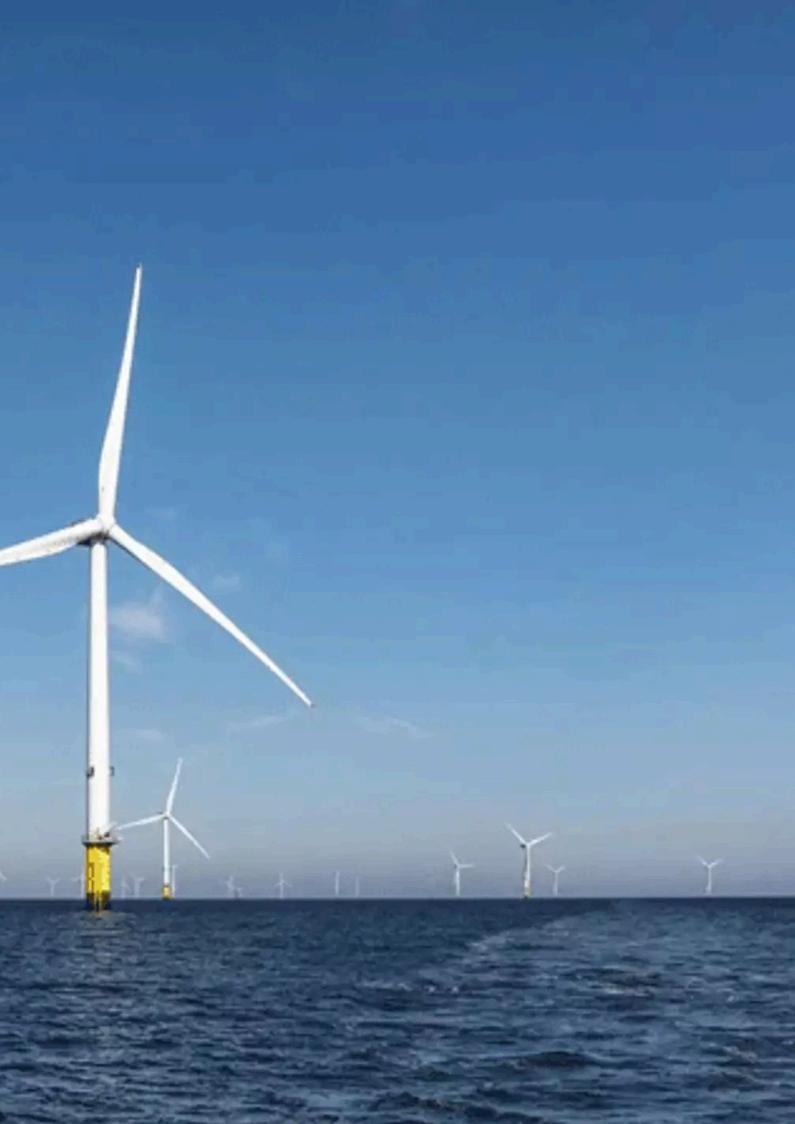
Farming
| Energy
EU’s renewable energy rollout at risk due to grid connection delays

nvironmental think tank Ember has cautioned that while the EU recorded an unprecedented reduction in coal and gas power alongside a surge in renewable energy generation last year, grid connection delays can hamper the EU’s progress in the long term – where Ember believes the UK could serve as a benchmark.
That is according to environmental think-tank Ember’s recent‘European Electricity Review’ report, which analyses full-year electricity generation and demand data for 2023 in all EU-27 countries.
According to the report, fossil fuel generation in the EU experienced a 19% drop last year, with coal hitting its lowest level ever at 333 terawatt-hours (TWh), comprising just 12% of the EU’s power.
Meanwhile, wind and solar power saw unprecedented growth, collectively reaching a record 27% of EU electricity generation.
Renewables as a whole surged to a new high, constituting 44% of the EU’s power, with hydro power rebounding from 2022 lows.
The EU’s energy security plan, REPowerEU, forecasts that renewable sources will account for 72% of power generation by 2030, an increase from 44% in 2023. This shift is primarily propelled by the expected doubling of wind and solar energy, from 27% in 2023 to 55% in 2030.
Ember’s Europe programme director Sarah Brown said: “The EU’s power sector is in the middle of a monumental shift. Fossil fuels are playing a smaller role than ever as a system with wind and solar as its backbone comes into view.”
Alongside clean growth, declining electricity demand played a key role in reducing fossil fuel generation.
Electricity demand dropped by 3.4% (94 TWh) in 2023 compared to 2022, marking a 6.4% (-186 TWh) decrease from 2021 levels, primarily due to decreased industrial electricity consumption.
However, such a rapid decline in demand is not anticipated to continue as electrification efforts in the EU intensify. This could add pressure on critical system-wide enablers for renewables, including grids, storage and demand-side response mechanisms.
EU grid challenges: Following the UK’s lead
Grids, comprising interconnectors, transmission grids and distribution networks, are essential for effectively integrating growing wind and solar energy capacities into the power system.
Current challenges in grid connections include prolonged queues, with network reinforcement taking five to ten years, and offshore wind farms waiting up to a decade for grid connections.
Spain, Italy, and France collectively have nearly 200 gigawatts (GW) of projects awaiting grid connection, with a similar challenge at hand in Eastern Europe, particularly in Poland and Romania.
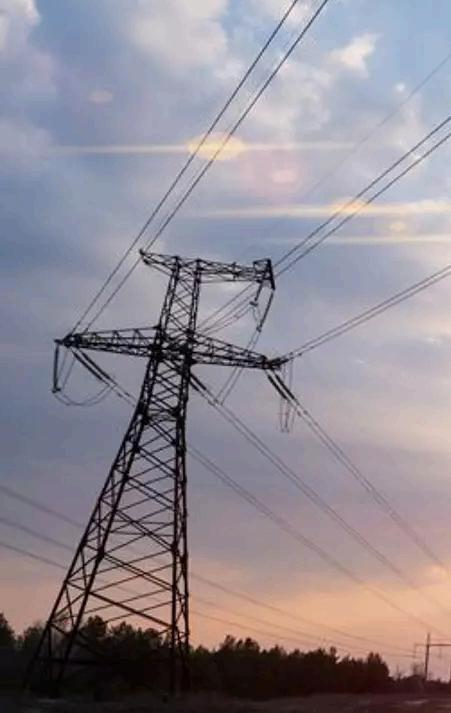
Farming
| Energy
Ember suggests that the EU could take cues from the UK, where energy regulatorOfgem has recently introduced new rules to accelerate electricity grid connections for viable projectswhile filtering out speculative and unfeasible ones from the queue.
These changes form part of a broader review of planning policies and processes for renewable energy, undertaken by the UK Government in partnership with the likes of Ofgem and the National Infrastructure Commission (NIC).
Demand-side management
Additionally, while storage facilitates transferring supply to high-demand periods, demand-side management allows shifting non-critical consumption during grid constraints, offering consumers greater control.
The report underscores the UK’s effective demandside flexibility as a model for the EU to enhance system resilience.
The Centre for Net-Zero projects that by 2030, the
UK must increase demand flexibility from the current 6GW to 20-30GW.
From November 2022 to March 2023, the National Grid ESO implemented itsDemand Flexibility Service, prompting electricity suppliers to request customers to reduce consumption during specified hours.
Households were incentivised with payments ranging from £2 per kilowatt-hour (kWh) to £4/kWh, significantly higher than the standard electricity unit price.
This initiative successfully shifted 2.9 gigawatt-hour (GWh) of electricity demand away from peak periods, enabling consumer action to meet 100% of grid requirements during times of high demand, thereby reducing strain and emissions.
SolarPower Europe’s chief executive officer
Walburga Hemetsberger said: “We can’t afford to be complacent about growth. Policymakers and system operators must work to ensure that the grid is ready.”

Farming
| Energy
WELTEC BIOPOWER develops new, intuitive user interface for biogas plant control systems

he biogas plant control system from WELTEC BIOPOWER is receiving a general update: This includes new functionalities for process optimization as well as a user interface that provides a quick and comprehensive overview of the entire plant thanks to a symbolism designed according to the latest findings and clarity in the display. The control system sections previously known as LoMos and CeMos will also merge under the new name WB Control in future. WB Control can be used for both small and complex industrial systems.
The web-based software gives operators complete and fast access to all important system parameters. A customisable dashboard provides a quick overview of the most important process data at any time. Several users can access WB Control simultaneously.

loads is achieved, for example, through overviews of the agitator intervals. This allows agitators to be controlled individually.
The intuitive, logical navigation through the software offers maximum transparency and security for an efficient workflow. „The increased requirements of plant operators and investors for comprehensive and clear monitoring of plant data, especially for continuous process optimisation, were the guiding principle for us when designing the modern control system,“ emphasizes Wolfgang Bokern, Head of Technology at WELTEC BIOPOWER.
Diagrams and reports can be created individually according to defined values and summarized into daily, monthly or annual overviews at the click of a mouse. Optimum energy planning to avoid peak
The new user interface enables a wide range of business evaluation options, such as trend analyses and other graphical evaluations of individually defined values such as consumption data or production figures. Thanks to the archiving and export functions, all data is available at any time as proof for authorities, banks and external experts.
Newly integrated functions such as FellowFeed and GuidoFill simplify the feeding process and make everyday work easier. FellowFeed measures the target filling level of the gas and automatically adjusts the feeding quantities if required. GuidoFill provides operators with a tool that supports the correct filling of their solid matter feeders with a mixture of input materials. On the basis of job lists, pumping and feeding processes can be precisely timed and displayed using the filter function. Overviews of gas management and water distribution allow other material flows in the system to be monitored.

Individually configurable alarm management informs users immediately in the event of system malfunctions. This allows the operator to react quickly and the WELTEC BIOPOWER service team can connect to the control system at any time via remote control to resolve any malfunctions that arise.
Farming
| Energy



ollowing last year’s great response to ourBiogas PowerON 2023withover 130 participants from 22+ countrieswe’re announcing next edition, Biogas PowerON 2024, with great excitement. The conference will take place on25-26September 2024 in Copenhagen, Denmark. Our 2024 editionfocuses onexcellent speakers with highly sought presentations, interesting industry panel discussion, technical insights and many hours of networking.
In 2024, biogas continues to gaining popularity amid the energy crisis and Europe's focus on energy independence and security. The coming years mark a crucial turning point for the robust development and scaling up biogas production. The green transformation aahead promises to enhance economic growth, security, and climate action for Europe and its partners. Initiatives like The Biomethane Industrial Partnership (BIP), launched on 28 September 2022, aim to support the EU's target of achieving 35 bcm annual sustainable biomethane production by 2023, laying the groundwork for a sustained ramp-up of biogas potential towards 2050. Biogas stands out as a cost-efficient solution to reduce imports of natural gas from Russia, requiring an estimated EUR 37 billion investment over the period.
Exclusive Site Visits 24 September 2024
The day before the main event, on 24th September 2024, a limited number of conference participants will have a unique opportunity to visit the two stateof-the-art Solrod Biogas plant and Biogas plant in Midtfyn. The tour is organized thanks to Nature Energy and Solrod Biogas.
Register your attendance when booking for the
event. There is no extra charge for the site visit and the spaces are allocated on first come first served basi
Main topic & key points
• Overview of European and national policies and regulations
• Revitalizing Green Energy: The Impact of the Revised Renewable Energy Directive on Biomethane
• The status of the BIP in shaping European regulations
• Reflecting on the 35bcm target: Assessing progress and future directions postRePowerEU
• Securing Sustainable Growth: Financing Strategies for Biomethane Innovation
• From the plan to the full scale production – how to plan and execute succesful biogas project
• Role of gas infrastructure in decarbonising EU energy sector
• The newest technological advancements in Biogas to Biomethane Upgrading
• BioLNG production: what makes a viable case vs. grid injection
• Hydrothermal gasification and 2G biomethane production production: status on technologies
• Challenges and opportunities faced by biogas producers
• The latest solutions ensuring the safety of biomethane production and transportation
Farming
| Energy
Polaris RANGER XP Kinetic to attend


olaris Off Road is pleased to announce its attendance at the Low Carbon Agricultural Show, wherein it will be showcasing the RANGER XP Kinetic; its latest all-electric UTV.
Taking place 6 -7 March 2024, the Low Carbon Agricultural Show is the only event focusing on low-carbon practices, technology, and energy solutions available to achieve a profitable and sustainable farming future.
Richard Coleby, National Sales Manager at Polaris UK & Ireland said:“We are really looking forward to
attending the Low Carbon Agricultural Show for the first time. It is a show that looks towards the future of sustainable farming, so it makes sense that we take our new electric RANGER XP Kinetic to showcase at the event. Not only is it completely electric, but this is our hardest-working and smoothest-riding UTV to date, so we’re looking forward to showing how it can support the farming industry in its journey to the future.”
Polaris can be found in the Low Emissions Vehicles section on stand LEV4.
Now available in UK dealers, the RANGER XP
Farming
| Energy
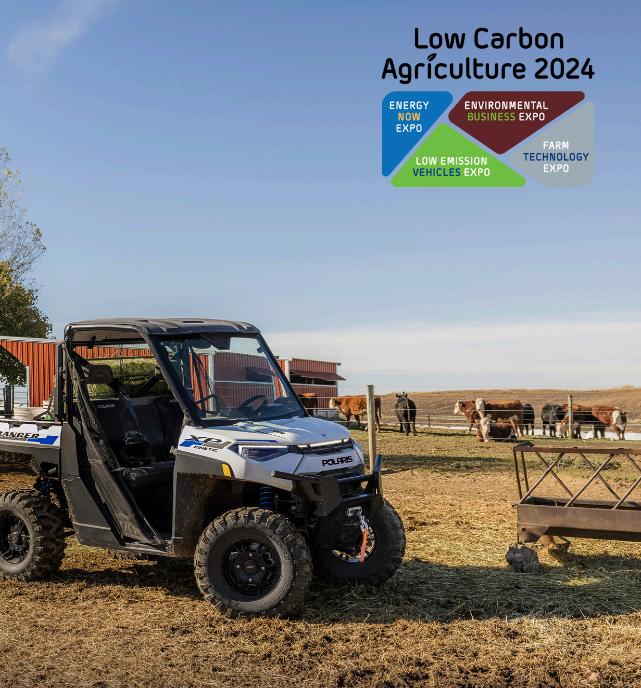
the Low Carbon Agricultural Show
Kinetic is a 100%-electric three-seat UTV with an impressive powertrain providing 110hp and 140lb-ft of instantaneous torque – the most offered in a utility side-by-side vehicle. Boasting an industrybest 680kg payload capacity and the ability to effortlessly tow up to 1,134kg the RANGER XP Kinetic makes light work of the everyday. Thanks to being fully electric, the RANGER XP Kinetic also delivers smooth, precise control when operating at low speeds, particularly useful in scenarios like towing or backing up to a trailer.
The RANGER XP Kinetic is available in a Premium
and Ultimate trim. The Premium trim features a single 14.9 kWh lithium-ion battery that offers an estimated range of 45 miles whilst the Ultimate trim has a battery capacity of 29.8 kWh with a higher estimated range of 80 miles*.
* Range estimates based on manufacturer data on typical customer driving usage and conditions. Actual range varies based on conditions such as external environment, weather, speed, cargo loads, rates of acceleration, vehicle maintenance, and vehicle usage.
Farming
| Energy attend

Building the best for your herd

ere at Graham Heath Construction we can help you build your next bespoke building, offering a range of options to create the ideal building for your herd. Building design is very important for maximizing animal comfort all year-round.
We have a number of options to help improve ventilation in the buildings and to reduce the key factors like; excess heat, vapour, dust & gases.
You need to carefully consider the roofing, ridge and cladding options for your building to suit your system and to avoid heat stress in the warmer months.
Roof and Ridge options
Fibre Cement roof - This proves to be the most popular for agricultural buildings, allowing natural ventilation and absorbing some condensation. They also come in a vast array of colour options
Light-ridge – Designed to improve ventilation in livestock buildings and improve natural light transmission. Toughened waterproof PVC roof panels and wind guide plates will withstand most weather conditions.


NEW Heat Guard Polycarbonate roof - This innovative new material is designed to help with animal welfare and energy saving benefits. With high light transmission, excellent heat reduction and thermal insulation.
GHC Raised Ridge System – This flexible system can be set at different heights to suit your cattle and system requirements. The raised ridge system allows airflow were most buildings will accumulate warm, moist and stale air. The ‘Cap’ protects the inside from the rain whilst efficiently allowing the air to flow.
Farming | Buildings


Open Protected – With importance of airflow comes the importance of natural light which this ridge system offers. With a polycarbonate strip to minimise the driving rain, allowing natural light and potential to minimize the risk of heat stress on your cattle.
Cladding Options
If
and








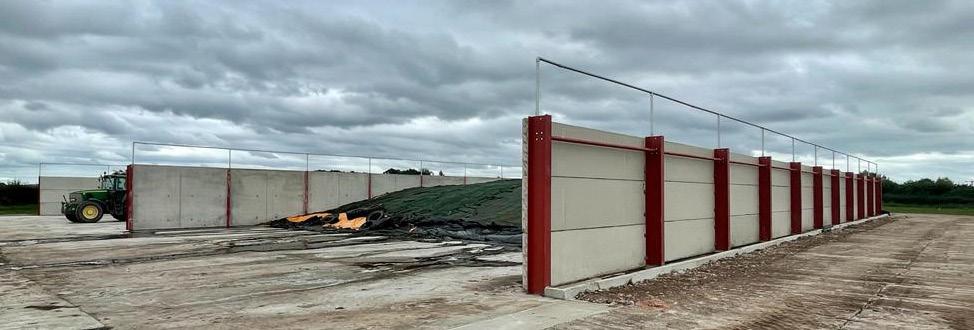


| Buildings Panel Systems Concrete @concretepanelsystems @concretepanels concretepanelsystems.co.uk 01270 258076 A LEADING MANUFACTURER OF PRESTRESSED CONCRETE PANELS & STACKING BLOCKS CONCRETE PANELS CONCRETE BLOCKS Heights : 500mm, 600mm, 750mm, 1000mm, 1200mm Thickness : 90mm, 140mm, 170mm Any length Concrete Panel dimensions: INSTOCKPANELS QUICK Lead Times even on bespoke orders Fast Nationwide Delivery Q ualityAssuredConcr e et A LEADING UK MANUFACTURER OF STEEL FRAME BUILDINGS! AGRICULTURAL, INDUSTRIAL & EQUESTRIAN BUILDINGS Q ualityAssuredBuildi n g s www.gh-construction.co.uk 20 years’ Experience Made in Britain Nationwide Delivery Bespoke Buildings 5* Customer Service 01270 781158 Call us for your free quote Scan for the latest building offers Find us on: LIVESTOCK SHED OFFER 100’ x 40’ x 15’ + 4’6’’ Cantilever From £25,500* Including concrete panels. * Ex works

currently have the following livestock building on offer 100 x 40 x 15ft Livestock Shed + 4ft 6″ Cantilever = £25,500
• Concrete
panels to
• All steelwork & timber purlins
• Roof cladding, roof lights & rainwater goods
• Yorkshire Boarding
*ex. works, doors, VAT & delivery







Farming
you’re considering a new building talk to us today for advice
Yorkshire Boarding is the most popular with livestock buildings. Installed with a 25mm-50mm gap allowing airflow through the building. Providing important ventilation in the building to help remove heat, moisture and even bugs! a free
quote
01270
781158 We
2m
Or get a quote online at www.gh-construction. co.uk/quotation/
ATVTrac Takes on Rising Machinery Theft with Innovative Solutions
TVTrac continues its mission to get farmers and landowners to take security more seriously, as machinery theft continues to rise across many regions of the country.
Aside from the very obvious and conventional reasons behind theft, longer lead times on some new machinery and therefore greater demand on the used market, has seen theft continue to increase.
NFU Mutual reported that between 2021 and 2022, there was a 34% increase in the annual cost of ATV theft in the UK alone, with the total cost of theft reaching £3m. Sheep Farmers seem to be particularly vulnerable too, with many thefts reported around the lambing season, when farmers and their machinery is very visible.
But despite this relative doom and gloom, ATVTrac continues to lead the fight against rural crime, thanks to its intelligent functionality that protects farm machinery 24/7, 365 days a year. And with ATVTrac’s flexibility as a product, the system has been developed for use on ‘Any Type of Machinery’ for landworker applications, now protecting Arborist machinery, tractors and even expensive tractor satellite systems too.
The firm’s Rupert Archer-Smith, explained, “The trend is pretty obvious when you think about it. When product is hard to come by, the thieves see a way to make money. Unfortunately, we as an industry have been too slow to respond to theft, and while our tracking product is a very real and valid tool in the fight against rural crime, so is simple education. It may sound obvious, but all too often simple actions like being aware of who is around, removing ignition keys, putting an ATV away at night or just locking it up in a barn are enough. More than anything we just need to be aware.”

Of course, there will always be the more determined thieves, which is why ATVTrac now protects many ATV, side-by-side and machinery manufacturers across the UK, and why manufacturers such as Can-AM, CF Moto, Corvus, Kawasaki, Polaris, Suzuki, Kioti, GreenMech and many others endorse ATVTrac.
With flexible installation on any type of machinery, and using multi-tier technology, ATVTrac offers real-time location information, while informing the owner of unauthorised movement through text, email and phone call.
Extra features include live tracking and machine over, helping with safety and duty of care by covering lone worker policies at the same time. Other useful functions include live battery information, service notifications, as well as journey history and usage reports.
Should a theft occur, ATVTrac has a 24-hour monitored call center to track the device, liaising with police or partner company Securitas to recover the stolen asset and return it in a hassle-free way.
On top of ATVTrac’s extensive security functionality, owners also get access to dedicated offers too, such as the firm’s current discount opportunity with brands such as Milenco, where subscribers can get discounts on accredited hitch locks, steering wheel bars and wheel clamps, while brand partner, Securitas will also join ATVTrac’s Advantage Scheme shortly too.
For more information on ATVTrac, visit www.atvtrac.co.uk and to find out more about security, download a free copy of ATVTrac’s dedicated security publication, Machine Security News, here - https://issuu.com/alltrac/docs/machine_security_ news_1
www.atvtrac.co.uk
Farming | Farm Safety & Security
CAN YOU SEE YOUR ATV? WE CAN!
hello@atvtrac.co.uk | +44 (0) 1327 317 980 (Lines open 9am - 5:30pm) ATVTrac Finance Take advantage of our 0% Finance offering, from just £39 per month for 12 months with a £52 deposit* *All prices include VAT ATVTrac Unit 1 Year Subscription Professional Installation We can see your ATV, UTV, 4x4, Forestry Equipment & Machinery Radio Frequency Tracking (RF) ATVTrac uses GPS mainly which gives accuracy down to 3 metres. If asset is stolen and ends up in a parade of garages, containers or a van - GPS devices would only be able to show rough location. Here ATVTrac can use RF (Radio Frequency) which allows us to locate down to 1 metre in garages, this is accurate enough to gain search warrants. GPS TRACKING With a minimum tracking resolution of 3m GPS is the first line of defense, taking us to the general area of your asset. 3 METRES 3 METRES RF TRACKING It’s this feature that allows us to pinpoint your asset and get the police involved. 1 METRE 1 METRE A
M Winter maintenance helps make farming safe and breakdown-free
aintaining farm machinery and buildings in the quiet winter months makes farming safer and reduces breakdowns, says NFU Mutual Risk Management Services and the Farm Safety Foundation.
Thorough overhauls of farm kit, from combines and balers to trailers and loaders, avoids valuable time being lost doing repairs out in the fields during busier seasons.
Incidents can also be prevented if essentials such as trailer brakes are kept in good condition.
With long lead times on many replacement machinery parts, it now makes sense to get repairs and maintenance done well before machines are needed for field work.
Evita van Gestel of NFU Mutual Risk Management Services suggests farmers schedule machinery and building maintenance tasks over the quiet winter months to make the best use of time and ensure all essential checks and repairs get done.
"On many farms - especially arable units - Christmas to March is a quieter time when they can carry out maintenance and repairs to machinery and buildings,"Evita said.
"Indeed, many of the famers I know would be perfectly happy spending the festive period in the workshop.
"From adjusting trailer brakes, replacing worn tines and thoroughly overhauling combines to fixing dodgy barn doors and leaking gutters, planned maintenance can save farmers a fortune.
"Scheduling the work enables you to

make the best use of the time available – and means you can save money by hiring specialist equipment like lift platforms to carry out all the farm's 'at height' maintenance in one go.
"You can save even more on hire costs if you join forces with a neighbour to split the costs and getting both farms' work done at the same time."
Stephanie Berkeley, from the Farm Safety Foundation,says that winter maintenance can save lives and reduce injuries caused by hazards such as damaged PTO shafts or guards.
"Year after year we see tragic incidents happening on our farms – some of which could have been prevented by just taking the time to stay on top of maintenance,"Stephaniesaid.
"We fully understand the pressures farmers are under every day which is why it can be a good use of time to check and maintain kit before it goes out in the fields.
"Using the quieter winter months to do those fiddly tasks you've been avoiding on buildings and machinery is great, but please do it safely, particularly when working at height.
"Every year farm workers are injured or worse when working at height so it's important to plan the job and use the right equipment. In 2022, falling from height resulted in 1,430 injuries on farms – and every year tragically causes an average of four deaths.
"It doesn't have to be a massive fall to cause a life-changing or life-ending injury when you fall onto concrete, which is why you should always resist the urge to use an old ladder or a tractor loader bucket."
NFUMutualRiskManagement ServicesWinterFarmMaintenance SafetyChecklist:
• Make sure you are competent to do the task – if there is any doubt get someone in to do it
• Use appropriate jacks and props when working under machinery
• Scrap damaged pto shafts to prevent them being accidently reused
• Use protective gloves and eye protection when using grinders and other cutting tools
• Don't carry out machinery repairs involving welders or grinders in buildings where hay or straw is stored
• Tell family members where and when you'll be working so they can find you if you don't return on time
• Keep your mobile switched on and in a chest pocket so you can reach it if you are trapped
• Don't take a chance using rickety ladders or loader buckets to do repairs at height
• Hire an access platform for a few days to get all the farm's 'at height' maintenance done together
• Make sure power tool cables are free from damage to avoid electrocution
• Don't tackle repairs that are beyond your capabilities or the safe limits of available tools
• Get loose sheets, gates, tiles and badly-fitted doors fixed before a storm causes serious damage

Farming | Farm Safety & Security Tel:01455891929 MIDBusinessCentre/SapcoteRd,Burbage,HinckleyLE102AU http://www.multiindustrialdoors.co.uk sales@multiindustrialdoors.co.uk INDUSTRIALDOORSpecialists Manufacture-Service-Installation •GalvanisedRollerShutters •PlastisolColourCoatedRollerShutters •InsulatedRollerShutters •SectionalOverheadDoors •Steel10PointLockingSecurity/PersonnelDoor •SteelFireExitDoors •FastActingHighSpeedDoors •DockLeveller/LoadingBayInstallations •PVCStripCurtains •andmanymoreproducts NationWide Service
Prevent unnecessary lamb losses this lambing season with increased hygiene levels
Lambing season is a significant part of any farmer’s annual calendar, yet the work to prepare for this important and intense time of year starts well in advance of peak springtime. It is estimated that 16 million ewes give birth in the UK every year, but still many farmers experience unnecessary lamb losses during the key season. The majority of lamb deaths happen within 48 hours of birth and each loss has been calculated to cost a farmer approximately £20 - £25, so putting simple measures in place to reduce this risk is essential.

be separated and treated accordingly, to help contain the spread and reduce contaminating other ewes and lambs.

As we approach lambing season, farmers should look to increase levels of hygiene in enclosures to prevent these losses, advises BASF’s Country Business Manager for Professional and Specialist Solutions, Laurence Barnard:
“A focus on hygiene is one of the simplest and most economical ways to reduce the spread of disease and promote healthy conditions across farms and in lambing sheds. More frequent and thorough use of disinfectants is one of the easiest ways to reduce lamb losses throughout the lambing season,” he says.
To effectively use disinfectant in your lambing sheds, Laurence suggests the following approach:
1. Thoroughly disinfect all accommodation before the start of lambing. This is best achieved by pressure washing the sides and floors of pens with a quality bactericidal detergent before spraying with a disinfectant.
2. Before lambing season begins, ensure any sick ewes are penned separately from the main flock. Similarly, once lambing begins any lambs that show signs of disease or illness should also
3. Bacteria, viruses and other microorganisms are often present on clothing and boots. Those working with birds should wear clean overalls and dip boots in disinfectant to reduce the risk of introducing harmful diseases. Before entering the shed, it is also good practice to wash hands with an anti-bacterial soap, especially when examining ewes or lambs and assisting with lambing.
4. Any equipment that is being used in conjunction with lambing should be disinfected in a solution of Sorgene Xtra before being used. Farmers should use a clean bucket and a solution of 1:250 of disinfectant to store water bowls, teats and milk dispensers. Solutions should be changed frequently to prevent the build-up of bacteria.
5. Pens should be mucked out and disinfected regularly, ideally after each ewe. Old bedding should be removed and replenished with generous amounts of fresh bedding every day.
Disinfectants like Sorgene® Xtra can be used for general hygiene, spraying or specific disease control depending on the concentration used and application techniques.
Laurence adds: “Sorgene® Xtra is a *DEFRA-approved, broad spectrum environmental
disinfectant, which contains a stabilised blend of peracetic acid and hydrogen peroxide. It is effective against viruses, bacteria, and hard to kill fungal spores.”
It can be used at 1:250 for general hygiene 1:200 for lambing pens, and at 1:100 between lambings, for foot/wheel dips and vehicle spraying. What’s more, it breaks down after use and leaves no residue, so no rinsing is necessary, and all sheds and pens can be restocked soon after application.”
“These simple steps and effective tools will help reduce the spread of disease that may result in unnecessary lamb losses and prevent farmers suffering substantial financial losses, as well as protect their ewes and lambs,” concludes Laurence.
*DEFRA approved against Foot and Mouth disease, Swine Vesicular disease, Poultry diseases and General Orders. Please refer to the product label for details.
For more information about Sorgene Xtra, please visit https:/ /www.pestcontrol.basf.co.uk/en/ Products/Overview/ Disinfectants/Sorgene-Xtra.html
Farming
| Livestock
British Pig & Poultry Fair opens new doors
Pig, poultry and egg producers have the unique opportunity to come together this year to hear the latest ideas, gather advice and see new innovations at the biennial British Pig & Poultry Fair.

Attracting over 7,500 visitors and more than 330 exhibitors, the Fair – which has almost sold out of stand space - moves to a new venue in 2024; the National Exhibition Centre (NEC) in Birmingham. “The central location, excellent transport links and first rate facilities mean the Fair will be able to thrive both this year and in the future,” says event organiser Alice Bell. “We are delighted to have secured a new home for what is such an important event for the industry.”
The Fair, which is partnered by ABN, will take place on Wednesday 15 and Thursday 16 May, and will feature dedicated forum theatres with high-profile expert speakers. Both the pig forum theatre; partnered by AHDB, and the poultry and egg forum theatre, will include much-anticipated sector outlooks, giving producers an insight into what the future holds for different parts of the supply chain.
“There will also be expert speakers covering technical topics like nutrition, animal health and welfare, and business efficiencies,” says Danny Johnson, general manager at ABN. “As ever, there will be plenty of new innovations to explore, and a wide variety of supply businesses exhibiting. For pig and poultry producers, this is always the key event to attend to catch up with old friends and new suppliers, and to discuss the challenges and opportunities facing each sector.”
The event has long been renowned as the place for producers to find the latest ideas and solutions to take home and implement on their own farms. Some 78% of visitors in 2022 planned to make changes to their business as a result of attending, and 93% rated their visit as good or excellent.
“This year we have a new innovation theatre, which will be a chance to hear the latest thinking and to discover new products to help your business to thrive,” says Ms Bell. “There really is nowhere else to hear from so many experts, meet leading producers, see suppliers, and find out what is new, all in one day, under one roof.”
To find out more and to register for your FREE ticket visit www.pigandpoultry.org.uk




Farming
| Livestock
Elta sets roadmap for international expansion and new era for 'Air Movement, Air Quality' in 50th anniversary year

This new year marks the start of a new era for Elta as it celebrates 50 years in business and accelerates its agenda to move the dial on indoor air quality.
Major investment will be made into the company's manufacturing capabilities this year and as of this month, the business previously known as Elta Fans will be repositioned as Elta. This is a poignant branding transition for the company as it signifies an identity that better represents the company's full capability beyond fan manufacturing.
As well as its industry leading fan technology, Elta will continue to invest in its air handling units, noise control equipment and controls to provide markets with holistic solutions that futureproof against the demanding challenges of modern society. Elta's engineering expertise and bespoke manufacturing approach are both fundamental to this and will therefore see a significant investment into its factories which will help meet increased

demand for full system specifications.
Sister companies, Fantech Ventilation in Ireland and Duct Products in Northern Ireland will also be


unified under the Elta brand to create a cohesive presence across the industry and geographically.
'Air Movement, Air Quality' is the company's new mantra which will encapsulate its vision, mission and comprehensive range of solutions.
Mark Rickard, CEO at Elta Group comments: "This strapline underscores two pivotal aspects that are at the heart of our business. 'Air Movement' signifies our commitment to engineering excellence, innovation, and precision in every aspect of our products. Meanwhile, 'Air Quality' emphasises the role we play in ensuring cleaner, healthier and safer indoor environments."
Mark will be supported by his senior leadership team in embedding this new vision across the business. They include Damian Buxton, CEO and Vikrant Bhatt, Director for England, Wales and Scotland, Mark Russell, Managing Director for Ireland, and Chris Schofield, Managing Director for Northern Ireland.
Mark adds: "We're often described as the sleeping giant of the ventilation industry, which is evidenced by many companies increasing their specifications with us once through the door. Ultimately, we can build any type of fan or ventilation system required which people sometimes don't realise. We often see a simple enquiry evolve into us delivering a full solution and that's what this investment into the business is all about.
"We are well known for our industry-leading fans –a critical element of any ventilation system. However, industry professionals know that there is so much more to ventilation specification and our business is well-equipped with a wide suite of solutions and technical expertise to lead the charge on improving air quality throughout the built environment."
For more information, visit www.eltauk.com
Farming | Livestock
MOLE VALLEY FARMERS URGE THE USE OF GLOVES AT LAMBING TO PREVENT SEPSIS RISK

Mole Valley Farmers is donating money from every box of full-length gloves sold this lambing season to The UK Sepsis Trust to raise awareness of the silent killer.
Many farmers don't wear gloves when lambing sheep and could be putting themselves or their staff at unnecessary risk of contracting sepsis, an infection that claims the lives of five people every hour in the UK.
Minor skin injuries and skin infections cause about 10% of all sepsis cases, but among farmers it is significantly higher due to the nature of their work. Falls, crush injuries and needle stick injuries also considerably increase the chances of farmers contracting the infection.
Mole Valley Farmers' Senior Product Manager Trevor Frost says no farmer should be taking the risk of not wearing gloves at lambing time.
"Ask yourself, is not wearing gloves really worth the risk? So many people don't wear gloves, and they ought to. Very few farmers will calve a cow without wearing a full-length glove, yet the opposite is true when lambing a sheep.
"£20 can go a long way to getting all the gloves you need for a season, and in return, a proportion of that money will go directly to the UK Sepsis Trust to help fund the vital work of raising awareness of this deadly killer.
"This campaign isn't about raising money for our business, but simply about raising awareness of sepsis and its risks and promoting best practice," he said.
Alongside this, there will also be a focus on sepsis awareness through Mole Valley Farmers' stores, their monthly Newsletter and online platforms. "If we can help save just one life, then that's a start," added Mr Frost.
Sepsis is an illness that came to light in the farming community in 2021 when, tragically, 26-year-old Cumbrian farmer Hannah Brown lost her life to the disease.
Sepsis arises when the body's response to an infection injures its own tissues and organs. If it isn't treated immediately with antibiotics, it can result in organ failure and death.
Hannah worked at Mole Valley Farmers' Leyburn store and was well-known in the farming community and on the livestock show circuit. She left behind her Fiancé Ben Richardson, sevenmonth-old daughter Millie and parents Martin and
Val Brown.
She began feeling ill with flu-like symptoms that she initially thought were the signs of a cold. However, it wasn't until she spoke to a friend in a local shop who suggested she might have sepsis that she attended hospital. Sadly, by then, it was too late to save her, and she died in hospital.
Ben said it all happened so quickly. Speaking on a video produced by the NFU Mutual and the UK Sepsis Trust, he said: "It was all so quick and sudden. Everything turned upside down overnight, and everybody's lives have had to change to adapt to it."
Her mum, Val, added: "You don't think it's going to happen to you. If you can catch it soon enough, you can put a stop to it happening."
Following Hannah's death, her family have worked with the Trust and NFU Mutual to raise awareness of sepsis and the increased risk in farming.
Mr Frost added: "Hannah's tragic loss demonstrated that sepsis can happen to anyone and the importance of protecting yourself. Something as simple as wearing gloves could be all that is needed to prevent you from contracting sepsis," he said.
For more information about sepsis in farming or the work of The UK Sepsis Trust, visithttps:// sepsistrust.org/
Seek medical help urgently if you or someone you know develop the following symptoms:
• Slurred speech or confusion
• Extreme shivering or muscle pain
• Passing no urine (in a day)
• Severe breathlessness
• It feels like you're going to die
• Skin mottled or discoloured.
In children, sepsis symptoms could include:
• Breathing very fast
• Having a "fit" or convulsion
• Looking mottled, bluish, or pale
• Having a rash that does not fade when you press it
• Being very lethargic or difficult to wake
• Feeling abnormally cold to the touch.
Farming | Livestock
Lungworm Vaccination Crucial Ahead of 2024 Grazing Season

Dairy farmers are being encouraged to vaccinate youngstock and naïve cattle against lungworm (husk) ahead of the 2024 grazing season after a significant rise in cases in recent years.
“Cases of lungworm are on the increase and the disease is also becoming more common in adult cattle,” said Dr Kat Baxter-Smith, veterinary adviser with MSD Animal Health.
“Recent conditions have been ideal for lungworm larvae to survive in pasture for longer and to contaminate new areas – and this is likely to continue as we move deeper into 2024.”
She adds that changing weather conditions also create protection challenges for producers that rely on preventative wormers.
“Farmers across GB are now able to turn cattle out for longer – up to two months longer in some cases. Consequently, vets in practice are seeing a lot of cases towards the end of the later part of the extended grazing season when protection from preventative wormers has worn off, leaving livestock vulnerable.
ultimately starting the lifecycle over again once consumed by grazing livestock.
Dr Baxter-Smith explained that lungworm could be managed more effectively by UK cattle producers through an increased uptake of vaccination, particularly for naïve first season grazers pre turnout.
“Unlike long acting anthelmintics, which kill the parasite and reduce or even prevent ongoing exposure and necessary build-up of immunity, vaccination allows cattle to develop immunity to lungworm thanks to the use of irradiated larvae in the husk vaccine.
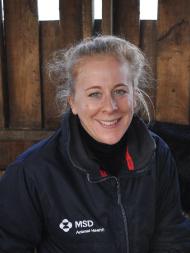

“What’s more, the use of long acting anthelmintics also limits the ability of cattle to build up immunity against lungworm as they will be exposed to fewer larvae. When cattle are then exposed to contaminated pastures, a significant lungworm outbreak is possible,” says Dr Baxter-Smith.
Lungworm infestation occurs when cattle eat grass contaminated with larvae from the worm Dictyocaulus viviparus, which migrates to the animal’s lungs. Once there, they develop into adults and produce eggs that are then coughed up and swallowed. Eggs that hatch in the digestive system are then passed out of the animal through faeces as larvae to contaminate pasture –
“When cattle receive two doses of the vaccine orally (approximately four weeks apart) prior to turnout in the spring, the irradiated larvae ingested will migrate through the lungs just like the ones cattle pick up on contaminated pasture. However, because these larvae are irradiated, they can’t fully develop, which allows the treated animal to develop protective immunity, but not infection.”


To help safeguard against financial losses from lungworm and potential developing resistance with long acting anthelmintics, MSD Animal Health is encouraging farmers to work with their veterinary professional on a farm parasite control plan before turnout.
“The most effective way to prevent lungworm infection in cattle is to build immunity through vaccination. While long-acting wormers can be used to control disease, they may limit exposure to lungworm larvae meaning calves remain susceptible to infection in future years.
“Indeed, the livestock farming industry must look at ways to minimise its use of these products to slow the development of resistance. And an increased uptake of pre-turnout vaccination against lungworm is an important way we can do this,” said Dr Baxter-Smith.
Farming | Livestock
NSA alarmed by threat of future farming proposals to Wales's livestock sector

The National Sheep Association (NSA) is deeply concerned following the release of findings from a Welsh Government impact assessment into the proposed Sustainable Farming Scheme (SFS) affecting Wales's agricultural sector.
NSA Chief Executive Phil Stocker says: "NSA is alarmed by results from the Welsh Government's own impact assessment that paints a bleak picture for Welsh Agriculture as a whole. It is incredibly damaging for an industry already under immense strain to have proposals that now seem flimsy and lacking in genuine support for a critical infrastructure sector and could threaten the future of the sector in Wales."
The modelling, undertaken on the 2022 SFS proposals as part of the impact assessment indicates the scheme would result in a 122,200 reduction in Welsh livestock units and an 11% reduction across the national flock, resulting in an 11% cut in labour on Welsh farms – the equivalent of losing a staggering 5,500 jobs based on current employment levels on Welsh farms.
Mr Stocker continues: "The magnitude of the reductions, with or without a top-up payment highlights the significant difficulties for businesses to find alternative income sources. With 12 months until the SFS introduction it feels Welsh Government is wandering blindly towards a disaster for the industry. Furthermore, any adjustment or diversification will be limited by policy constraints. There must be action now to ensure there is meaningful capacity to maintain livelihoods of those working in agriculture."
NSA Cymru/Wales Development Officer Helen Roberts adds: "The agricultural sector is operating on a knife edge with increasing pressures on the bottom line. And so it is concerning that Welsh Government is only giving businesses 12 months to consider the implications of entering the SFS, with little pilot process planned or dynamic implementation process. Modelling suggests a £125.3m hit to output from the sector, and a loss of £199 million to farm business income. NSA is concerned that if Welsh Government doesn't take action it will result in devasting effects not only on farming businesses but those that rely on them."
NOAH comment on the Government response to the GB Veterinary Medicines Regulation
We welcome the publication of theGovernment responseto the consultation on the new GB Veterinary Medicines Regulation and look forward to this vital piece of legislation being adopted. The UK animal health industry needs a robust, up-to-date regulatory process to produce the veterinary medicines necessary toprotect and improve animal health and welfare in the UK.

This not only benefits animals, but also helps to protect human and environmental health while positively contributing to societal sustainability goals.

Dawn Howard, NOAH'sChief Executivesaid: "It is good to see that, in a number of key areas that we felt would adversely impact animal health and welfare, Government has listened and responded to stakeholder concerns. For example, we welcome the modificationsmade to the labelling requirement
proposals for veterinary medicines and that POM-V medicines other than antimicrobials can continue to be advertised to professional keepers of animals.
"We look forward to reviewing the detail and commend the hard work that has been done to bring this about."
Farming | Livestock
Nutrition and breeding management are essential for cows and replacement heifers to hit reproduction KPIs

Replacement heifers and post-calving cows are under a lot of pressure to hit breeding KPIs. The benefits of Maxx Cattle Booster Plus new formulation will help achieve this.
A new formulation of Maxx Cattle Booster Plus will help support herd fertility when fed to replacement heifers and bulling cows in the run up to, and during, breeding.
According to Dr Alison Bond, nutritionist for Rumenco, Maxx Cattle Booster Plus contains Celmanax, a yeast fermentation culture, Availa performance minerals, high protein levels and easily accessible sugars. This combination of ingredients promotes rumen health, feed digestion, liveweight gain, body condition, milk production and overall performance.
These are all fundamental components to creating a sustainable and economically efficient breeding cattle system by accelerating the age at which a replacement heifer calves down and the speed at which cows gets back into calf post-calving.
“Age at first calving will have a major effect on the lifetime production of a breeding cow whether in the beef or dairy herd.
The current target for age at first calving is around 24 months of age, resulting in one more calf during their time in the herd compared to a heifer not calving down until three years,” explains Dr Bond. “Not only does this allow producers to accelerate genetic progress by making retainment decisions much more quickly, but it also maximises forage availability. Industry data from Grange Beef Centre shows that calving at three years instead of two results in a 50% lower net margin per hectare for spring calving grass-based systems.”
improvement.”
Nutritional support for improved fertility
To achieve these reproduction KPIs, nutritional support is critical.
In heifers, sexual maturity is influenced by weight rather than age. According to Dr Bond, cattle farmers should aim to maximise liveweight gain, monitoring and weighing regularly to achieve a bulling weight that is 65% of the heifer's mature weight and approximately 90% of mature weight at calving.
“This means that heifer calves must grow at around 0.70.9 kg/day. A heifer that doesn’t reach its growth target, but still conceives, will struggle to get in calf as a second calver as the pressure required on the newly calved heifer in terms of growth,” she says.
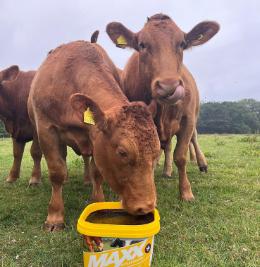

For post-calving cows, nutritional support is needed to build back and maintain body condition as the lactation period and breeding window crossover each other.
According to Dr Bond, the new formulation of Maxx Cattle Booster Plus makes it ideal for grazing and housed breeding cattle.
“A dehydrated molasses bucket made with patented manufacturing, Maxx Cattle Booster Plus has one of the highest sugar declarations on the market. This will feed rumen microbes so protein available in both the bucket and in other feed will be fully utilised,” she says.
Part of the reformulation is the inclusion of Celmanax, a yeast fermentation culture.
In the cow herd, the challenge is to have cows back in calf within 80 days of calving to maintain a 365-day calving interval. Ideally, cows will get bred around 60 days post-calving at first oestrus. Data shows that accelerating the rate it takes cows to get back into calf for tighter calving blocks has significant economic benefits. Reducing the calving period from 18 to 9 weeks can increase average calf weaning weight by 47kg, with anything extending beyond 12 weeks costing £3.55 per cow per day.
“For both replacement heifers and cows, the sustainability of resource utilisation and economic impact of delayed pregnancy is significant,” says Dr Bond. “However, current figures for the UK indicate the average calving interval to be 440 days with approximately 88 calves being born for every 100 cows or heifers. AHDB’s target is 94 calves born per 100 cows or heifers put to the bull – meaning, there’s room for
“Celmanax is a yeast fermentation culture that has been shown to improve ruminant performance by supporting a stable rumen environment. This has proven to deliver benefits to daily liveweight gain and feed utilisation,” explains Dr Bond.
It also includes performance minerals Availa Zinc and Copper, to optimise performance and feed efficiency. Availa minerals offer superior bioavailability as they bypass the rumen, and have been found to support oocyte production and embryo quality post-calving.
“When used in conjunction with good management practices, Maxx Cattle Booster Plus will help fill essential nutrient demands to meet breeding KPIs in both replacement heifers and post-calving cows,” concludes Dr Bond. “This strategic supplementation will yield a return on investment and improve herd sustainability through more efficient resource utilisation and optimised output.”
Farming | Livestock
Oregano oil and purple garlic prove perfect tonic for piglets

Oregano essential oil and purple garlic have been used by humans since ancient times for their health properties, including helping to boost immunity and improving gut health.
However, now scientists have found these ingredients could be used in pig feed as an alternative to zinc oxide, which is administered to weaning piglets to prevent and reduce digestive problems.
Zinc oxide, which is a pollutant for the environment and contributes to the development of antimicrobial resistance, is in the process of being banned in many countries.
Thestudy, by researchers in Scotland and Spain, found oregano essential oil and purple garlic offer similar or superior results to zinc oxide when added to feed in terms of the effects on the structure of the intestine, bacterial species present in the intestine and resistance to antimicrobials of indicator bacteria.
Several groups of weaned piglets received different concentrations of oregano essential oil and purple garlic powder, zinc oxide or a combination of both. A control group, which received none of these compounds in the feed, was also present for comparison.
The researchers found the piglet groups which received
the highest doses of oregano essential oil and purple garlic powder had the best results for the measured parameters, and the results were similar or superior to those for the group that received zinc oxide.
The research was carried out in the Murcia region of Spain by scientists from Scotland's Rural College (SRUC), the University of Murcia and the Institute for Agricultural and Environmental Development (IMIDA), in collaboration with the pig producing company Dalland Hybrid Espana S.A..
It was conducted on a commercial farm to replicate the conditions found in a typical farm in order to facilitate the direct application of the results.
Jorge Rivera Gomis, Research Associate at SRUC's Centre for Epidemiology and Planetary Health in Inverness, said:"The weaning period is a critical step in pig production.
"This research on the use of oregano essential oil and purple garlic powder as alternatives to zinc oxide will help make pig production more resilient and sustainable by tackling current challenges such as antimicrobial resistance; reducing environmental contamination; meeting consumer demands of sustainably produced food; and adapting to new regulations and trends in animal production."

Farming | Livestock
Five steps to better surplus lamb growth
Sheep farmers with surplus lambs to rear over the 2024 lambing season are being encouraged to make the most of these newborns’ early life growth potential to boost flock returns.

Maximising the number of lambs sold per ewe put to the ram is one of the key benchmarks for a successful sheep farming enterprise. This will mean rearing some third lambs and orphans off the ewe, explains Dr Jessica Cooke from Volac Milk Replacers Limited.


“But with lamb prices currently trending 15% ahead of last year, rearing these surplus newborns quickly and efficiently yourself to potentially target an earlier premium market makes sound economic sense.


Adams University College and Reaseheath College (2021) have demonstrated surplus lamb growth rates of over 300g per day. All lambs weighed at least 10kg at weaning at 35 days of age.
“And feeding a good quality, proven ewe milk replacer alongside good husbandry practices will help you capitalise on the lamb’s inherent early life, pre-weaning growth potential and be able to wean plenty of excellent extra lambs as soon as possible,” she says.
When it comes to rearing surplus lambs successfully, Dr Cooke advocates following five crucial steps for best results:
1. Don’t compromise with colostrum feeding
As with all newborn lambs, the first priority is to ensure every surplus lamb receives sufficient colostrum (50ml/kg liveweight per feed and a minimum of 210ml/kg liveweight within the first 24 hours). This feed provides essential nutrition, as well as the important antibodies to help newborns fight off infections.
2. Choose the optimum rearing system
Surplus lambs can be reared on milk replacer via bottle, through ad lib bucket feeding or with automatic machine feeding. The method you choose will typically depend on the number of surplus lambs you have and the facilities that you have available.
If you are using a bucket or machine you will need to train lambs to suckle the teat. Be patient. If removing a surplus (e.g. third lamb) lamb from the ewe, take it away at 24 hours old, then leave it for a few hours to become hungry before gently introducing it to the teat. Teats should be positioned 12-15 inches from the ground.
3. Trust Lamlac for higher growth rates
Feeding trials with Lamlac ewe milk replacer at Harper
Additional work at Reeseheath College in 2023 showed lambs reared on Lamlac mixed and fed cold from about a week of age to weaning, drink as much and perform as well as lambs reared on warm milk. This highlights the opportunity to rear extra lambs off ewes on ad lib cold milk where boiler heating capability may be nonexistent or compromised.
4. Feed enough milk powder
A single lamb reared artificially to weaning (at an average of 35 days of age) will require a minimum of 9.5kg of Lamlac (equating to 47.5 litres of reconstituted ewe milk replacer).
5. Get your lamb husbandry right
Lambs reared artificially will also need constant access to fresh, clean water at all times. Top quality creep feed should also be readily available to lambs and be offered fresh at least once a day, with refusals being fed to older stock (e.g. ewes). Introduce clean, dry straw –preferably barley into racks. Don’t feed ad lib high quality roughage, for example hay, during milk feeding as this can depress concentrate intake and delay weaning.
For optimum rearing results, don’t keep more than 25 lambs in a pen and keep similar ages and sizes together. Lambs must also have access to a clean, dry, straw-bedded lying area which is well ventilated but draught-free. Check your lambs at least twice a day. Finally, maintain scrupulous hygiene protocols. For example, all feeding equipment should be thoroughly cleaned each day and disinfected twice weekly.
For further information on successful surplus lamb rearing, visit: www.lamlac.co.uk
Farming | Livestock
Assess semen quality quickly and easily
Artificial insemination (AI) is an important tool for the majority of dairy farmers, but the quality and viability of the semen used can make or break a breeding season. One semen analyser tool –Dynescan - aims to provide confidence with one simple, quick test.

The Dynescan is a portable semen analyser which measures semen lifetime and quality, and provides insights into how long semen mobility can be sustained.
One vet who has been using the Dynescan is Dave Gilbert, founder of Horizon Dairy Vets. “I’ve been in practice for the best part of 20 years, and have worked with a lot of block calving herds. Semen quality is important to all dairy farmers but block calvers have always been more aware of it,” he explains.
“If there is a bad batch of semen used on an all-yearround calving herd they notice when the cows start returning, but it has a limited impact because they’ve probably only served 5-10% of the herd. But on a blockcalving herd, they’re intending to serve nearly every cow in the first three weeks, before they can even realise they have a problem, so it can have some quite profound impacts on the block and fertility.”
Analysing semen quality is not new to Mr Gilbert. “I have been asked for around 15 years now if I could look at batches of semen and get them tested.” And semen quality can vary, particularly after it has left the bull stud. “There are a number of reasons why semen quality may vary, and I have a lot of experience of frozen semen –while a tremendous tool it is quite a fragile commodity.
It’s not as simple as semen being dead or alive, there are variations between batches in terms of performance and so forth,” he adds.
“I do a lot of AI audits for handling semen, and there are several people that will handle the semen on its journey from the bull stud to the dairy. All of those are opportunities for mistakes, errors and problems to occur. Often if it’s mishandled the semen will initially be okay but die off quite quickly.”
It is possible to look at semen on-farm through a microscope, but this has its limitations, says Mr Gilbert. “It’s pretty limited; it’s by no means as good an assessment as they would do at the bull stud. But those are large, complicated and expensive pieces of equipment, so there has been a need and a gap in the market for something in between.”
This is where the Dynescan comes in. “We tested out the Dynescan with our block calvers, and I liked the system because I had a greater degree of confidence in the measurement. It ruled out the degree of subjectivity of doing things by eye, and produced something that would be repeatable.
“Our clients liked the system and its insights, which gave them confidence in the service. I think it’s a valuable tool for farmers to assess how they’re handling the semen, and for the industry.” he notes. “I believe the semen companies would far rather find out they have a problem with a batch before it has gone into 100 cows.”
For more information visit www.dyneval.com.
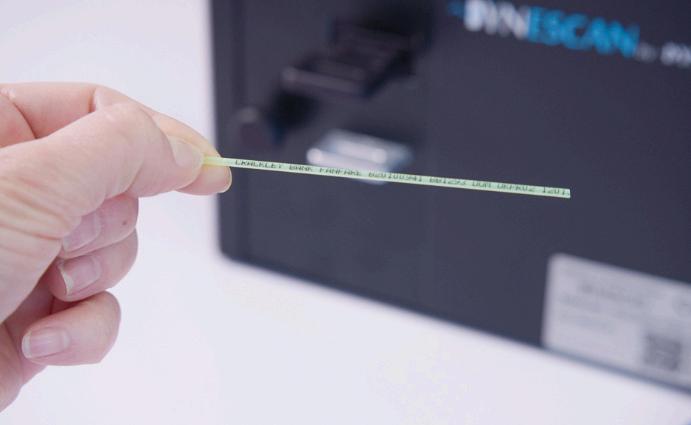
Farming | Livestock
Often overlooked bull fertility test key to maximising suckler margins
Routine testing of bull fertility is an essential but often overlooked aspect of suckler herd profitability. Yet with funding available, Beef Specialist, Sarah Balfour, is urging beef farmers to be on the front foot this season.

Suckler herd performance relies on optimal fertility, and managing and improving herd fertility is one key route to improve cow margins while also reducing the impact of beef production on the environment, says Sarah, who is based at the Elgin office of SAC Consulting, part of Scotland's Rural College (SRUC):


"Many farmers have taken advantage of the attractive cull cow price over the past 18 months, opting to cull poor and underperforming animals to improve efficiency, but how many farmers have semen tested stock bulls to identify underperforming and sub fertile bulls? Often semen testing is reactive, when a problem is suspected with a bull, but there is significant advantage to testing bulls at the start of the breeding season so you can make management decisions and get the maximum returns from that bull."
Productive herds also have less environmental impact, which helps Scotland's beef industry meet sustainability goals. SAC Consulting delivers Farming for a Better Climate (FFBC), an initiative funded by Scottish Government, to support farmers to introduce pragmatic practices on farm to both reduce environmental impact and enhance productivity.
Managing and improving suckler herd fertility strongly correlates with reduced production and environmental costs per kilogram of beef sold, says Sarah.
"To achieve industry performance targets for suckler herds, 65% of cows should be calving within the first three weeks of the calving season starting and 90% within nine weeks.
"Maintaining a compact calving period makes it
easier to manage calves at a similar age and stage. It reduces the risk of disease spread from older calves to younger vulnerable calves and makes feed rationing easier. Earlier born heifer calves are also likely to be suitable weight and age for bulling to calve at two rather than three years of age, reducing the costs of production for replacements as well as improving their lifetime productivity. Equally, the more cows in calf and the greater number of healthy calves, the better for the environment."
Using SAC Consulting data, it was shown that achieving 5% greater calf numbers - reducing barren cows and calf mortality by 5 in 100 cows bred - could improve finisher cattle sales by over 3t liveweight per 100 cows and reduce greenhouse gas emissions by 10% per kg carcase weight.
A three-year trial run by SRUC Vet, Iain McCormick, found that, on average, one in five bulls fail a fertility test, irrespective of age or breed, with young bulls failing as much as older stock bulls. With there being no guarantee that a bull will retain fertility from one breeding season to the next, it is vital you know bulls are capable of getting cows in calf, advises Sarah:
"Subfertility may be due to testicular size or sperm quality. Changes to diet can affect semen production and sperm quality. It is also important to remember that bulls sold at sales who have been semen tested can underperform, if they
Farming | Livestock
pick up an infection or have a libido problem."
Duncan Morrison farms 240 suckler cows, commercial and pedigree Aberdeen Angus and Stabilisers, with his wife Claire at Meikle Maldron in Deeside. Traditionally, they had only semen tested the pedigree Aberdeen Angus bulls produced on farm for selling, until an unexpected issue was identified during one of these tests. They now fertility test all of their stock bulls.
"I previously only semen tested ahead of sale and saw it as peace of mind that bulls were fertile, but on one occasion we picked up on an issue with a young bull," says Duncan. "He was a perfectly healthy and otherwise sound bull. However, when stimulated during the fertility test, due to an irregularity with his penis, we discovered he was incapable of serving cows. If we had not fertility tested this bull, we would not have found this out, so we now do it as standard practice."
The Morrisons' 10 stock bulls are all vet checked and fertility tested ahead of the breeding season to ensure they are fit for purpose to maintain the calving period.
"Fertility is hugely important to us as we operate a tight calving period. Bulls are only in with cows for six weeks, so it is vital to know when a bull is put in with cows that he is capable of doing the job. There is no doubt that there is real merit in
giving bulls a pre-breeding check and fertility testing."
Sarah points out that for those herds rotating bulls, the severity of bull infertility could be masked, as you may not be aware there is an issue and can still be losing performance. She encourages farmers to carry out prebreeding checks and semen tests bulls ahead of them being turned out with cows.
The Bull Breeding Soundness Examinations (BBSE) help to identify bull problems that might otherwise go undetected until pregnancy diagnosis. Ideally, a pre-breeding check should be carried out four weeks before mating.
There is funding available for fertility testing as part of the Scottish Government's Preparing for Sustainable Farming (PSF) programme. Livestock farmers can claim £250 a year for up to two animal health and welfare interventions, which includes bull fertility testing.
You can read more from Sarah about managing bull fertility in her Practical Guide on the Farming for a Better Climate website.
For more information on Farming for a Better Climate, visit www.farmingforabetterclimate .org or follow the project on Facebook and Twitter @SACFarm4Climate

Farming | Livestock
FAN optimises separation with its biggest separator - the PSS 8
With the new press screw separator PSS

8, FAN Separator is expanding its portfolio with a machine having sufficient capacity to replace two or three smaller machines, providing savings in energy consumption, manpower and peripheral equipment.
The high output of the new PSS 8, which is capable of 65cu m per hour, makes it suited to very large dairy farms wanting to ease the management, storage and field application of cow slurry, as well as for large-scale biogas production.
Separation of solids and liquids in farm slurry opens up effective and valuable options for further processing and reuse, especially as the solid material can be turned into compost or used as an attractive bedding material, particularly for dairy cows housed in cubicle sheds.
The liquid fraction, meanwhile, can more easily be
managed, stored and spread on fields as fertiliser, one option being a ‘dirty water’ irrigation system.
Designed for continuous use on large farms
With its impressive dimensions of 3.6m x 0.9m and height of 1.3m up to the inlet, the PSS 8 separator, developed for continuous operation on large farms, is an extremely robust machine.
The proven FAN press screw concept has been retained while the components have been enlarged: The 2200mm long and 350kg heavy auger is additionally supported by a head bearing. With a diameter of 400mm, the screen is also generously sized.
The built-in auger is driven by a 30kW electric motor running at 400V/50Hz.
Excellent separation results and constant output
Fed with cattle manure with a dry matter content of 7


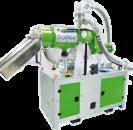


Farming | Muck & Slurry
UNRIVALLED EXPERIENCEAND EXPERTISEIN SLURRYAPPLICATION,MIXING, SEPARATION &PUMPING TECHNOLOGY AdrianTindall- UK&Ireland RobJackson- UK&Ireland 07708 919597 07939 410417 a.tindall@bauer-at.com r.jackson@bauer-at.com Plug&Play
MagnumSX
MTXH-L

to 9%, the PSS 8 achieves a throughput of up to 65cu m per hour, the moisture content or dryness of the extracted solids being varied by the number and position of counterweights using a patented output regulator.
Users can be confident of constant output and a highquality material: the dry matter content, once set, remains unchanged throughout the entire period of use, with up to 36% dry matter content in the solids achievable consistently.
Long service life, simple maintenance
Like the entire FAN product range, the PSS 8 is built from carefully selected materials, with the screw featuring wear-resistant reinforcement, and all parts that come into contact with the slurry being made of stainless steel to ensure an exceptionally long lifespan for the machine.
Thanks to the floating screen bearing and the associated continuous cleaning of the screen by the screw, the PSS 8 remains almost wear-free even over long operating periods., and good access makes routine maintenance quick and easy.
For a green tomorrow
With its large dimensions and increased throughput, a single PSS 8 can replace two or more smaller machines. Energy costs, space usage and labour in connection with operating the necessary peripheral equipment, such as pump stations, are all reduced. This saves time and money, decreases the environmental footprint and makes the PSS 8 an important ambassador for a green future.
The Bauer Group at a Glance
Since its foundation in 1930, the BAUER Groupheadquarters in Voitsberg, Styria, has been focused on irrigation and slurry management technology. Whilst initially producing wastewater and slurry pumps, the company first became an international player in the sector of irrigation technology in 1947 with the patent-protected Bauer lever lock coupling - named after Rudolf Bauer, the company founder. Today the company is developing rapidly in the biotechnology sector with wastewater treatment & biogas plants and it is focusing on three main sectors: irrigation management, waste water management as well as energy management.

BAUER is the Global market leader in irrigation technology: A total of more than 2.5 million hectares is globally irrigated. A major part of sales representing 50% of the total turnover is achieved in the sectors of slurry and environmental waste processing. The BAUER Group exports to about 100 countries of the world. With approx. 890 employees, Bauer generated consolidated net proceeds of about 245 million Euros in the financial year 2022/23. With an export ratio of 90%, the main markets of the BAUER Group are Germany, France, the CEE countries, China, the USA, Australia and South America. In October 2016 a new plant in Brazil was put into operation.
The BAUER Group currently consists of 16 companies worldwide, including the well-known German labels BSA, Eckart and FAN.
Product Range
• Various irrigation systems
Automated pivot and linear systems, i.e.: Centerstar, Centerliner, Linestar
Irrigation machines, i.e.: Rainstar, A3 or ProRain
Traditional irrigation, i.e.: pipe systems and solidset plants
SmartRain – App for managing and optimizing irrigation systems
• Slurry transportation (slurry tanks)
• Innovative slurry treatment: mixers,pumps, separators, composting and distribution
• Pipes and fittings
• Wastewater treatment and separation technology for the food and paper industry
• Components for Biogas plants
• BRU Bedding Recovery Unit
Internet Services
• Configuration of all machines
• Ordering of all spare parts
For further information see: www.bauer-at.com und www.fan-separator.de
Farming | Muck & Slurry
Retrofit part halves trailing shoe row spacing
Vogelsang has launched a new DoubleFlow linkage option for its trailing shoe slurry applicators that enables the operator to halve the row spacing from 25 centimetres to 12.5. This doubles the surface area coverage operators can achieve without affecting tractor forward speed.

“The DoubleFlow runner divides the drop hose into two outlets, using a Y shaped piece, which splits the row spacing when spreading liquid manure to enable operators to cover more ground with a narrower spreading belt,” says Vogelsang’s Andy Hayhurst.
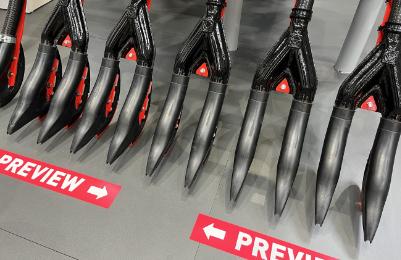
The new DoubleFlow trailing shoe part is easy to retrofit and can be added to the Vogelsang UniSpread and BlackBird trailing shoe linkages from May 2024.It has been designed to fit the flow optimised PrecisionFlow nozzle that existing Vogelsang customers will recognise from the BlackBird.
Mr Hayhurst suggests Vogelsang’s trailing shoe applicators are becoming more popular in the UK due to the PrecisionFlow spout used, which ensures precise slurry positioning.
“This is especially important on grassland to
improve forage quality and reduce the risk of slurry contaminating the green crop,” he adds.
The lightweight design of the Vogelsang trailing shoe applicators features a new runner design which is made from Hardox steel blades and wear-resistant plastic. This offers operators a hard-wearing and robust design that is easy to operate and maintain.
“The steel blades can be replaced individually. Operators will also benefit from the long service life of the applicators and low cost of spare parts,” concludes Mr Hayhurst.


Farming | Muck & Slurry
Vogelsang’s new Y shaped DoubleFlow part can be retrofitted to double the surface area coverage of a trailing shoe applicator.
The durable, lightweight, steel blade design is long lasting and places slurry accurately onto the soil to reduce crop contamination.
EFFECTIVE SPREADING SYSTEMS

Flexible, reliable and easy to maintain:
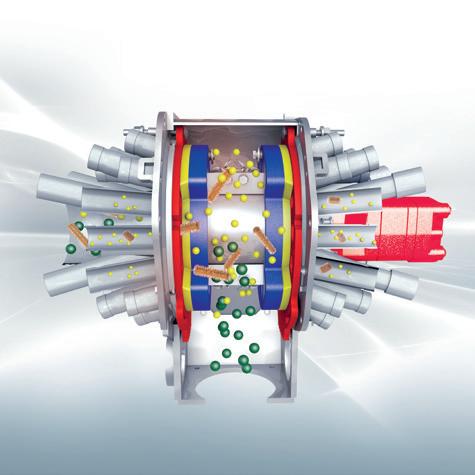
As a pioneer in agricultural technology, Vogelsang leads the way in environmental friendly spreading equipment. The dribble bar systems combined with the ExaCut distributor give the highest application of liquid manure nutrients.
Dribble bars are available in working widths of 7.5m right up to 36m and are retrofit-friendly.
For more information visit www.vogelsang.info/en-uk/dribble-bar-systems
VOGELSANG – LEADING IN TECHNOLOGY
Contact us at:
01270 216 600 | sales.uk@vogelsang.info
vogelsang.co.uk
Farming
A Slurry trials save farmer mucking about with grass growth

South-West dairy farmer has been trialling different rates of slurry and artificial fertiliser in silage fields to see how he can optimise yields and reduce costs. With input prices remaining high, John Kerr at Woodhead Farm in Ayrshire wanted to see if he could maximise use of the slurry from his 180-head dairy herd to improve soil health and grass growth, which would at the same time help reduce his carbon footprint.
John, who farms 141 hectares of predominantly grass in partnership with his mother Anne, said:
"Grass and slurry are our cheapest and easiest resources to produce on the farm and we wanted to make sure we have the basics right so we can tweak what we are doing at different stages to get the most out of both. Slurry may have traditionally been regarded as a waste product that we needed to get rid of, but we are now seeing it as a very valuable nutrient-dense asset."
It's a virtuous circle, he added: "If the slurry is used properly, the soil thrives, the grass grows well and we can make best use of our biggest asset, grass. We are also conscious of the pressure to produce with less impact on the environment, which all this also helps us to do."
Silage yield is affected by the pH and nutrient balance in the soil as well as the soil's structure, the weather and fertiliser application. The majority of the value of applying slurry comes from its phosphorus (P) and potassium (K) content, which is a high requirement for silage growth, but silage also needs nitrogen to yield. Although slurry contains Nitrogen, in a conventional system, much of the yield of grass is driven by applications of artificial fertiliser.
Like most dairy farms, Woodhead Farm applies slurry prior to each cut of silage using manufactured fertiliser to balance the N, P and K required. Running the trials with
Farming for a Better Climate (FFBC), an initiative run by SAC Consulting (part of Scotland's Rural College, SRUC), John has created four trial plots on the farm applying each with 2,500 gallons per acre plus differing amounts of artificial fertiliser as well as one with no fertiliser.
Woodhead Farm's slurry and soil was analysed at the start of the project and fertiliser was bought to rectify any deficiency.
As well as adding nitrogen to the soil through artificial fertiliser, the application method and timing influences nitrogen availability to the grass. By using a dribble bar with a flow meter and a tractor with autosteer (all part funded through a previous Scottish Government Sustainable Agriculture Capital Grant Scheme) accuracy of application is the key to success in terms of soil health.
"Where before accuracy was a challenge for slurry and fertiliser applications, it can now be done with ease with the system also keeping a record of applications, which is useful both for compliance but also for farm management purposes," explains SAC Consultant Robert Ramsay, who is working with John on the project. "By using the best application method at the correct time, nitrogen uptake is maximised, applications in the Spring achieve best utilisation of slurry nutrients. When it is applied between February and April, which coincides with the natural grass growth pattern, there is good nitrogen efficiency."
In the trials, the more artificial nitrogen that was applied, the silage yield was inevitably higher. However, that it's important to see costs and returns in the round rather than in silos, says Robert:
"These trials have given some valuable insights to help John make management decisions around his silage crops and allowed him to do a cost analysis per tonne of fresh grass for each scenario. It's important to look at it holistically. If you can reduce fertiliser applications by even a small amount, when multiplied
over many acres and several cuts, a significant saving can be achieved in your total fertiliser bill. Conversely, that extra load could fill the pit for much needed organic fertiliser which makes it worth the spend."
As a farmer himself, Robert says, the FFBC trials are deliberately farmer-friendly and can be replicated on any farm:
"We are often guilty of not challenging our systems or ourselves, but it's something we could all be doing. By checking whether the soil is limiting the yield potential or using data to inform nutrient applications, we can be savvier with where we spend and save. It is not about making major changes but small shifts: getting the soil analysed, asking some basic questions and trying out different rates across one field. The benefits for the environment will naturally come with these changes."
FFBC supports farmers to integrate pragmatic changes to reduce their environmental footprint as well as improve financial margins. This project at Woodhead Farm has highlighted the advantages of using more slurry to not only boost soil biology and the retention of nitrogen but the offsetting of synthetic inputs keeps emissions down.
The project has also raised other questions on where financial and environmental gains could be made. For example, could increasing yield save money on contractor costs and farm carbon emissions by cutting less acres? Could cutting less acres reduce pressure on grazing land allowing a stock increase or free up acres for another crop or reseeding? Would cutting less acres in later cuts help reduce the risk of soil damage from harvesting crops in variable weather conditions? Should we be collating information for nutrient management on a field basis rather than treating every field the same?
For more information see www. farmingforabetterclimate.org or follow the project on Facebook or Twitter @SACFarm4Climate
Farming | Muck & Slurry

KUHN introduces new VB 3200 series balers
KUHN Farm Machinery has introduced a new VB 3200 variable chamber baler range offering users 10% additional capacity and bale density compared to the outgoing models.

The new VB 3260 and VB 3290 models replace the VB 3100 series – VB 3160 and VB 3190 machines – and along with the increased capacity, the new models feature Progressive Density Plus to achieve 10% higher bale density. The VB 3260 can produce bale sizes from 0.8m to 1.6m, whereas the VB 3290 can reach bale diameters of 1.85m.
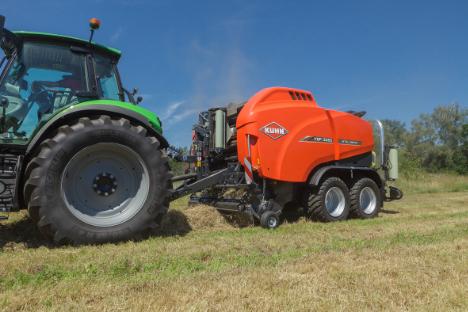
KUHN’s grassland product specialist, Rhodri Jenkins, explains where the new baler series fits in. “We have taken the proven concepts from the outgoing models and incorporated these into the new design along with innovative features to
increase output and bale quality. The range is aimed at customers requiring higher density bales and greater output in a variety of different crops throughout the season.”
A new heavy crop roller, with spring loaded tines

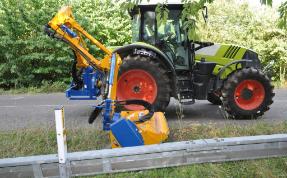

Farming
| Machinery
• BomfordHawk7T • ProportionalControls
PowerSlew
TelescopicOilCooler
4PointLinkageMouting
ElectricRotorReverse
1.5mProCutHead Bomford Kestrel 5.7 Power Plus Proportional Electric Controls Power Slew 1.2m Head Oil Cooler, 3 Point Linkage Mounted • BomfordKestrel5.7VFA • VariableForwardReach • PowerSlew,OilCooler • 3PointLinkageMounted • ElectricRotorReverse • 1.2mProTrimHead
•
•
•
•
•

for improved pre compression and crop flow, can increase overall efficiency of the baler by 10% compared with the previous generation. Further efficiency gains are provided by a quicker tailgate that ejects a bale in six seconds.
The Progressive Density Plus system is a pressure boost to provide higher bale density in dry crops. The density is increased by the hydraulic cylinders and spring tensioner increasing the resistance on the belts, while a belt tensioning arm provides an additional 10% when required. The baler can be operated via a tractor’s ISOBUS terminal, or through the VTI 60, CCI 800 or CCI 1200 Isobus screens. Non-Isobus machines are standard with the VT 30 control unit.
A reinforced driveline for improved longevity includes a stronger main drive chain, larger rotor drive chain, and additional reinforced bearings and seals for the high-capacity rollers. Users have the option of a non-cutting OPTIFEED rotor to provide an even swath flow as it enters the baler, for consistent bales. A 14- and 23-knife OPTICUT rotor, with each knife spring protected against foreign objects and providing a theoretical chop length of 70mm for OC 14 and 45mm for the OC 23, is also available. Both OPTIFEED and OPTICUT models benefit from an INTEGRAL ROTOR, offering greater throughput thanks to a shorter distance between the rotor and pick up
tines to provide consistent crop flow. As standard on both models is the DROPFLOOR, allowing the floor and knives to be lowered hydraulically to clear blockages.
The 3260 and 3290 models are also available in baler-wrapper combination units with the same new features as the standard models. Offering 15% quicker bale transfer times due to the increased tailgate speed, the VBP 3260 and VBP 3290 are also equipped with automatic unloading of straw bales in pairs and a hold-to-run button for the satellite wrapper rotation.
The hold-to-run button allows operators to rotate the wrapping arms by half a revolution to ensure the wrap is connected to the bale after fitting a new roll, while rotating the satellite arms allows film roles to be replaced from the same side. A new 3D Eco Wrapping system reduces the amount of film applied to the centre of the bale and ensures the bale edges are covered first to protect the most vulnerable parts of the bale.
Rhodri concludes: “The high-spec new models are reaching the UK in time for this season, and we are excited to see them working in UK crops. The changes will increase output and offer users more options in a variety of different crops with an enhanced driveline for increased longevity.”
Prices start at £51,820 RRP.
Farming
| Machinery
Kubota reveals two new engine solutions for OEM’s
Kubota has introduced two engine solutions suited to the OEM supply chain for agricultural and forestry sectors, including a 3.8 litre hydrogen engine, and its most powerful engine to-date, the 210hp V5009.

Kubota’s H2 hydrogen engine is based on its four-cylinder, spark-ignition WG3800 engine, and delivers a rated power output of 114hp (85kW) at 2,600rpm. It eliminates carbon dioxide emissions by only using hydrogen as a fuel.
The H2 hydrogen engine is expected to be an attractive choice within the agricultural sector and is already attracting major industry attention and awareness. One of the largest mobile generator manufacturers in the world and Kubota have already agreed on the development of a dedicated hydrogen generator equipped with a Kubota hydrogen engine.

2,200rpm. Meeting EU Stage V and EPA/CARB
Kubota’s V5009 is its most powerful engine todate. The 5.018-litre, four-cylinder turbo-diesel has a rated power output of 210hp (157.3kW) at

Tier 4 emissions standards, the V5009 has been engineered to satisfy the needs of industry and is suitable for forestry, agricultural applications and crop sprayers.
As an option for those customers who would usually require a larger six- or seven-litre engine, the V5009 power unit can now meet their higher power needs. With a high-power density, the V5009 includes a 100% power take-off at the flywheel and front end, a side-power take off with up to four hydraulic pumps and a choice of flywheel housing and flywheel for OEM coupling. Other features of the V5009, which has a direct injection combustion system and common rail fuel system, include a high-pressure supply pump, an optimised water jacket with heat resistance for the high-power rating and a ladder frame structure for noise reduction. Fuel consumption has been reduced by maximising the cylinder pressure and there is the benefit of a cold start capability of -30 °C and a 500-hour engine oil service interval (with standard heavy-duty usage).
LodgeFarm,BroughtonRoad,
Telephone:01455209300
https://www.sharnfordtractors.co.uk
Daniel Grant, manager marketing intelligence for Kubota Business Unit Engines Europe, said Kubota offers support, technological back-up and leading engine products to support every part of the agricultural sector.
“These latest engines underpin our determination to provide innovative solutions for the farming sector and this demonstrates our commitment to the wider environment through the use of carbon alternative fuels, said Daniel. “Because our new engines have the same footprint as existing models, the demands placed on maintenance and installation teams is greatly reduced. And with our engines being so compact we can offer enhanced power from the same machinery dimensions.”


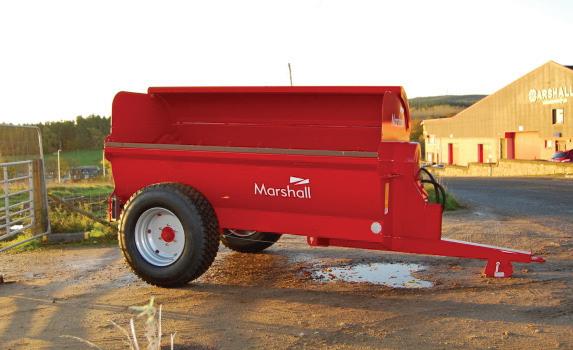

Farming |
Machinery
Formoreinformationcontact: SharnfordTractorsLtd
Frolesworth,Lutterworth, Leicestershire,LE175EH
TheARION600and500range-thenewmid-rangestandard Assistingyou,whereveritisneeded. Oneofourmostpopulartractorshasjustgotevenbetterthankstoahostofnew functionsdevelopedbyourengineersinconsultationwithARIONdrivers. Afterall,theyworkinthefieldeveryday,sotheyknowexactlywhattheywant.
https://www.claas.co.uk
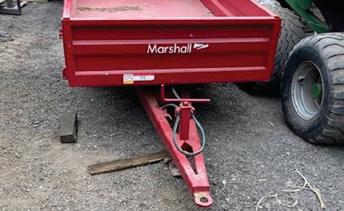


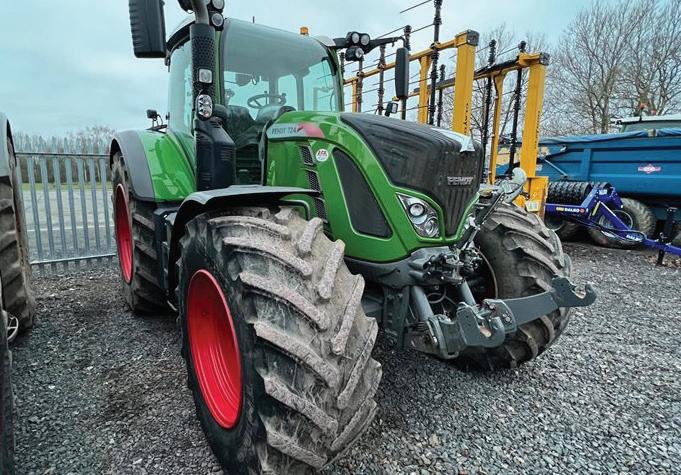
6423
Tyres:
710/50R42
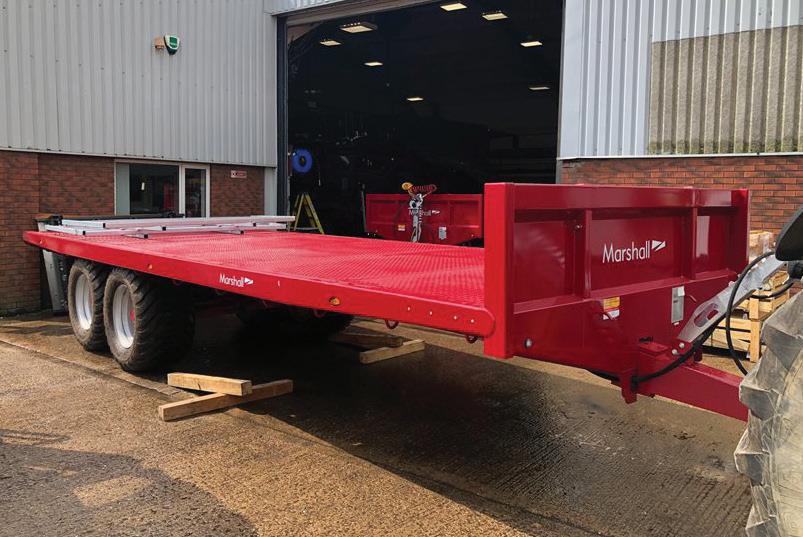
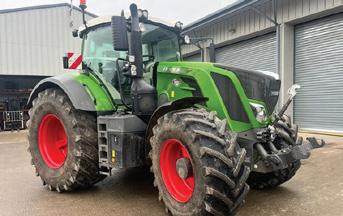
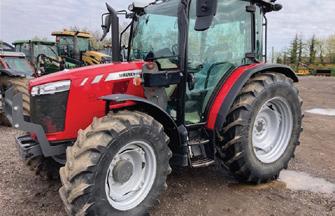
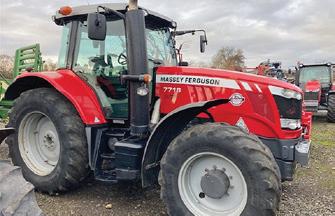

MF 7716 EFD6
2017, 4659 Hrs, 175 HP
Tyres:





VALTRA T214V ST
2019, 5947 Hrs, 210 HP
Tyres: 600/65R28 (100%)
650/75R38 (100%)



VALTRA T235D
2022, 1261 Hrs, 220 HP
Tyres: 600/65R28 (100%)
650/75R38 (100%)












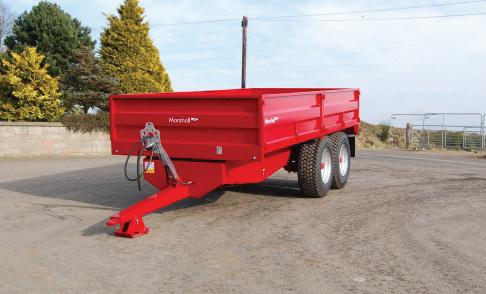

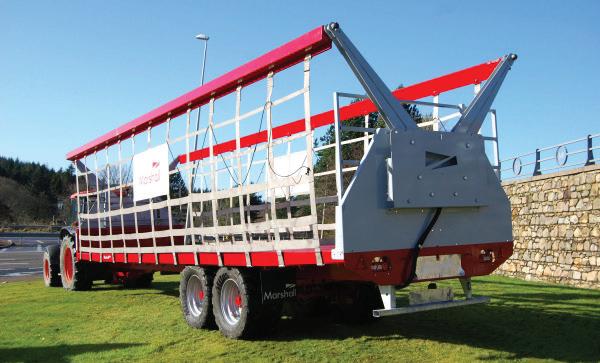


Farming Errors and omissions excepted. All prices +VAT NEW & USED STOCK www.chandlers.co.uk
724
FENDT
Hrs, 250 HP
600/60R30 (50%)
(50%)
Radar Fitted, VARIO Transmission, Profi+ Spec £99,750 +VAT MARSHALL BC25-12T BALE TRAILER 400/65R22.5 Tyre Equipment, Split Oscillating Suspension, Rear Tool Box, Sprung Drawbar £13,250 +VAT 2018 NEW MARSHALL TRAILERS - BUILT FOR TODAY, DRIVEN BY TOMORROW. CALL CHANDLERS AG SALES TODAY Graham Peall: 07970 121109 or Andrew Elms: 07860 464753 www.chandlers.co.uk SALES | PARTS | SERVICE MARSHALL S-2 TRAILER 2 Ton Tipping Trailer with Drop Sides £3,650 +VAT NEW FENDT 828 2100 Hrs, 280 HP Tyres: 600/70R30 (70%) 800/70R38 (70%) £155,000 +VAT 2022 VALTRA G125EA 2021, 127 Hrs, 115 HP Tyres: 440/65R28 (100%) 540/65R38 (100%) £68,750 +VAT 2021 500 HOURS 1000 LESS THAN MARSHALL S-2 TRAILER 2 Ton Tipping Trailer with Drop Sides £3,800 +VAT NEW MF 1709 CAB GLOBAL 2020, 1097 Hrs, 90 HP Tyres: 340/85 R24 (90%) 420/85 R34 (90%) £37,000 +VAT 2020 1500 LESS THAN HOURS MF 8S.205 EFD7 2022, 813 Hrs, 205 HP EFFICIENT Spec DYNA-7 Transmission £97,500 +VAT 2022 1500 1000 HOURS LESS THAN FENDT 720 2022, 332 Hrs,
Transmission £154,250 +VAT 2022 500 HOURS 1000 LESS THAN
Guidance Ready,
Tyres: (100%), Radar Vario Gen6
£54,500 +VAT 2017
480/65R28 (70%) 600/65R38 (70%
+VAT 2019
£79,500
£123,000 +VAT 2022 1500 LESS THAN HOURS
SIALGE
/ GRAIN
SPREADERS
DISCHARGE
DUMPER LIVESTOCK MUCK
REAR
DROP-SIDE
BALE
TANKERS FEED SCAN ME TO SEARCH USED MACHINES ONLINE
FLAT /
SLURRY
HAMBLYS is New Bobcat Dealer for Cornwall and Devon
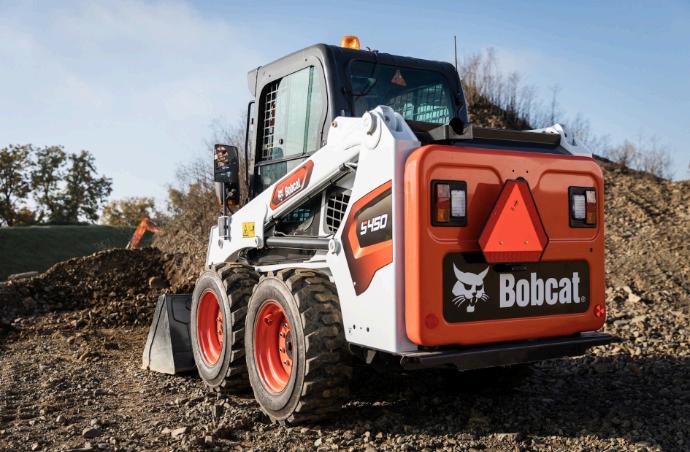
HAMBLYS Ltd., based in Launceston in Cornwall, has been appointed as the new Authorised Bobcat Dealer for the counties of Cornwall and Devon in South West England with immediate effect. HAMBLYS will also take over responsibility as the Authorised Bobcat Dealer for the West Somerset area from 1st July 2024.

John Christofides, Regional Sales Director for Bobcat EMEA, said: “HAMBLYS is a very professional business with an excellent reputation


in the South West. We are looking forward to working closely with them to increase the growth of the Bobcat brand in this area in every sector from our traditional markets in construction, rental and agriculture to the newer markets such as ground maintenance equipment.”
Steve Barrett, Managing Director of HAMBLYS, said: “We are very pleased to have been awarded the Bobcat franchise and to begin the next phase of our growth into the construction industry. We have recruited Lee Blewett as our Bobcat


Farming
| Machinery
Franchise Manager, who will lead our ‘NonAgricultural’ business development. He joins us with an excellent background in construction, and will be bringing extensive experience and knowledge to the new role to best serve our construction customers.”
As well as the Head Office in Launceston, HAMBLYS has another branch in Cornwall in Redruth, two further two branches in Devon at Honiton and Torrington and a fifth branch in Somerset at Bishops Lydeard. To support the Bobcat range of machines and attachments, HAMBLYS offers a full selection of genuine Bobcat accessories and parts in its area. Customers also benefit from HAMBLYS’ on-site service network, covering everything from emergency repairs to routine maintenance.
A Growing Product Range


The Bobcat range offers 10 skid-steer loaders including the brand new R-Series S86 model, complementing these wheeled machines with a selection of five compact track loaders, including the latest R-Series T86 top-of-the-range model. Bobcat also offers an extensive portfolio of miniexcavators from 1.0 to 9.4 tonne, including two electric models and a selection of rigid frame and rotary telehandler models.
In the last three years, Bobcat has also entered the
European wheel loader market for compact wheel loaders and small articulated loaders and launched an innovative line-up of ground maintenance equipment, including compact tractors, mowers and turf equipment. At the beginning of 2024, the company introduced a full line of forklifts and warehouse equipment, alongside a complete range of portable air compressors and electrical generators.
For more information about Bobcat and Bobcat products, visit www.bobcat.com
Avon Tuning HD increases technical support team

David Tripon has joined Avon Tuning HD as a technical sales engineer to support and expand the authorised agent network of agricultural installers.
The newly created role is part of a strengthening of the in-house Avon Tuning HD team to assist the wider agent network, that now has over 150 agents in the UK and Ireland. David joins Avon Tuning HD after working for Mercedes as a service technician on commercial vehicles.
In his new role, David will be working closely with Avon Tuning HD director, Gareth Jones, to facilitate technical training days for existing and new agents, visiting agent depots to support installs of professional remaps, advising on technical issues, and recruiting new agents.


where our network could be expanded.
David comments: “I’ve always been interested in remapping and the technical efficiencies it can offer users. The HD side of the business is growing fast and there is a lot of interest among farmers and contractors. Part of my role will be to support our agents to carry out remaps and identify new areas
“One of my main tasks is to maintain the personal touch Avon has created within its network. As the agent numbers continue to grow, this becomes harder, and we don’t want to lose sight of what it means to provide valuable support to our full network,” concludes David.
David will be based at Avon’s Bristol HQ, but will be regularly travelling to visit agents around the country.
Farming
| Machinery

Smart baling app wins Digital Innovation Award
Ben Davies, product manager at Krone UK, was presented the award at LAMMA by Alastair Tulloch, former deputy CEO of Claas UK, who praised the software for its simplicity and practicality.

Mr Tulloch says: “The app will make the lives of farmers up and down the country much easier, by being able to not only locate their bales, but more effectively sort them by moisture level to reduce spoilage when stored.”
The new SmartBale mobile app is compatible with Krone’s BaleCollect accumulator and SmartConnect telematics, simplifying the process of collecting bales from the field.
GPS tracking provides instant identification and location of specific bales, allowing swift coordination of operations in tight harvest windows.
Mr Davies explains: “The app also provides data on harvest conditions, bale origin, age, weight, and dimensions.
“This helps prioritise bale storage by moisture content and gives proof of quality between seller and buyer.”
SmartBale is compatible with any smart phone or table, making it possible to use the SmartBale app remotely or from any tractor or loader.
Farming
| Machinery

Farming | Machinery

Case IH Farmall 75C Electric and Steiger Quadtrac 715 Receive 2023 Good Design Awards
For over 70 years, the Chicago Athenaeum Museum of Architecture and Design and Metropolitan Arts Press Ltd. have presented the Good Design awards programme celebrating the yearly achievements of design excellence.

Case IH, a global leader in agriculture equipment, has been recognised as a 2023 Good Design® Award Winner for the Farmall 75C Electric and the Steiger Quadtrac 715 tractors. The award, presented by the Chicago Athenaeum, showcases global industrial innovation and cutting-edge
graphical designs.
"The principle behind the development of the Quadtrac 715 is not simply more power," says Franz Josef Silber, Case IH product marketing manager for high-horsepower and 4wd tractors. "Our aim was to create a machine that matches the requirements of our region's largest farms, to operate implements at their ideal speed, producing higher workrates and allowing operations to be performed at the ideal time, even in tough working conditions, to make the most of short weather windows. We also wanted to ensure soil protection via a bigger
footprint and fewer passes, which also means greater efficiency and minimal trafficked land."
Both the Farmall 75C Electric and Quadtrac 715 already boast awardwinning pedigree withFarm Machine 2024andASABE AE50 Awardsrespectively.
Farmall 75C Electric
Revealed publicly at Farm Progress Show 2023, the Farmall 75C Electric is Case IH's first fully electric tractor. Sporting a brandnew design with diesel-like performance and power, the tractor is designed for agriculture's toughest jobs.

Farming
| Machinery
The electrification of the Farmall coupled with the reduction in wear and tear on parts and maintenance costs, can provide users with a reduction in operating expenseswhen compared to diesel tractors. Offboard digital features and additional automation capabilities like Safety Mode let farmers operate the vehicle with far more efficiency.
Quadtrac 715
Launched in 2023, the Quadtrac 715 was created to fulfill the customer need of increased productivity. Case IH focused on addressing the customer pain point of how to increase productivity by pulling larger implements at faster
speeds while simultaneously enhancing the operator experience.
The most powerful Quadtrac tractor purposefully addresses this challenge delivering 778 peak engine horsepower, greater traction with reduced compaction, enhanced LED lighting to extend daily operations into the night, and a new hood that provides both improved service access and a signature new look that designates new levels of technology and

performance that Case IH strives to provides its customers.
"From Farm Machine 2024, to ASABE and now Good Design, Case IH is being recognised for the innovations we're making to serve farmers," added Silber. "Awards are nice, but we never stop at 'good enough'. Evolution is in our blood at Case IH, and we are honored to receive recognition from prestigious organisations like Good Design."
Farming
| Machinery
CLAAS XERION 12.650 TERRA TRAC awarded at Hungarian AGROmashEXPO
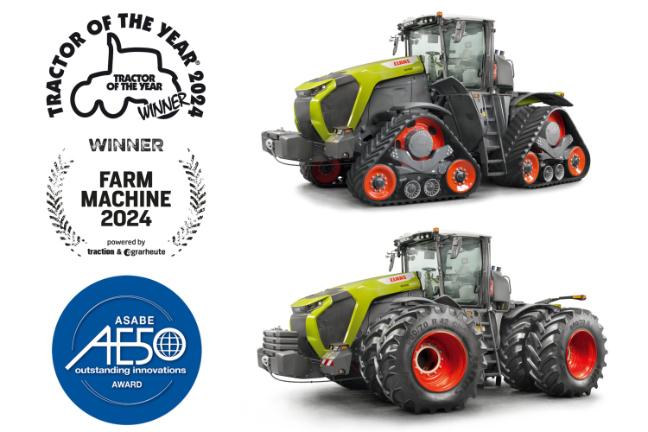
Harsewinkel/Baja, in January 2024. CLAAS and AXIÁL were delighted to win the Grand Prix in the “International Product Development” category at the Hungarian agricultural fair AGROmashEXPO in Budapest. The seed green award winner is the new XERION 12.650 TERRA TRAC, which not only sets new standards in its class in terms of comfort and efficiency.

It is the fourth award in a row for the new spearhead of the CLAAS tractor fleet: After Tractor of the Year 2024, Farm Machine 2024 (large tractor category) and AE50 Award, the XERION 12.650 TERRA TRAC has now received the Grand Prix in the “International Product Development” category at the AGROmashEXPO in the Hungarian capital Budapest. “It is absolutely extraordinary to receive four awards for a new product in such a short period space of
time,” says Dr. Martin von Hoyningen-Huene, Chief Technology Officer CLAAS Group and responsible for the Tractors and Implements division. “Thanks to its unique features, the large tractor sets benchmarks in many ways that help our customers work even more productively and efficiently while reducing the burden on the driver and the environment.“
CLAAS importer AXIÁL is also enthusiastic: “We introduced the XERION 12 series in the second half of 2023 and demonstrated it to the first customers in the field,” explains Zsolt Harsányi, founder of AXIÁL and spokesman for the owner family. “The feedback was consistently positive, both in terms of performance and pulling power as well as efficiency, comfort and driver assistance through CEMOS and digital technologies such as CEMIS 1200 with GPS PILOT. The AGROmashEXPO Grand Prix confirms the firstclass feedback from


Farming
| Machinery
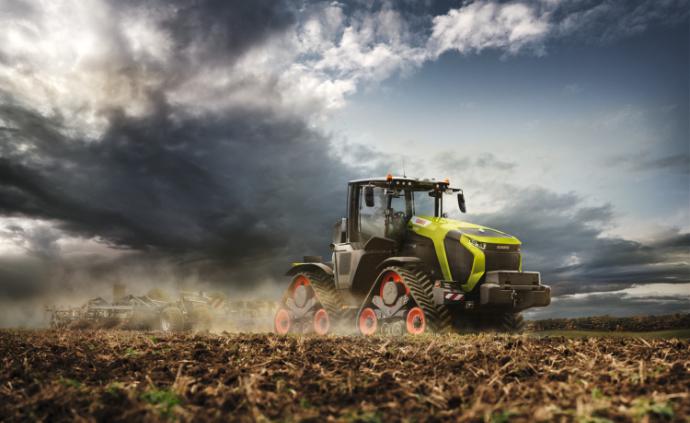
farmers and drivers and underlines the tractor’s convincing technological arguments.”
Successful start of production
The new XERION 12 series is positioned above the XERION 4200, XERION 4500 and XERION 5000 models, which are available as TRAC, TRAC VC and SADDLE TRAC variants (XERION 4200 only). After a successful start of production at the main plant in Harsewinkel, an initially limited
number of machines will be built this year and marketed in the core target markets. It will be introduced in other sales regions at the same time. “There is great interest in the new series,” explains Steffan Kurtz, Global Product Team Large Tractor. “After all, the XERION 12 series not only offers the most powerful four-wheel tractors with continuously variable transmissions on the market, but also sets new standards in this segment in terms of efficiency and comfort.”
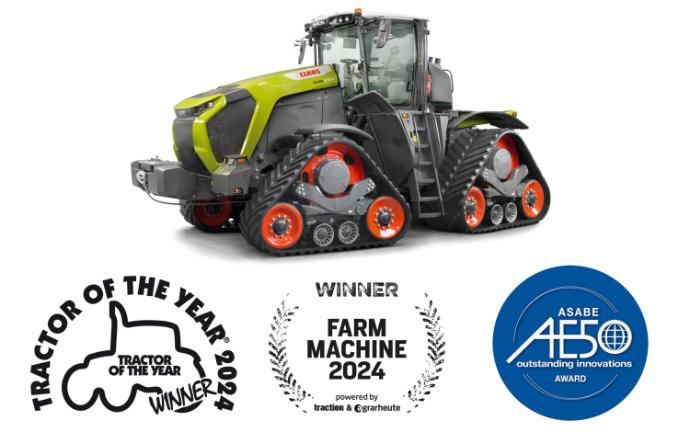
Farming
| Machinery
New variable chamber baler with film binding
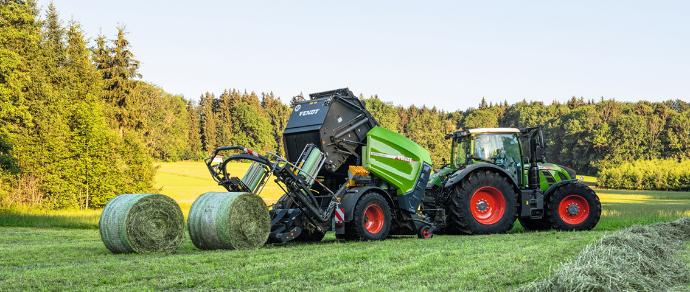
The Fendt Rotana 160 V Combi balerwrapper is now available with film binding and a variety of features which enable it to produce 30 more bales a day and save up to three metres of film per bale. The new model also features a quick-change system for film and net rolls as well as a‘Speed’ tailgate function. Fendt’s Ed Dennett explains:

“Film binding is already available for the fixedchamber, baler-wrapper combi machines.To offer variable chamber baler operators the same advantages, thistechnology has been transferred to variable chamber models of the Rotana.”
Using only film, the Rotana 160 V Combi reduces the air between the bale and the film. This reduces feed losses caused by mould formation and also protects the bale in freezing temperatures.
The arrangement of the rolls on a magazine enables a quick change between filmand net. This allows operators to quickly switch from silage to hay or straw bales and there is a choice between Eco Load and Comfort Load systems.
“Machines with Eco Load have a simple loading chute that requires a littlemore muscle power. With Comfort Load, the operator places the roll in a paddedcarriage, lifts it and guides it up to the quickchange system. A further benefit is that rolls can be loaded from the ground,” says Mr Dennett.


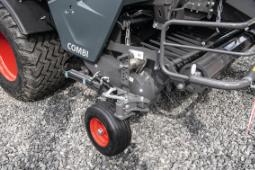
“Two gathering arms, and a shaft binding system specially developed for the variablepresses, guide the binding material into the baler chamber. Theshaft formation also protects the film from damage. An electromagnetic brakecontrols the pre-stretching of the net or film according to the binder and itsroll diameter,” says Mr Dennett.

An intelligent lever system makes it possible to switchbetween the three ready-to-tie rollers in a few simple steps. In addition, the easyoperation and padded contact surfaces prevent damage to the net or film.
The new model benefits from a faster ‘Speed’ tailgate capable of baling up to thirty more bales per day thanthe previous Rotana. Folding, self-steering, pick-up wheels can also be
specified on all Fendt Rotana Xtra and Combi machines. To make reversing the baler easier the pick-up wheels can be locked with a pin, an addition that will help operators baling on steep slopes.
Onlyone waste material is created with film binding and film is typically much less contaminated and, therefore, easier torecycle. Usage is also reduced compared to net and Fendt’s new film binding system can save upto three metres of film per bale.
For those looking to maximise forage quality, Fendt’s automated dry mass control will be a useful feature. Operators can select how much dry matter a bale should contain beforethe baling process. Two synchronously operating sensors in the bale chamber recordthe moisture and mass of the bales. From this, the software calculates the dry mattercontent during the baling process.
Farming
| Machinery
Tractor design wins 2024 German Design Award
The CNH Design team continues to elevate Ag equipment through creativity that challenges the traditional norms of the industry

Their efforts were recognized by the 2024 German Design Awards, presented by the German Design Council (est. 1953). The STEYR brand’s Plus tractor series was selected for Excellent Product Design in the Utility Vehicles category for its impressive synergy of function, design, quality and sustainability.

STEYR Plus tractors are the first to feature a dramatic new design language developed for the brand’s products. This sharp and crisp language emphasizes modernity, strength, power, and technology through features such as striking new
hood styling with integrated road and work lighting.
Inside the cab, additional comfort and better visibility complement the latest in telematics, which ease the operator’s task through instant data transfer from the machine to the cloud and auto guidance with automated steering.
“We are honoured to see our efforts to enhance the tech aesthetics of STEYR recognized by the German Design Council,” said David Wilkie, Design Director at CNH. “It underlines the importance of good design in delivering our customers a world class experience when they use our machines.”
Farming
| Machinery
When family tradition keeps pace with modernity: Herdade do Pigeiro’s success secrets
Run by Luís Bulhão Martins,
the Herdade do Pigeiro farm merges longestablished family tradition with modernity alongside a rising commitment to sustainability – values shared by BKT, a key partner for the Portuguese company.

Aperfect example of environmentfriendly development. In the heart of the picturesque town of Alandroal in the Alentejo region, a renowned production area for fine wines in Portugal, you can find Herdade do Pigeiro, a family-owned farm that has a long history of both tradition and innovation. Herdade do Pigeiro´s extraordinary evolution is setting the way for a sustainable future in the Portuguese farming sector. It is a virtuous example that BKT, a leading multinational Off-Highway tire manufacturer, sought to recount and highlight because of the shared values portrayed.

Herdade do Pigeiro's success began in World War II, a period in which the farm played a fundamental role in the community. The company's generous support outreached its fields, providing actually food and meals to local residents during times of shortage for several years. Its renowned practice of free-range pig farming has thus extended beyond Portugal, successfully expanding operations in Spain, and demonstrating its commitment to providing high-quality
products to the international market. This reputation has been fostered by the implementation of innovative irrigation systems, which cover nearly 30 percent of the land and leverage precise water management by means of sensors and automated controls. Diversification is another core aspect of the company, making the most of every plot of land to ensure that production efficiency is optimized. The focus lies on


Farming
| Tyres


production diversity, which is crucial for food security, especially against the backdrop of a growing world population.
Facing diversity, managing daily challenges, and adapting to climate change are necessities to which Herdade do Pigeiro responds in terms of modernization, business enlargement and staff training – determining elements for profitability and maintaining a competitive advantage. However, without neglecting the impact on the environment: for Herdade do Pigeiro, sustainability is driven by technology, which has enhanced and improved their farming processes, making them more efficient with a low environmental impact, while not compromising the food production quality.
It is a path of continuous evolution, led by Luís Bulhão Martins, CEO of Herdade do Pigeiro as well as an agricultural engineering enthusiast who has worked tirelessly alongside his family for more than four decades to supervise the company's operations and to ensure its success as we know it today. He is flanked by his son Afonso Bulhão Martins, General Manager, a source of innovation and evolution, and Bruno Pernas, Field Engineer who takes front-line experience to the fields.
This is a corporate vision that is shared by BKT, with which Herdade do Pigeiro has had an established relationship for more than five years. "We have chosen BKT tires because of their traction and load capacity. We use tires of different sizes and with different specifications, but BKT has such a wide product range that we always find the one that best suits our needs." says Luís Bulhão Martins. - "The tires belonging to the AGRIMAX range are those we use
the most. We actually fit them on all tractors and harvesting machines, as they perfectly adapt to our conditions and circumstances."
The main patterns in use include AGRIMAX FORCE, an ideal tire for high-power tractors and harvesters providing exceptional traction and ensuring minimal soil compaction; AGRIMAX RT 765, which is ideal for heavy operations and harvesting providing great grip and minimal compaction; and AGRIMAX TERIS, a tire that stands out for its reliability in combined operations, providing longlasting endurance even under challenging conditions.
"BKT tires offer outstanding traction and load capacity, ensuring superior durability and hence optimized operations without downtime. In agriculture, where timeliness is critical, having chosen BKT tires results in lower costs, and zero interruptions for tire or maintenance issues." explains Bruno Pernas. - "Their reliability in reaching crops promptly makes a big difference in a whole farming year and has a positive effect on the final harvest."
The partnership with BKT is thus a cornerstone of the farming company's success, representing a shared commitment to cutting-edge agricultural development, where technology supports efficient and sustainable resource management. Herdade do Pigeiro not only cultivates the land, but also has a vision: turning the job in the fields into a true-life commitment with a relentless focus on the wellbeing of both the environment and the community.


Farming
| Tyres
Bridgestone's VX-TRACTOR in big New Holland breakthrough



Bridgestone's agricultural team has made one of its biggest breakthroughs, securing fitment of its VX-TRACTOR tyre to over 50 New Holland tractors across seven Lloyd LTD agricultural branches in the north of England and Scotland, due to popular demand.

Bridgestone's critically acclaimed premium tyre –already chosen as Original Equipment option by the manufacturer – is now fitted to New Holland tractors at Lloyd Ltd Branches across Cumbria, Bishop Auckland, Newcastle, Dumfries and Kelso Branches.The VX-TRACTOR tyre – already approved for selected NH T6 and T7 Series tractors within the UK and Ireland – is now being seen on even moretractors, following positive feedback from farmers and contractors, leading to subsequent requests for the product.
An 'incredible' wear rate, greatfield performance and traction were all reasons given by Lloyd Ltd for the switch to Bridgestone, which has been a mutual development in the making.
Bridgestone's Agricultural Sales Manager John Morton said: "This is a big feather in our cap. New
Holland are a leading Agricultural Solutions Manufacturer in the world, so to develop this relationship in such a way is a big achievement.
"To see so many tractors on our brand is extremely rewarding. The VX-TRACTOR has been performing so well and we thank Lloyd Ltd for allowing us to fit the tyre to their fleet of T6 and T7 hire tractors.We have been able to fit the VX to over 50 tractors across the north of England and Scotland with Lloyd Ltd, and the exciting thing is that this figure will continue to grow."
Jonathan Bell, Lloyd Ltd Dealer Principal at Carlisle, said: "Our relationship has developed rapidly with Bridgestone. We couldn't believe the tyre wear rates we were seeing. Our customers are carrying out hundreds of hours of work and when we get the hire tractors back into our yard, the tyre wear is virtually zero. Obviously, this is great news for our customers and great news for us as a Business.
"The VX-TRACTOR offers incredible value for money, so it was an easy decision for us to make. Some of our customers are completing 8,000 to 9,000 hrs on this Bridgestone tyre before the need
Farming
| Tyres

to even think about a replacement.
Jonathan added: "Tyre choice has never been more important.
Customers are engaged, and aware of what is fitted like never before. They want good life, a cost effective product to run and a good overall performer in the field and on the road. Bridgestone has got that absolutely spot on".

The VX-TRACTOR is built to work both on the Road and in the Field, even under heavy payloads. It is constructed from robust casings with extradeep and extra-long lugs, ensuring outstanding traction and extremely long wear life. An increased six-layer tread belt protects against potholes and road debris. The tyre comes with a full 10-year warranty, telling Bridgestone's confidence in the product.
Confirming this very point is Lloyd Ltd customer Millers Contracting of Cumbria who's one happy customer, with the VX-TRACTOR meeting the needs of his road work.
Andrew Rowland – from Miller Contracting commented "We do a lot of road work and it has lasted ever so well, but more than this, it performs well in the field and provides comfort and control at
all times. Saving on costs is always a priority for a business like ours and the VX makes a big difference in this regard."
The tyre is also a smart sustainable choice, with its compound mix containing vegetable oils, replacing some of the petroleum-based oils in the production process. This gives greater resistance to wear, and to cutting and chunking to the tread area. An added bonus is fewer replacements are required over the life of the tractor, thus gaining cost saving as well as benefiting the environment. With this in mind, the VX TRACTOR embodies the company'sefforts to support the realisation of a sustainable society by providing social and customer value.
The Bridgestone E8 Commitment is at the heart of this and consists of eight focus areas – Energy, Ecology, Efficiency, Extension, Economy, Emotion, Ease and Empowerment – that guide Bridgestone's strategic priorities, decision-making and actions throughout every area of the business.
For more information about Bridgestone's VX TRACTOR tyre and range of agricultural solutions, visitAgricultural Tyres - Bridgestone United Kingdom
Farming
| Tyres
Polaris RANGER XP Kinetic: Premium and Ultimate models now available in Europe

Following the announcement of the arrival of the all-new RANGER XP Kinetic last year, Polaris has now announced that the first shipments of the Ultimate trim model have started, with both the Premium and Ultimate models now available at European dealerships.
RANGER XP Kinetic is available as a 3-seat model in Premium and Ultimate trim. The Premium trim contains a single 14.9 kWh lithium-ion battery that offers an estimated range of 45 miles (70 kilometres), whilst the Ultimate trim delivers double the battery capacity of 29.8 kWh with a higher estimated range of 80 miles (130 kilometres)* - ideal for longer days spent hard at work.


Convenient charging options are designed to fit specific customer needs and are as easy as plugging into a standard wall outlet. Whether customers are looking for an overnight charge, or a quick top off during the lunch hour, they are covered. XP Kinetic comes standard with a 1-

phase EVSE that allows riders to charge from a 240V outlet. Factory-installed on-board charging rate is 3kW for the Premium trim—reaching full charge from 0% in 5 hours—and 6kW for the Ultimate trim—reaching full charge in 10 hours, which can be reduced to 5 hours with peak charging**.
Peak charging requires a 3-phase (380V) outlet together with a 3-phase WallBox EVSE accessory, and along with the available 3kW on-board charging system (sold separately), rates can be boosted to 6kW for Premium and 9kW for Ultimate for up to 50% faster charge times.
Alongside all the premium features found in both model trims - like LED headlights, integrated dash switches and full-coverage front bumper fitted as standard - the Ultimate trim also offers a bright 18centimetre (7-inch) touchscreen infotainment screen powered by RIDE COMMAND technology, which offers configurable gauges to monitor ride activity. Pair that with the Ultimate’s added front and rear camera, riders can then see a full view of their surroundings - including other riders behind. Riders can also seamlessly pair the display via Bluetooth to wirelessly stream music and stay connected with call and text alerts.
A feature also seen on the petrol-powered Ranger XP 1000 model, ‘Plow Mode’ activation on the XP Kinetic Ultimate makes snow removal even easier by automatically lowering the plow when shifting into low gear ratio, and automatically raising the plow when shifting into reverse. It also features a handy ‘Back Drag’ mode for pulling snow away from buildings.
Farming | ATV
Capabilities and Performance
If you would like to know more information about ATVTrac get in touch. +44 (0) 1327 317 980 (Lines open 9am - 5:30pm) www.atvtrac.co.uk We can see your ATV, UTV, 4x4, Forestry Equipment & Machinery CAN YOU SEE YOUR ATV? WE CAN!


Manufactured at Polaris’ state-of-the-art facility in Opole, Poland, and engineered through Polaris’ exclusive 10-year partnership with Zero Motorcycles, the RANGER XP Kinetic features an all-electric powertrain that offers the most horsepower and torque ever found in a utility sideby-side. Not compromising on capability, the XP Kinetic can effortlessly tow up to 1,134kg and boasts an industry-best 680kg payload capacity, as well as a class-leading 35.5 centimetres of ground clearance and 25.4 centimetres of suspension travel to confidently rise over obstacles and smooth out the bumps.
With regenerative braking, electric power steering, on-demand all-wheel drive and VersaTrac Turf mode as standard, as well as three driving modes—ECO, Standard and Sport—riders are in complete control of their ride, depending on the terrain and task at hand.
Warranty
Thanks to being fully electric, the RANGER XP Kinetic features fewer moving parts for lower maintenance costs, and both Premium and Ultimate models are backed by a two-year total coverage warranty, three-year electric powertrain warranty, and five-year battery coverage***.
Availability
The following models are now available in dealers across EMEA – please confirm with your local market for specific regional homologations available:
• RANGER XP Kinetic Premium in Icy White Pearl (MD homologation)

• RANGER XP Kinetic Premium in Icy White
Pearl (Tractor T1a homologation)
• RANGER XP Kinetic Premium in Icy White
Pearl (Tractor T1b homologation)
• RANGER XP Kinetic Premium in Icy White
Pearl (ZUG/LOF homologation)
• RANGER XP Kinetic Ultimate in Icy White
Pearl (MD homologation)
• RANGER XP Kinetic Ultimate in Icy White
Pearl (Tractor T1a homologation)
• RANGER XP Kinetic Ultimate in Icy White
Pearl (Tractor T1b homologation)
• RANGER XP Kinetic Ultimate in Icy White
Pearl (ZUG/LOF homologation)
For availability and pricing in your market, please speak to your regional Media Contact or contact the Polaris EMEA Press Office at press@polarisorv.media
* Range estimates based on manufacturer data on typical customer driving usage and conditions. Actual range varies based on conditions such as external environment, weather, speed, cargo loads, rates of acceleration, vehicle maintenance, and vehicle usage.
** Charging times vary depending on the charging capacity of your battery system and the output capacity of the power supply, as well as the ambient temperature.

*** Warranty coverage period, terms and conditions may vary by market. Promotional powertrain warranty inclusive of 24-month factory warranty plus an additional 12-month warranty. Promotional battery warranty inclusive of 24-month factory warranty plus an additional 36-month warranty. The duration of this warranty may vary by international region based upon local laws and regulations.

For images of all European homologations, please visit the RANGER XP Kinetic product page.
Farming | ATV
Kawasaki Brute Force Enjoys Major Updates For 2024

The established benchmark for the maximum performance sector of the ATV market, Kawasaki's 750 cm3 V-Twin Brute Force has been significantly updated for 2024 with new – even more purposeful – looks plus an array of practical and welcome standard spec additions.

Undergoing its first major update in a number of years, the 2024 model retains the universally praised high-performance 750 cm3 VTwin engine and tough, durable chassis that has made it a longtime-success, bringing it up to date with new, more powerfullooking "tough & rugged" styling.

In terms of that distinctive new look, new fenders, a new grille, a new 3D emblem, and various carefully considered design touches throughout give the
machine an eye-catching, advanced yet unmistakable tough look that makes it clear this model is still at the top of its class ready to take on all challengers.

That enhanced equipment includes TFT colour instrumentation, all-LED lighting (including a new handlebarmounted LED light), furthering the Brute Force 750's evolution into a more modern adventure and hard working ATV offering sports ability along with all-dayworking utility features.
The clear, easy-to-read 11cm (4.3inch) high-grade full-colour TFT LCD screen sits at the centre of the handlebars, making it simple for the rider to see speed, odometer, and other relevant information while a new LED light mounted to the handlebars turns with the 'bars and is complemented by highly effective LED headlights. And
Farming • Southam Agri. Services For more information
| ATV


for people to see you forging ahead, red LED rear lights are also part of the new spec. In terms of that spec, the new Brute Force will be available in European Kawasaki ATV dealers for 2024 in either a distinctive Grayish Blue colourway or Camouflage with the "camo" model enjoying the additional benefit of handguards as standard fitment.
Refreshed too, the newly designed front and rear carriers feature compatibility with the
KQR (Kawasaki Quick Release) system while both include built-in tiedown points, while the rear plastic cover also incorporates antislip grooves to help keep loads in place.
Whatever the use – recreational or utility – the Brute Force owner is likely to spend many hours in the saddle, so electronic rider aids remain a core function with electrically selectable 2WD-4WD and the welcome assistance of electronic power steering while the ondemand front differential control makes directional changes plus tough climbs and descents precisely controllable.
With front disc brakes, and a fully enclosed rear brake plus double wishbone long travel suspension front and rear, the 2024 Brute Force has a standard spec that is the envy of the competition. Add an impressive inventory of tried and trusted genuine accessoriesplus that lusty work and play hungry water-cooled, fuelinjected, CVT equipped 750 cm3 V-Twin engine - and the 2024 Brute Force is set to fiercely protect its place as the default dominant leader of the ATV pack.
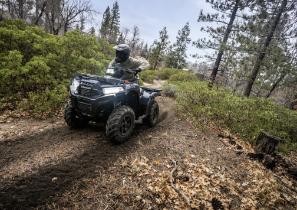






Farming
| ATV THE NEW For more information and to find your local Kawasaki dealer, visit WWW.KAWASAKI.CO.UK
This is Amarok


The new Amarok is finally here, making a clear statement for its drivers: All roads are the destination.
Fundamentally reimagined, the new Amarok defines the premium segment at Volkswagen Commercial Vehicles with its modern technology and redesigned styling.
No matter where or when, the new Amarok, equipped with its various modern driving assistance systems offers more support than any of its predecessors.
Its premium character is underlined by features such as ambient lighting1 and a top-end sound system from Harman Kardon2. As an outdoor companion, it stands out with improved off-road capability and optional V6 power. For those looking for a robust and reliable commercial vehicle, its broad variety of new features, such as the 3.5T towing capability for all automatic transmissions and other convenient details, are ready for any challenges. Whatever the requirements may be: The new Amarok meets them effortlessly.
This is Design
The new Amarok is defined by powerful contours in a completely revised Volkswagen Commercial Vehicles design. A slightly wider wheelbase provides a higher slope angle for improved off-road capability, and there is also a more rugged emphasis in the stance than in the predecessor.
The new Amarok comes with a cargo bed-load of remarkable highlights, such as modern "IQ.Light" LED matrix headlights1, optional wheels up to 21" in size2, completely new exterior styling packages with newly designed styling bars and steps.
The radiator grille, which - depending on the version - merges into a horizontal division of the front section or into an X-shaped design3, in the top trim levels, is another eye catcher.
Speaking of highlights, the loading area between the wheel arches offers enough space for a Euro pallet to be loaded crosswise and lashed in place thanks to the sturdy eyelets.


Farming | Motors


Another new feature is the roof load capacity of 350kg. Never before has it been possible to pitch a tent on a nicer surface.
Design features of the new Amarok:
• new radiator grille
• "IQ.Light" LED matrix headlights1, and LED taillights4,
• wheels 16"/17"/18"/20"/ 21"2, all-terrain tires up to 18"
• embossed Amarok lettering on the tailgate
The new Amarok Style
On-road or off-road, the new Amarok Style looks as good as it drives. The Amarok Style can take on any road. It doesn’t matter whether it’s being splattered with mud or winding its way through the urban jungle - the Amarok Style is at home wherever it goes.
Equipment features of the Amarok Style:
• 18-inch alloy wheels
• Rear bumper with chrome applications
• 10-way driver and passenger front seats
• 12-inch infotainment incl. touch display
The new Amarok Life
The new Amarok Life is a true off-road thoroughbred, and breezes through any terrain. Who said going off-road can’t be comfortable? The Amarok Life’s generous array of features makes it perfect for tackling even the biggest adventures.
Equipment features of the Amarok Life:
• 17-inch alloy wheels
• Colour-keyed front bumper, exterior mirrors and handles
• 8-way seats
• Heated exterior mirrors with surround lighting
This is Off-road
What makes the new Amarok a real thoroughbred off-roader? It offers the latest technology and more ride comfort than its predecessor, such as state-ofthe-art airbags and assistance systems.
With a range of body, chassis, engine or transmission variants, modified dimensions and the significantly greater fording depth, everything is designed for off-road capability.
Longer wheelbase
The new Amarok is 5,350mm long - 96mm longer than its predecessor. A wheelbase of 3,270mm corresponds to an increase of 173mm - which means there is more space in the crew cab. Since the wheelbase grows more than its overall length, the body overhangs are reduced. This adds to an increased slope angle and a better off-road capability.
An adaptable transmission
The new Amarok has the right answer for almost every driving situation. It also has the right transmission for almost every drive preference: from rear-wheel drive to selectable and permanent all-wheel drive. Three different diesels with four to six cylinders and 2.0 to 3.0 litres of displacement ensure the right strength development.
More driving modes, more driving comfort
The preconfigured driving modes are new and come in many variations to support drivers in special off-road situations in several stages. More than 25 assistance systems, over 20 of which are completely new on-board the Amarok, provide additional driving comfort on request.
Fording depth of 800mm
Thanks to an 800mm fording depth – 300mm more than its predecessor - off-road fans can now immerse themselves even more fully in the world of off-road capability.
Farming | Motors
Isuzu D-Max Utility review by CHRIS JOHNSON

It’s just a little over 10 years since the Dmax shocked the Pick-up market with its sleek looks, rugged capability and tremendous reliability…The lumpy pickup of old had been completely forgotten as the new kid on the block quickly became the Farmers Friend!
Roll forward and the figures don’t lie, with an ambition to register 10000 variants of the Dmax in 2025 the Company have gone all out in delivering high quality right from the base model.
When you think Utility, you think basic, you think rough around the edges, you don’t think comfort, driver aids but with an Isuzu you definitely should!
I am not too sure when “we” the buyers decided that we absolutely must have leather heated seats or tinted windows or super fandango alloy wheels…in fact I am not sure we ever really did ask, so the good people at Isuzu have obviously thought the same…what clever people to actually revert back to vinyl floor coverings that can be rinsed or wiped out once in a while, they’ve gone back to steel wheels, that are still round and still have tyres and that actually don’t make the pickup
look cheap oh and they’ve put in cloth seats that are warm and comfortable.
The Utility we had was manual with the addition of a diff lock bringing the on the road price to a shade under £30k, within that price you are still getting Bluetooth, USB, manual air con (what a treat to be able to turn a dial without trawling through multiscreens to find the climate page!) you are also getting a myriad of driver aides from hill start assist to lane departure prevention and trailer assist.
On the road the manual gearbox has a very low 1st gear, which you need to transverse through quickly but once on the fly the Dmax is swift, smooth and has plenty of power for A roads and Motorways alike, with cruising speeds comfortable and fairly quiet.
The steering is on point and all the steering wheel buttons easy to operate whilst driving along which is always a major plus, especially with big farmer hands!
There are lots of deep storage pockets for band and wire with further under seat storage for waterproofs or cartridges etc.
Farming | Motors
The Utility has an alarm with deadlock and an insurance approved immobiliser which is not always provided on other high end top brands, so you’ll stand a chance of being the only vehicle still in the Mart after a sale!
Off road the Dmax is bumpy, but a firm grip of the wheel and it’s no worse than topping the back paddock on the Fergie, the 4x4 system is shift on the fly so you can instantly grab that extra traction and flicking the rear diff lock should keep forward momentum.
So, in summary the Dmax Utility is all but a trim level, a level that does not really do it justice because it has a very high specification without all the bells and whistles and it remains one of the best value pickups on the market with excellent warranty and back up by dealers who know the brand and their customers inside out.
Pros:
• Value for Money
• Not at all Standard
• Reliable
• Dealers

Cons:
• Very Low 1st Gear
• A bit loud

Farming | Motors


Kia Sportage: ‘Best Family SUV’
For the second consecutive year, the Kia Sportage was awarded the ‘Best Family SUV’ award. The judges rated it ahead of all other rivals in one of the most popular and hotly contested classes in the UK.


The judging panel, made up of the magazine’s team of expert road testers, commented: “The Kia Sportage has a more comfortable ride than key rivals, yet it inspires confidence on winding roads, thanks to strong grip and accurate steering. You also get a smart-looking and user-friendly interior that offers a properly elevated driving position. And no matter where in the car you're sitting, there's plenty of head and leg room, and the Sportage feels pleasingly airy.”
The fifth-generation Kia Sportage was introduced early in 2022, and won What Car?’s ‘Best Family SUV’ award in 2023. Last year it was the UK’s fourth best-selling car overall, with 36,135 units finding homes with UK buyers. Offering a wide range of petrol, hybrid and plug-in hybrid options, the Sportage is priced from £29,375 on-the-road.
Kia EV6: ‘Best Family Electric SUV’
Two years on from winning What Car?’s overall ‘Car of the Year’ award, the Kia EV6 is still seen by many as setting the standard for EVs in its class.
The car has won the 2024 ‘Best Family Electric SUV’ award, ahead of several newcomers in an increasingly competitive segment.
The judges commented: “Two years after it was named What Car? Car of the Year, the Kia EV6 continues to blend a great battery range, fast charging, a fine ride and handling balance and generous equipment levels for a competitive price better than any rival. Plus, despite its sleek looks, it's a practical choice, offering loads of space in both the front and the rear, and a good-sized boot.”
The EV6 is priced from £45,275 on-the-road, and offers a driving range of up to 328 miles according to the WLTP ‘combined’ test cycle*. Drivers can choose between rear- or all-wheel drive models, as well as a high-performance EV6 GT model, which can accelerate from 0-to-62mph in just 3.5 seconds. The EV6 is a high performer in the UK’s growing EV sector, with more than 6,000 units sold in the UK in 2023.


Kia EV9: ‘Best Electric 7-Seater’
The all-new Kia EV9, on-sale in the UK since early January 2024, was also awarded the ‘Best Electric 7-Seater’ prize. A sub-category of the ‘Best 7Seater’ award, the EV9 was praised by the judges for its capabilities and value compared to rivals: “Most seven-seat electric SUVs are either ludicrously expensive or not as practical as you might expect, but the Kia EV9 is different, offering comfortable seating for seven adults in a package that –while far from cheap – is well priced next to rivals. And with a generous official range, the EV9 can tackle long trips without you having to worry about
Farming | Motors
K
where the next charge is coming from.”
The EV9 is now available to order in the UK, priced from £64,995 on-the-road and offering a comprehensive range of equipment, a bold and modern design, and the latest EV technology offered by Kia. The rear-wheel drive EV9 ‘Air’ is capable of travelling up to 349 miles on a single charge* (WLTP ‘combined’ cycle), while allwheel drive ‘GT-Line’ and ‘GT-Line S’ models can travel up to 313 miles on a single charge. Its 800-volt charging capability means the EV9 can harness high DC power to recharge its battery from 10 to 80 per cent in only 24 minutes.


Kia wins ‘Tow Car Award’ for its wide choice of towing-capable cars
Kia’s fourth trophy is the ‘Tow Car Award’, normally reserved for an individual vehicle, but this year recognising Kia’s wide range of towing-capable cars.
The judges commented: “What Car? and the experts at The Camping and Caravanning Club team up every year to find the best tow cars. However, instead of singling out an individual model, this year the judges felt that Kia as a brand was most deserving of the award for the way it consistently builds brilliant tow cars, whether you want a diesel, a hybrid or even a fully electric car.”
Several of Kia’s cars offer a high towing capacity, including the popular Sportage, Sorento, EV6, and – now – the EV9, the latter offering a braked towing capacity of up to 2,500kg in all-wheel drive, dual-motor format.
Paul Philpott, President & CEO, Kia UK, commented: “What Car? is one of the most trusted and reliable names for UK motorists, and recognition in the annual ‘Car of the Year’ awards is a powerful endorsement. We are therefore immensely proud to see three of our cars recognised as best-in-
class in 2024, and our wider model line-up for their towing capabilities. The Sportage in particular continues to be a top performer for families everywhere, while the award-winning EV6 and EV9 represent the benchmark in their respective segments as more buyers go electric for the first time.”
The What Car? Car of the Year Awards
Each year, the What Car? Car of the Year Awards names the best new cars across several vehicle categories. To be eligible for the awards, a car must have been tested back-to-back with its rivals, on UK roads and at a dedicated test facility, by What Car?’s team of road testers.


Farming | Motors

Hyundai Motor Europe makes its best-selling electric vehicle appear even sportier. It will be the first Hyundai EV to receive the sporty N Line treatment, further expanding the brand's customer-centric approach to delivering a wide range of options for drivers wanting to make the switch to all-electric mobility.
The Kona Electric N Line showcases a sporty and dynamic design, maintaining the car’s impressive performance and range. Customers who appreciate both style and sustainability – as well as the best-in-class interior space offered by the upscaled all-new Kona – can now further individualise Hyundai’s top-selling SUV.
N Line-specific design elements


• Dedicated EV N Line front and rear bumper
• Glossy black side mirrors
• Two-tone black roof (optional)
• Dedicated N Line steering wheel
• N Line exclusive metal pedals
Key features of the Kona Electric N Line include unique bumpers on both the front and rear, stylish side skirts, and a set of dedicated 19-inch wheels, designed to emphasise the sporty appearance of the model. The exterior is further adorned with exclusive N Line badging, underscoring the model’s bold look.
Inside the cabin, the Kona Electric N Line boasts sport seats with N Line logo and red contrast stitching, creating an immersive and dynamic driving environment. Additional red details on the steering wheel and dashboard contribute to the N Line's unique interior aesthetics. The focus is on providing a captivating driving experience without compromising on comfort and functionality.
N Line features:
• UK trims include N Line and N Line S
• More aggressive, sporty front and rear design
• Black headliner
• Dedicated 19-inch alloy wheels, N Line exclusive design
• Dedicated N Line seats with red contrast stitching
• Two seats available: N Line with Cloth or N Line S with Eco Alcantara & Leather combination
• Alcantara® special version with 57% of recycled polyester
UK customers can choose N Line or N Line S trims, with prices starting from £40,395 for the N Line 65kWh. The N Line boasts several bespoke styling features compared with the Advance and Ultimate, with a dedicated front and rear bumper design, side skirts, N Line design 19” alloy wheels, black gloss door mirrors, body coloured wheel arch inserts and an optional black roof. Interior changes include
Farming | Motors






aluminium pedals, N Line cloth interior with heated front and rear seats. In addition to bespoke styling, the N Line trim also introduces additional equipment including interior ambient lighting, heated steering wheel, wireless charging pad for compatible devices and power opening tailgate.
All-new KONA Electric customers wishing to optimise the sporty N Line trim even further can choose the N Line S, which starts from
£43,095 for the N Line S 65kW, which builds on the N Line with additional equipment including N Line Alcantara & leather trimmed seats that are both heated and ventilated, with electrical adjustability, dual zone climate control with rear air vents and BOSE premium sound system with 7 speakers and subwoofer. External enhancements for the N Line S feature the signature Full Width Horizon Centre daytime running light and full projection LED headlamps. As well as styling and equipment, N Line S also offers additional safety equipment, with Blind Spot Collision Avoidance Assist, Rear Cross Traffic Collision Avoidance Assist, Parking Distance Warning (side function), Parking Collision Avoidance Assist (reverse function), Safe Exit Warning and Surround View Monitor. Options for the N Line S include the Lux Pack with Electric Sunroof, Digital Key, Memory Driver's Seat, Premium Relaxation Front Seats, Remote Smart Park Assist and heated charging door, as well as Highway Driving Assist 2 and Forward Collison-Avoidance Assist 2.0 which adds Junction Crossing (JC) automatic braking if a risk of collision is detected with vehicles approaching from the side.
Scheduled to begin production in February 2024, the Kona Electric N Line is expected to hit European roads in spring 2024. The launch colour, Serenity White Pearl with a two-tone Abyss Black Pearl roof, sets the stage for a bold and stylish entrance into the all-electric SUV segment.
In a breakthrough move, Hyundai has ensured that the N Line treatment extends to every powertrain variant of the all-new Kona, making the Kona N Line a versatile and exciting option for a wide range of customers. Whether opting for combustion engine, hybrid, or all-electric, drivers can now enjoy the sporty and distinctive N Line features, setting a new standard for Hyundai's commitment to innovation and sustainability.
Farming | Motors

Subaru (UK) Ltd has expanded its SUV offering in the UK with the release of the new Crosstrek model. Replacing the outgoing Subaru XV, the Crosstrek is available in Limited and Touring trim levels with prices starting at £34,290 OTR and going up to £36,290 OTR for the range-topping Touring variant. Order books for this new model are now open, with demonstrator and showroom display vehicles available across the Subaru UK dealer network.
capability in a wider range of conditions. All models feature Incline Start Assist, which briefly holds the vehicle while the driver pulls away from a stop on a hill, along with Subaru Intelligent Drive with two selectable drive modes, Intelligent and Sport.
The versatile Crosstrek has 315-litres of boot area capacity with 60:40 folding rear seatbacks for added flexibility. With both seatbacks down, the cargo area can increase to 922 litres of usable space, whilst the wide rear gate opening offers a low lift-over height, allowing for easy loading and unloading. All models are also fitted with raised roof rails allowing for greater carrying options for more adventurous owners.
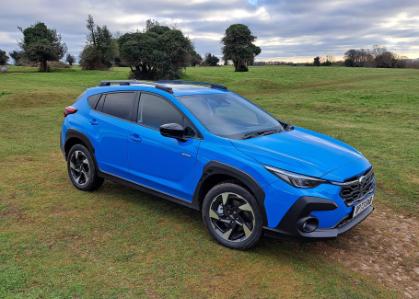

Adventure and Versatility
The Subaru Crosstrek has been designed around the concept of utility and sportiness that lends itself to an active lifestyle. The 220mm ground clearance for Crosstrek models is greater than that of many SUVs, yet it maintains a comfortably low step-in height for both front and rear passenger entry.
Standard across the range is a revised Subaru Symmetrical All-Wheel Drive system with a faster response time, more agile handling, and better control both on-and off-road. Driverselectable X-MODE® with Hill Descent Control maximises wheel control on slippery surfaces and steep inclines. Touring variants upgrade to dual-function X-MODE® for increased
All-New Exterior and Interior Design
The new exterior design communicates a ready-foradventure spirit with a new frameless hexagonal grille, compact headlights, a more sculptural body, and a broad-shouldered stance. Black wheel arch cladding and rocker panels provide a sharp contrast to the body colour. Limited models are equipped with 17-inch Diamond Turned alloy wheels whilst Touring models come with 18-inch Diamond Turned wheels in an alternative design.
Several functional aerodynamic improvements enhance the performance and stability of the vehicle. An air outlet at the trailing edge of the front wheel opening allows air to exit from the wheel well more freely, contributing to reduced lift on the front tires and improved driving stability. Another air outlet added at each side of the rear bumper reduces body sway due to air trapped behind the bumper.
The cabin benefits from an enhanced focus on the occupants and their interaction with the vehicle. A more supportive front seat design
Farming | Motors
increases overall comfort and minimises fatigue. A focused effort on reducing sounds within particular frequency ranges has resulted in a quieter and more comfortable cabin environment.
Finishing off the interior, the 11.6-inch high-resolution touchscreen, fitted as standard on all Crosstrek models, is equipped with wireless Android Auto™ & Apple CarPlay™ with a full-screen display. The onboard multimedia system also works as a centre information display with combination meter integration and on-screen controls for audio, climate, and vehicle functions. Additional features include Bluetooth handsfree phone and audio streaming connectivity, AM/FM stereo and DAB audio, and a rear vision camera.
Performance and Handling
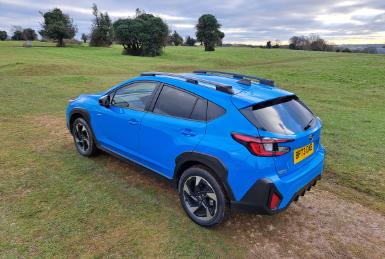

The Subaru Crosstrek is powered by the brand’s trusted 2.0-litre 4-cylinder directinjection SUBARU e-BOXER® engine producing 136ps and 182 Nm of torque 4000rpm, with a 0-62mph time of 10.8 seconds and a top speed of 123mph. Standard on all trim levels is a Lineartronic CVT (Continuously Variable Transmission) with smoother and quieter performance. Touring trim models also feature a manual mode with steering wheel paddle shifters that allow the driver to control the transmission via eight pre-set ratios.
The Subaru Crosstrek also benefits from a version of the brand’s dual-pinion electronic power steering rack, providing a more direct and natural steering feel and greater responsiveness.
Structure and Safety
The Subaru Global Platform for the Crosstrek has been enhanced with 10 per cent higher torsional rigidity. A full inner frame construction with stronger welding techniques and additional structural adhesive contributes to better body rigidity and less weight. These updates deliver an improved dynamic performance, smoother ride, and quieter cabin.
Standard on all Crosstrek models is the latest version of the award-winning EyeSight® Driver Assist Technology. The enhanced system operates more smoothly and quickly and under a
greater range of conditions. These improvements are thanks to a wider field of view, updated control software and the addition of an electric brake booster. EyeSight® can identify bicycles and pedestrians at junctions sooner and, when necessary, alerts the driver and applies braking to avoid collisions.
Automatic Emergency Steering is now included on models equipped with Blind-Spot Detection, Lane Keep Assist and Rear CrossTraffic Alert. This safety feature works with EyeSight® and Blind-Spot Detection to assist with steering control to help avoid a collision within a lane at speeds less than 50 mph. A Driver Monitoring System is also now fitted as standard to Crosstrek models, alerting the driver to any unusual and potentially dangerous activity whilst behind the wheel.
For total peace of mind, all Subaru Crosstrek models are covered by a 3-year / 60,000-mile manufacturer's warranty. Additionally, the traction battery for all Crosstrek e-BOXER models is covered by an 8-year / 100,000-mile warranty¹. Service intervals occur every 12,00 miles or 1 year, whichever arises first.


Farming | Motors

Potential safety risks and ‘limited’ savings for the UK’s motorists have been cited as the reason for the government’s decision to retain the current intervals between mandatory MoT test for cars, vans and motorcycles.
motorcycles from three to four years. Overall, 84% opposed changing the date of the first test. A high volume of concerns were raised in relation to road safety, in particular regarding tyre and brake wear - the most common reasons for first-time MOT test failures. These safety issues are particularly important

TyreSafe and 4,500 organisations responded to the MoT Consultation, which has now concluded, detailing the significant risks extending the first MoT for vehicles from three years to four or even five. DVSA figures show the most likely reason for a vehicle, up to six years of age, to fail its MoT is tyre defects.
Department for Transport (DfT) concluded: “The Government intends to maintain our exceptional record on road safety - with it being one of the best in Europe.
“The Department sought views about amending the date of the first MOT for cars, vans and
given the volume of anecdotal evidence that suggests that many drivers rely on the first MOT test to identify safetycritical issues.
“We agree with a number of respondents who identified that any savings made by motorists would at best be extremely marginal and limited by additional costs from defects not identified at MOT deteriorating and thereby requiring more expensive repairs (e.g. increased call outs for tyre defects), as well as increased insurance premiums. “
Neil Barlow, Head of Vehicle Policy at DVSA, said: “Ensuring the MOT remains fit for the
future is a key part of DVSA’s work and getting ready for new technology will help keep Britain’s roads safe. We hope, this positive news will provide some certainty for garages to enable the investment in new technologies that could be needed to keep the MOT at the forefront of road safety and the environment. DfT will also monitor technological developments that could require an altered MOT, such as advanced driver assistance systems.
Stuart Lovatt, TyreSafe Chair, said: “This is a very welcome announcement from the Department for Transport and we applaud them for listening to the views of road safety organisations such as TyreSafe for factoring in the risks posed to road safety in extending the first test to four years. While TyreSafe supports any initiatives which helps reduce cost to road users and minimise their impact on the environment, the DfT has rightly pointed out the ‘saving’ of an MoT test fee is marginal when compared to the potential costs driving with defects can have on people’s budgets.
“We look forward to continuing to work with both the DfT and DVSA on encouraging awareness of the importance of tyre safety and establishing a programme of longer term reform to modernise the MoT.”
Over 2 million cars fail their MOT each year due to tyre defects with over 1 million classified as ‘dangerous’.
Farming | Motors

UK vehicle production hit 1,025,474 units in 2023, according to the latest figures published today by the Society of Motor Manufacturers and Traders (SMMT). With 905,117 cars and 120,357 commercial vehicles (CVs) produced, output was up 17.0% on the previous year. The easing of pandemic-related challenges, from chip shortages to lockdowns, and increasing electrified model production, combined to drive annual output above one million for the first time since 2019.1
Strong December performances for both car manufacturing, up 20.7% year on year, and CV volumes, up 80.3%, rounded off a positive year, which saw a revival of the industry’s fortunes. Eight all-new cutting-edge models entered production in 2023, including at the newly reopened Ellesmere Port EV-only plant,2while some £23.7 billion of private and public investment commitments were made – more than in the previous seven years combined – from Cowley to Sunderland; gigafactories to R&D facilities.3
These commitments will drive green economic growth, create jobs nationwide and transition the sector to electrified vehicle manufacturing, which has already hit record levels in 2023. UKproduction of battery electric (BEV), plug-in hybrid (PHEV) and hybrid (HEV) vehicles surged to 346,451 units, up 48.0% on the year before to account for almost two fifths (38.3%) of overall output.
The EU remained by far the sector’s largest global market, taking 60.3% of exports, with shipments up almost a quarter (23.2%) to 430,411 units. The US was the next biggest destination with a 10.3% share of exports (73,571 units), followed by China with 7.2% (51,202 units), despite shipments to both slipping by -9.1% and -2.7% respectively. Turkey, conversely, saw exports surge 223.8% to 27,346 units, making it the UK’s fourth biggest global market ahead of Japan, Australia, South Korea, Canada, UAE and Switzerland.

all new electric models entered production, in Goodwood and Hethel, evidence of how electrification is being embraced by manufacturers right across the sector.
The sector also received a boost at the very end of 2023 with the deferral of tougher rules of origin for batteries and EVs traded between the UK and EU. The move will help safeguard the competitiveness of the sector in the UK and Europe, providing valuable time for local battery and associated component production to ramp up.
2024 is a pivotal year to make this happen but headwinds remain, most immediately with attacks on shipping in the Red Sea raising the spectre of delays and cost pressures. However, with the imminent threat of UK-EU rules of origin tariffs overcome, the latest independent outlook foresees UK car and light van output rising by around 3% in 2024 to 1.04 million units with the potential to exceed 1.2 million units by the end of this decade.
Overall, UKcar production rose 16.8% in 2023, its best growth rate since 2010, with the total retail value of all models made coming in at more than £50 billion.4While 191,247 cars were built for domestic buyers, the lion’s share of output was shipped overseas, evidence of the contribution automotive exports make to the UK economy. Year on year, exports rose 17.6% compared with a 13.7% rise in output for the British market.
Mike Hawes, SMMT Chief Executive, said, “Receding supply chain challenges, new model introductions and a massive £23.7 billion of investment put UK vehicle production firmly back on track in 2023. Industry will now focus on the delivery of these commitments, transitioning the sector at pace to electric and scaling up the supply chain. With global competition as fierce as it has ever been and amid escalating geopolitical tensions, both government and industry must remain singularly focused on competitiveness, with all the jobs and growth this will bring. We are in a much better position than a year ago, but the challenges are unrelenting.”
Despite challenging market conditions, British specialist, luxury and performance car makers had another bumper year, with combined volumes climbing 6.3% to 34,613 units, worth an estimated £7.1 billion.4Two high-performance
To achieve this, the UK must ensure it remains competitive, and so the forthcoming Budget is an opportunity for government to introduce measures that will boost the sector. These should include extending Climate Change Agreements so electric vehicle battery-manufacturing and its associated supply chain are eligible for relief; making green energy widely available and affordable; delivering on commitments to improve grid connections; and taking action to close critical labour and skills gaps.
Rapid delivery of the government’s Advanced Manufacturing Plan, full implementation of the Harrington Review recommendations, plus a trade policy that places automotive at the heart of all future negotiations would also help the UK consolidate its recovery and become a global leader in increasingly electrified vehicle production.
Farming | Motors


Dacia is giving customers even more freedom with the introduction of Dacia Flex, a new innovative finance product that minimises their commitment to long-term vehicle ownership.
Exclusively available on all versions of the current Duster, Dacia Flex builds on the convenience of a Personal Contract Hire (PCH) plan with the option for customers to end the lease after only six months.
For Duster enthusiasts, this means they could enjoy the robust and rugged current model now and then swap into the All-New Duster after it is launched later this year.
As with a PCH, there are no potential issues about owning or selling the vehicle, meaning that at the end of the term customers simply hand back the
keys to their Duster*.
It’s equally easy to get started. Once customers have chosen which trim and engine fits their needs, they can choose an advance rental, which is then followed by a monthly rental cost based on mileage and the length of the lease. The advance rental can be as little as one monthly payment and road tax is also included in the cost.
Luke Broad, Dacia Brand Director for the UK, said: “All-New Duster is certainly going to be worth the wait, but we know that some customers need a new car now. That’s why we’ve introduced Dacia Flex! It gives customers the best of both worlds. Now they can enjoy all the benefits of the current Duster and then switch into the new model later this year, all without the faff of selling a car.”
Farming | Motors

river appeal, competitive running costs –and the promise of top-quality backup from the Dealer next door –persuaded Browns Distribution to invest in its first MercedesBenz trucks.
The three Actros tractor units were supplied eStar Truck & Van, whose site on Chemical Lane, Stoke-on-Trent, is just metres away from Browns’ own premises.
They have joined a fleet dominated by two rival brands but, says Managing Director David Brown, an approach from eStar’s Truck Sales Consultant Ryan Lockett came at the perfect moment.
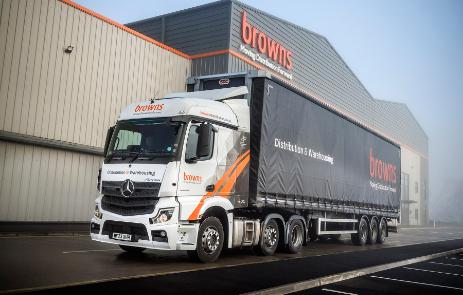
“Ryan’s timing was spot-on,” he recalled. “He couldn’t have known, but he got in touch just as we were considering changes to our fleet purchase policy. We took a demo truck from eStar for a couple of weeks and were impressed enough to decide we would include Mercedes-Benz in the mix.
“The demonstrator was handed to one of our most experienced drivers, who gave us some very positive feedback. The cab was clearly welldesigned and comfortable, the truck’s fuel returns were easily as good as anything else on our fleet, and overall it looked like a nice bit of kit.
“The most important thing with any vehicle, though, is its availability for work – uptime is everything,” he continued. “Having eStar’s round-the-clock workshop on our doorstep, and hearing the team

there make all the right promises regarding how they’ll back us up, made the decision to invest in Mercedes-Benz a ‘no-brainer’. We also took up the offer of a five-year Service Contract, at a highly competitive rate, which will make budgeting for running costs much more predictable.”
The trucks are Actros 2546 models, powered by 10.7-litre six-cylinder engines that each produce 340 kW (460 hp). They have aerodynamic StreamSpace cabs with 170 mm engine tunnels –chosen in preference to flat floors, as the lower driving position helps the vehicles meet Direct Vision Standard requirements for working in London. They are assigned to general haulage duties all over the UK, working with SDC curtainside trailers, and are typically away from home for one or two nights at a time.
Browns Distribution is a third-generation family firm with a proud history, but also never stops looking forward. The company only moved into its new Chemical Lane home last year, having invested a total of £9 million in creating a state-of-the-art storage and distribution facility. At the same time it underwent a thorough re-brand, and the MercedesBenz tractors are among the first fleet trucks to wear its smart new design.
“These are very early days of course, but all our initial impressions of these Actros units and of eStar’s support are very positive.” said David Brown. “The trucks look great in our colours and project a very professional image. We couldn’t be happier with our choice.”
brownsdistribution.co.uk
Farming | Motors
D


Volvo Cars had a recordbreaking year in 2023 and today reports the highest fullyear retail sales, revenues and operating profit in its 97year history.
A new alltime sales record of 708,716 cars enabled revenues to rise by 21 per cent to SEK 399.3 billion for the full year 2023. The underlying operating profit of SEK 25.6 billion, excluding joint ventures and associates, represents an increase of 43 per cent compared with 2022. The operating margin excluding JVs and associates came in at 6.4 per cent, up from 5.4 per cent in 2022.
“2023 was a key milestone in our transformation journey,” said Jim Rowan, Chief Executive of Volvo Cars. “We delivered a recordbreaking year on many levels, reporting the highest retail sales, revenues and profits in our company’s 97year history. We also took several significant steps forward in our ongoing transformation, while
navigating a complex external environment. In doing so, we’ve built a solid foundation for 2024 and the years ahead.”
The 2023 results demonstrate Volvo Cars’ ability to maintain premium pricing throughout the year, as well as solid demand for its cars and a robust orderbook, despite ongoing market turbulence.
The performance also demonstrates the strength of the company’s electrified product portfolio, which contains both electric cars as well as an extensive range of plugin and mildhybrid models. These hybrid models represented a significant majority of the company’s total global sales in 2023 and will remain a key element of its portfolio for the coming years.
The company sold 113,419 fully electric cars in 2023, an increase of 70 per cent versus 2022 and representing 16 per cent of its total global sales volume, which was one of the highest among all
Farming | Motors
legacy premium carmakers. Compared with 2022, Volvo Cars increased its global electric market share by 34 per cent.
Its electric sales share is still based on only two fully electric models and does not yet reflect the full potential of the new EX30 small SUV, EX90 large SUV or EM90 MPV, all of which will hit the roads in earnest during 2024.
During the second half of 2023, Volvo Cars also saw gross profit margins on its electric cars increase fourfold versus the end of 2022 to 13 per cent. High lithium prices heavily affected its margins in 2022, but the company saw a clear uptick in the underlying profitability of these cars from the second half of 2023 as lower lithium prices and the effects of increased pricing materialised. The company also benefited from efficiencies from its own investments.
While there is still a gap in gross margins on the EVs compared to some of its combustion engine (ICE) cars, this gap is closing. The EX30 is set to deliver gross margins of 1520 per cent and takes the company closer to that goal. Volvo Cars also expects the upcoming EX90 and EM90 to contribute to closing the gap between EV and ICE margins.
Looking ahead to 2024
2024 is set to be another big year for Volvo Cars as it continues to boost its product portfolio and accelerate its transformation towards becoming a fully electric car maker by 2030.
At the end of the fourth quarter of 2023, the first customers took delivery of the new EX30 small SUV. This year, Volvo Cars is focused on quickly ramping up production of this car and meeting the strong customer demand, which has exceeded expectations. The company is also working hard to add EX30 production to its Ghent plant in Belgium.
In the first half of 2024, the company will start production of its new EX90 flagship SUV, with customer deliveries starting soon after. The EX90 represents a significant technology leap with the introduction of Volvo Cars’ nextgeneration fully electric platform upon which the car is built.
As one of the first cars packed with core computing technology, the softwaredefined EX90 represents a significant paradigm shift for Volvo Cars. It is a car that brings nextgeneration safety, connectivity, data and software all together in one product, and reaffirms the company’s position as an industry leader in the ongoing technology transition.
The fully electric EM90 MPV, which Volvo Cars revealed in China in November, has also started production. Like the EX90, the EM90 is an important car for China and shows how serious the company is about succeeding in that market and taking market share.
Together, these three new fully electric cars will significantly expand Volvo Cars’ product offering around the globe and profitably take it into new demographics and market segments that it has not been active in before.
On top of that, Volvo Cars will refresh its plugin
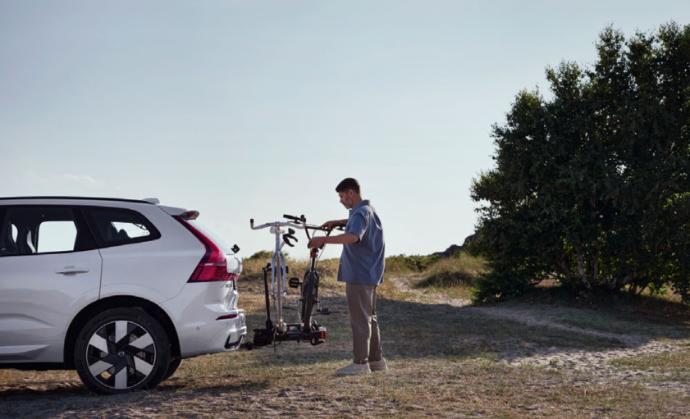
Farming | Motors

hybrid cars, which are an important bridge towards full electrification. Together with its fully electric cars, this creates a broad and attractive Volvo Cars portfolio for today’s global marketplace.
Volvo Cars expects this will boost growth from 2024 and will significantly increase its share of fully electric cars versus 2023. In addition, the new electric models will help it to further close the margin gap between electric cars and internal combustion engine cars in 2024. In terms of total 2024 retail sales, the company aims for a higher yearoveryear growth rate than in 2023.
and is the right one for Volvo Cars, our customers and the environment. Our results, order book and key performance metrics prove as much, and our customers clearly like what they see.”
A decisive transformation phase
Volvo Cars is now entering a decisive phase in its transformation journey. Not only will it continue to roll out and ramp up production of the EX30, EX90 and EM90 in 2024, but the company is also significantly ramping up other investments that will help it become a leader in nextgeneration mobility.
In the period up until 2025, Volvo Cars will make the necessary structural and strategic investments that lay the technical foundation for its future success: electrification, software, core computing architectures, advanced connectivity, data capture and analytics, mega casting, next generation emotor and battery technology, smart cabin technology, and a new advanced manufacturing facility.

This will mean a temporary rise in investment levels, yet these strategically crucial investments will drive significant cost efficiencies in Volvo Cars’ next generation of fully electric cars. They lay the foundation for further profitable growth and increased EV margins.
“It is my firm belief that the hard work we have put in during 2022 and 2023 positions us to meet our objectives for the years ahead,” said Jim Rowan. “Our strategy is well defined and unambiguous,
The company has a strong balance sheet supporting the transformative investments, with a liquidity position of SEK 75 bn as of yearend 2023, and during the investment phase in 202425 it expects the free cash flow generation to be relatively neutral.
From 2026 and onwards, Volvo Cars not only expects the level of investments to decline but to

Farming | Motors

reap the benefits of this strategy with higher growth and profitability. It will also at this point generate a strong positive free cash flow.
As the company accelerates its transformation, it will put even more emphasis on driving profitable growth over time and prioritising value over volume. It will double down on internal efficiency, ensure robust capital allocation across our business and capitalise on its phase one investments.
Polestar update
Polestar is entering the next exciting phase of its journey with a strengthened business plan and cost actions, added experience to its executive management team and board of directors, as well as the imminent rollout of Polestar 3 and Polestar 4. This combination positions Polestar well for future growth.
As we move into the next phase of our transformation, including deploying largescale investments in the creation and adoption of new technologies and futurefit production facilities, our focus is on developing Volvo Cars and concentrating our resources on our own ambitious journey.
We are therefore evaluating a potential adjustment to Volvo Cars’ shareholding in Polestar, including a distribution of shares to Volvo Cars shareholders. This may result in Geely Sweden Holdings becoming a significant new shareholder.
Geely will continue to provide full operational and financial support to Polestar going forward, and, as a result, Volvo Cars will no longer provide further funding to Polestar. We will, however, extend the repayment period for the existing convertible loan
by 18 months to the end of 2028. This will be subject to relevant approvals and further information will be provided in due course.
Volvo Cars’ and Polestar’s strong operational collaboration across R&D, manufacturing, aftersales and commercial will continue to the benefit of both companies.
Clarified ambitions
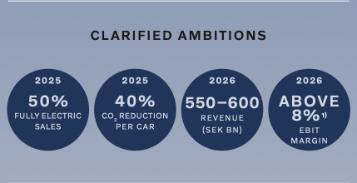
In light of these plans, Volvo Cars has decided to clarify its ambitions that were set out at its IPO. The company stands firm on its strategy around electrification and technological leadership, one of the most ambitious in the industry. Yet by clarifying its ambitions with sharpened metrics, it improves transparency and allows for a better followup on its progress.
The company remains firm on its ambition to report an EBIT margin above 8 per cent for 2026, and now do so based on expected revenues between SEK 550600 billion. This clarified ambition further underlines that Volvo Cars seeks to grow in terms of revenues and value rather than on volume alone, thereby focusing even more on profitable growth.
Farming | Motors


ARB, the preeminent Australian 4x4 accessories manufacturer, proudly introduces an expansive range of outdoor adventure accessories customised for the Isuzu D-Max. Catering to enthusiasts with a penchant for exploration, ARB's comprehensive line-up covers vehicle camping, off-roading, green laning, and various other off-road adventures.
Elevating the camping experience, ARB presents an array of rooftop tents, including the rugged ARB Esperance Roof Top Tent with Ladder (Hard Shell), the versatile ARB Flinders Roof Top Tent, and the spacious ARB Simpson III Roof Top Tent with Ladder & Annex. For ground-level camping enthusiasts, the ARB Swag Skydome Tent provides a cosy and convenient option. These tents seamlessly integrate with the popular ARB Ascent Hardtop Gullwing Canopy, now an official
accessory for the Isuzu D-Max.
ARB's commitment to enhancing the camping lifestyle extends to the Slide Kitchen, a fully fitted kitchen drawer set complete with a gas hob, sink, and additional drawers. For those seeking extended adventures, the ARB Zero Fridge Freezer ensures perishables stay fresh. To maximise the D-Max’s space, ARB introduces the Awning Room Deluxe, a versatile extension completed with a floor, transforming the vehicle into a comfortable and spacious retreat.
Venturing into remote locations demands reliable support. ARB's off-roading and green laning accessories include the indispensable Tred Pro Recovery Boards for overcoming challenging terrains, the Baserack & Cab Mount Kit for carrying extra equipment, and the comprehensive ARB Recovery Kit Weekender. This kit, featuring a snatch strap rated to 4.75 tonnes, shackles,




Farming | Motors


and leather gloves, is complemented by ARB Recovery Points, ensuring secure front-end recovery.
Isuzu and ARB joined forces in the middle of 2023, resulting in remarkable success. The collaboration generated sales totalling £124,000, with the ARB Ascent Canopy emerging as the top seller. This canopy, known for its excellent build quality and versatility, has captured the hearts of D-Max owners seeking durability and functionality.
Steve Page, Accessory Sales & Marketing Co-Ordinator at Isuzu UK, commented, "Our partnership with ARB has exceeded expectations. The accessories provided have proven to be of the highest quality, and Isuzu D-Max
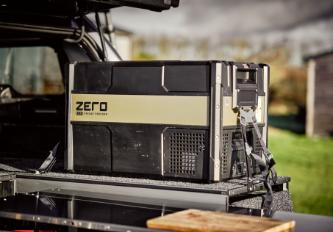

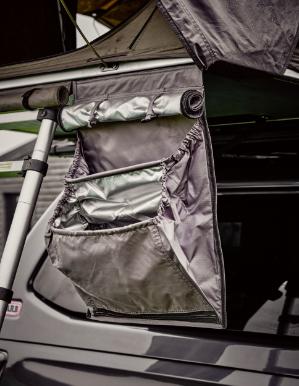

owners have embraced the versatility they bring to their outdoor adventures."
Established in 1975 in Australia, ARB has grown to become the largest manufacturer and distributor of 4x4 accessories. With a presence in over 80 countries, ARB's commitment to quality, reliability, and practicality remains steadfast.
As we approach Australia Day on January 26th, ARB invites outdoor enthusiasts to explore their range of accessories, celebrating the spirit of adventure and the rugged durability they offer. For more information, please visit www. isuzu.co.uk/accessories or www.arb4x4uk.co.uk.

Farming | Motors

Everrati Automotive Limited (Everrati™), the leading technology company specialising in the redefining and futureproofing of automotive icons through the integration of cutting-edge electric vehicle (EV) powertrains, has completed final winter testing of its first US commissioned Land Rover Series.
While the new vehicle will spend most of its life in a much more temperate area of North America, it has been fully signed-off by Everrati’s expert engineering team as part of an intensive cold weather programme in Vermont, New England, further underlining the company’s application of OEMgrade standards to the design, engineering, and quality of its products.
Over recent months, the first US commissioned Series IIA has undergone a rigorous validation programme, covering all components, with particular focus paid to the performance and reliability of its state-of-the-art OEM-grade electric powertrain. Encompassing high altitudes and cold weather, such as snow and extreme low temperatures, Everrati’s team ensured high-voltage reliability and tested charging functionality. Alongside hot weather testing, the team has now validated the vehicle for all climates.


Meticulously redefined as a cutting-edge EV, offering a unique blend of heritage, luxury
and sustainability, every Series IIA commission is first fully restored from the ground up, with Everrati then integrating its own e-powertrain, designed, and developed at its global headquarters in Upper Heyford, Oxfordshire, England. The result is a fully futureproofed vehicle fit for the 21stcentury which can drive in near silence and emission-free in any city across the globe.

Farming | Motors


Completing cold weather test in the US is the latest example of how Everrati is setting new standards, its Series IIA already passing electric vehicle safety testing in 2022, achieving UNECE R100.01 at the Netherlands Vehicle Authority – RDW, the only electrified classic of its type to do so in the world.
Justin Lunny, Co-Founder and CEO of Everrati said:“Everrati’s OEM-grade engineering, design, and quality processes continue to raise the bar in the electrified classic sector.The Land Rover Series, like all our models, represents the pinnacle of zeroemission icons and this latest example of our OEM-grade approach just underlines how we are going the extra mile in this rapidly growing market.
“Our redefined Land Rover Series IIA combines a complete restoration with the integration of our proprietary OEM-level


electric powertrain, preserving the vehicle’s legacy and enabling it to be enjoyed by generations to come. I can’t wait for us to hand over this first US customer commission to its new owner, who can be sure they are receiving the ultimate in redefined icons.”
With a 60kWh battery and 150bhp and 300 Nm from its electric motors, Everrati’s Land Rover Series IIA offers both twowheel drive and four-wheel drive modes and a range of up to 150 miles, almost identical to its combustion-engined past, combined with regenerative braking, AC and DC fast charging capability. The company now offers its Land Rover Series builds both 88” and 109”, and multiple roof configurations.
Combined with the very latest in sustainable luxury materials, including the world’s lowest
carbon leather for the automotive industry from leading leather manufacturer, Bridge of Weir, it further highlights Everrati’s overall mission for sustainable luxury.
The development of Everrati’s leading powertrain technology is supported by a robust network of extremely experienced and bestin-class partners and suppliers to deliver OEM-grade products, processes, and quality. Everrati’s leading portfolio of redefined automotive icons includes electric versions of the Porsche 911 (964) Coupe, Targa, Cabriolet and RSR-inspired edition, G-Series based STinspired edition, Range Rover Classic, Land Rover Defender, Land Rover Series, GT40, and Mercedes-Benz W113 SL ‘Pagoda’.
For more information, visit Everrati’s website at: www. everrati.com




Farming | Motors



All fuel consumption and emission values are based on the new WLTP (Worldwide Harmonised Light Vehicle Test Procedure) test cycle which uses real-world driving data. Official fuel economy for the standard Isuzu D-Max range in MPG (l/100km): Low 25.1 – 27.6 (10.2 – 11.2). Mid 31.4 – 36.4 (7.8 – 9.0). High 36.0 – 39.4 (7.2 – 7.8). Extra-High 29.0 – 30.8 (9.2 – 9.7). Combined 30.7 – 33.6 (8.4 – 9.2). CO2 emissions 220 – 241g/km. †Example based on 8,000 miles per annum, non-maintained. Subject to status. UK residents 18+. Rental amounts shown are on the specific model stated plus VAT @ 20%. This offer excludes fleet and Members Affinity scheme sales, is only available through participating Isuzu dealers and is not available in conjunction with any other offers or with BASC, NGO or NFU member discounts. This offer is only available through Lex Autolease Ltd trading as Isuzu Contract Hire, Heathside Park, Heathside Park Road, Stockport SK3 0RB. Offers may be varied or withdrawn at any time. Offer ends 31.03.24. Vehicle must be returned in a good condition to avoid further charges. No ownership option. If the vehicle has exceeded the maximum permitted mileage then a charge of 10.4p plus VAT @ 20% per excess mile will apply. The Award-Winning Isuzu D-Max is Smarter Stronger Safer compared to previous model. Terms and conditions apply. JEFFRIES OF BACTON Stowmarket, Suffolk JEFFRIESOFBACTON-ISUZU.CO.UK 01449 781 131 STARTIN TRACTORS Ashby Road, Twycross STARTINTRACTORS-ISUZU.CO.UK 01827 880 088 YORK VAN CENTRE Station Lane, York YORKVANCENTRE-ISUZU.CO.UK 01904 470 170 CULVERWELL CARS Robertsbridge, East Sussex CULVERWELL-ISUZU.CO.UK 01580 880 567 DUCKWORTH ISUZU London Road, Boston DUCKWORTH.CO.UK/ISUZU 01205 725 700 THE NEW-LOOK ISUZU D - MAX † Followed by 36 Monthly Rentals. Excess mileage charges and return conditions apply. BUSINESS CONTRACT HIRE FROM ONLY INITIAL RENTAL £3,285.00 + VAT @ 20% £365 MONTHLY RENTAL + VAT @ 20% Model pictured is a Isuzu D-Max DL20. Initial Rental of £3,285.OO + VAT @ 20%



























































































































































































































































































































































































































































































